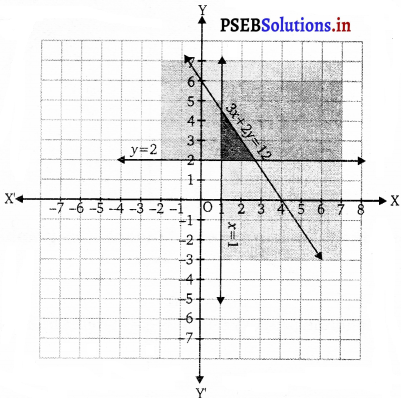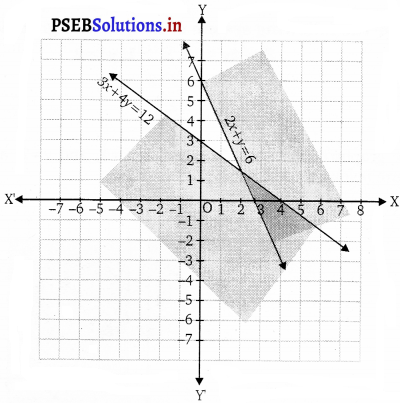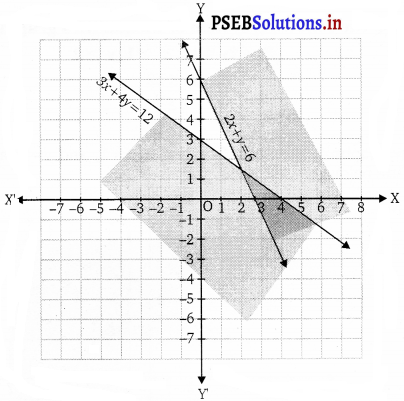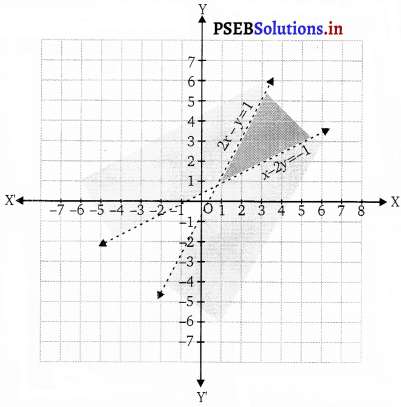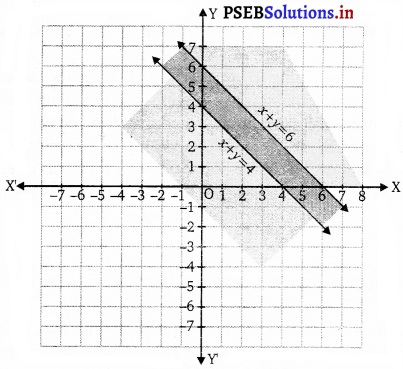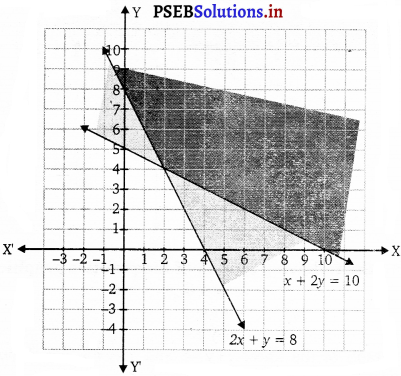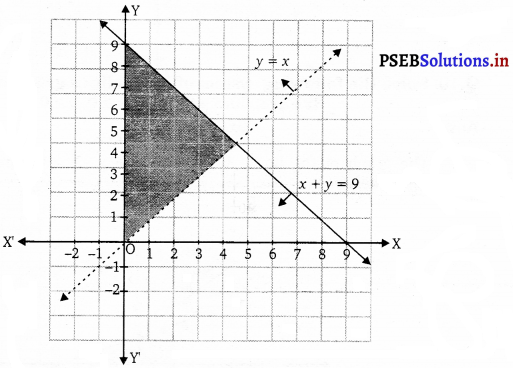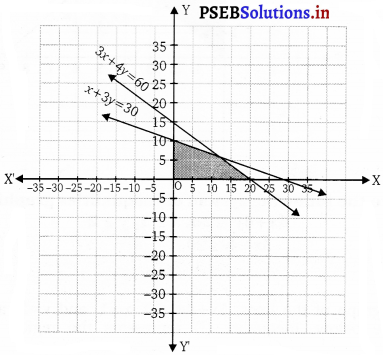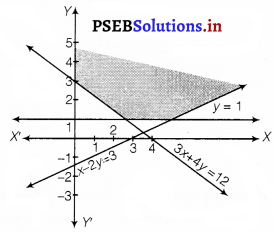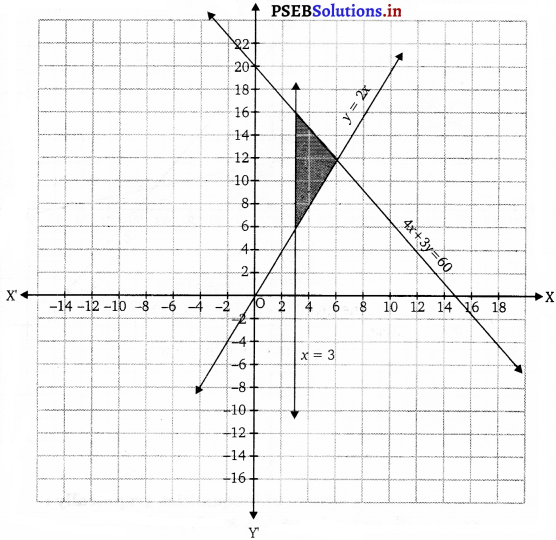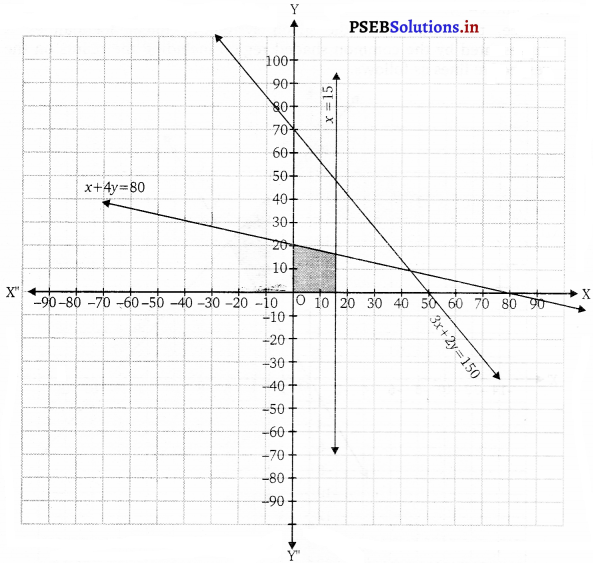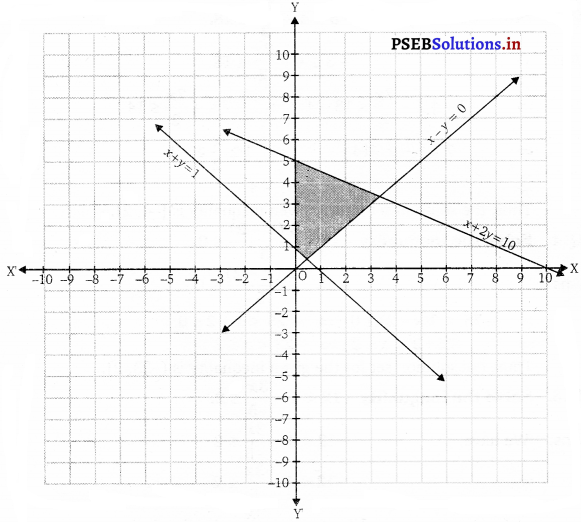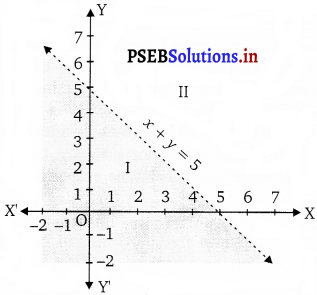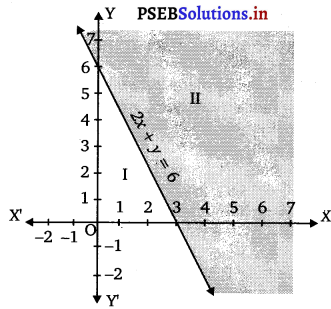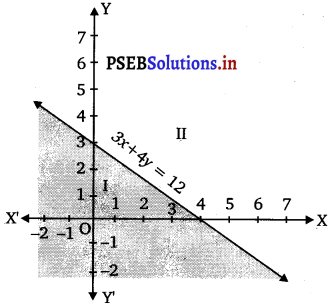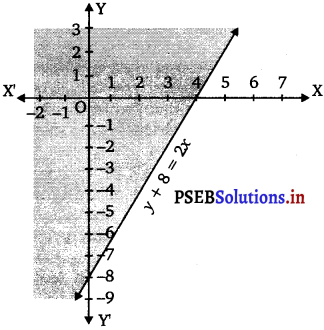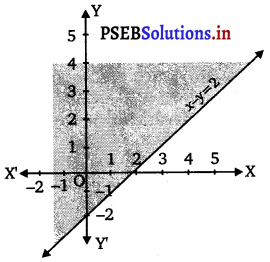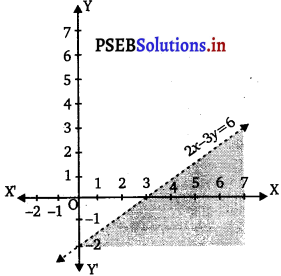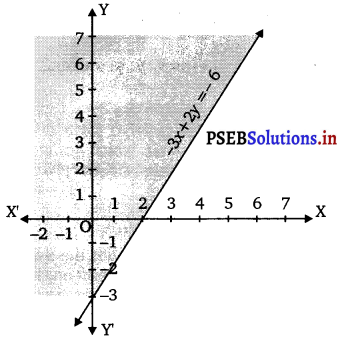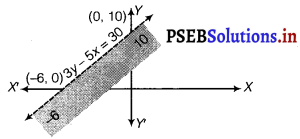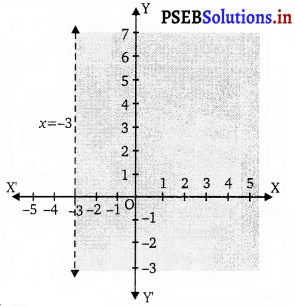Punjab State Board PSEB 11th Class Sociology Book Solutions Chapter 10 ਸਮਾਜਿਕ ਸਤਰੀਕਰਨ Textbook Exercise Questions and Answers.
PSEB Solutions for Class 11 Sociology Chapter 10 ਸਮਾਜਿਕ ਸਤਰੀਕਰਨ
Sociology Guide for Class 11 PSEB ਸਮਾਜਿਕ ਸਤਰੀਕਰਨ Textbook Questions and Answers
I. ਨਿਮਨਲਿਖਤ ਪ੍ਰਸ਼ਨਾਂ ਦੇ ਉੱਤਰ 1-15 ਸ਼ਬਦਾਂ ਵਿੱਚ ਦਿਓ ।
ਪ੍ਰਸ਼ਨ 1.
ਸਮਾਜਿਕ ਸਤਰੀਕਰਨ ਤੋਂ ਤੁਸੀਂ ਕੀ ਸਮਝਦੇ ਹੋ ?
ਉੱਤਰ-
ਸਮਾਜ ਨੂੰ ਅਲੱਗ-ਅਲੱਗ ਆਧਾਰਾਂ ਉੱਤੇ ਅਲੱਗ-ਅਲੱਗ ਸਤਰਾਂ ਵਿਚ ਵੰਡਣ ਦੀ ਪ੍ਰਕ੍ਰਿਆ ਨੂੰ ਸਮਾਜਿਕ ਸਤਰੀਕਰਨ ਕਿਹਾ ਜਾਂਦਾ ਹੈ ।
ਪ੍ਰਸ਼ਨ 2.
ਸਮਾਜਿਕ ਸਤਰੀਕਰਨ ਦੀਆਂ ਕਿਸਮਾਂ ਦੱਸੋ ।
ਉੱਤਰ-
ਸਮਾਜਿਕ ਸਤਰੀਕਰਨ ਦੇ ਚਾਰ ਰੂਪ ਹਨ ਅਤੇ ਉਹ ਹਨ-ਜਾਤੀ, ਵਰਗ, ਜਾਗੀਰਦਾਰੀ ਅਤੇ ਗੁਲਾਮੀ ।
![]()
ਪ੍ਰਸ਼ਨ 3.
ਸਮਾਜਿਕ ਸਤਰੀਕਰਨ ਦੇ ਤੱਤਾਂ ਦੇ ਨਾਮ ਲਿਖੋ ।
ਉੱਤਰ-
ਇਹ ਸਰਵਵਿਆਪਕ ਹੈ, ਇਹ ਸਮਾਜਿਕ ਹੈ, ਇਸ ਵਿਚ ਅਸਮਾਨਤਾ ਹੁੰਦੀ ਹੈ ਅਤੇ ਹਰੇਕ ਸਮਾਜ ਵਿਚ ਇਸ ਦਾ ਅਲੱਗ ਆਧਾਰ ਹੁੰਦਾ ਹੈ ।
ਪ੍ਰਸ਼ਨ 4.
ਜਾਗੀਰਦਾਰੀ ਵਿਵਸਥਾ ਕੀ ਹੈ ?
ਉੱਤਰ-
ਮੱਧਕਾਲੀਨ ਯੂਰਪ ਦੀ ਉਹ ਵਿਵਸਥਾ ਜਿਸ ਵਿਚ ਇਕ ਵਿਅਕਤੀ ਨੂੰ ਬਹੁਤ ਸਾਰੀ ਜ਼ਮੀਨ ਦੇ ਕੇ ਜਾਗੀਰਦਾਰ ਬਣਾ ਕੇ ਉਸਨੂੰ ਉਸ ਜ਼ਮੀਨ ਤੋਂ ਲਗਾਨ ਇਕੱਠਾ ਕਰਨ ਦੀ ਆਗਿਆ ਦਿੱਤੀ ਜਾਂਦੀ ਸੀ ।
ਪ੍ਰਸ਼ਨ 5.
‘ਕਾਸਟ’ ਸ਼ਬਦ ਦੀ ਉਤਪੱਤੀ ਕਿੱਥੋਂ ਹੋਈ ਹੈ ?
ਉੱਤਰ-
ਸ਼ਬਦ Caste (ਜਾਤੀ) ਸਪੈਨਿਸ਼ ਅਤੇ ਪੁਰਤਗਾਲੀ ਸ਼ਬਦ Caste ਤੋਂ ਨਿਕਲਿਆ ਹੈ ਜਿਸ ਦਾ ਅਰਥ ਹੈ ਪ੍ਰਜਾਤੀ, ਵੰਸ਼ ਜਾਂ ਨਸਲ ।
ਪ੍ਰਸ਼ਨ 6.
ਵਰਨ ਵਿਵਸਥਾ ਕੀ ਹੈ ?
ਉੱਤਰ-
ਪ੍ਰਾਚੀਨ ਭਾਰਤੀ ਸਮਾਜ ਦੀ ਉਹ ਵਿਵਸਥਾ ਜਿਸ ਵਿਚ ਸਮਾਜ ਨੂੰ ਪੇਸ਼ੇ ਦੇ ਆਧਾਰ ਉੱਤੇ ਚਾਰ ਭਾਗਾਂ ਵਿਚ ਵੰਡ ਦਿੱਤਾ ਜਾਂਦਾ ਸੀ ।
ਪ੍ਰਸ਼ਨ 7.
ਹਿੰਦੂ ਸਮਾਜ ਵਿਚ ਪੱਦਮਾਤਮਕ ਸਥਿਤੀ ਦੇ ਤਿੰਨ ਨਾਮ ਦੱਸੋ 1
ਉੱਤਰ-
ਪ੍ਰਾਚੀਨ ਸਮੇਂ ਦੇ ਹਿੰਦੂ ਸਮਾਜ ਵਿਚ ਚਾਰ ਵਰਣ ਸਨ-ਬ੍ਰਾਹਮਣ, ਕਸ਼ੱਤਰੀ, ਵੈਸ਼ ਅਤੇ ਨਿਮਨ ਵਰਣ ।
![]()
ਪ੍ਰਸ਼ਨ 8.
ਛੂਤਛਾਤ (Untouchability) ਤੋਂ ਤੁਸੀਂ ਕੀ ਸਮਝਦੇ ਹੋ ?
ਉੱਤਰ-
ਜਾਤੀ ਵਿਵਸਥਾ ਦੇ ਸਮੇਂ ਅਲੱਗ-ਅਲੱਗ ਜਾਤਾਂ ਨੂੰ ਇਕ-ਦੂਜੇ ਨੂੰ ਛੂਹਣ ਦੀ ਮਨਾਹੀ ਸੀ ਜਿਸ ਨੂੰ ਛੂਤਛਾਤ ਕਹਿੰਦੇ ਸਨ ।
ਪ੍ਰਸ਼ਨ 9.
ਕੁੱਝ ਸੁਧਾਰਕਾਂ ਦੇ ਨਾਮ ਲਿਖੋ, ਜਿਨ੍ਹਾਂ ਨੇ ਛੂਤਛਾਤ ਦੇ ਖਿਲਾਫ ਵਿਰੋਧ ਕੀਤਾ ਹੈ ।
ਉੱਤਰ-
ਰਾਜਾ ਰਾਮ ਮੋਹਨ ਰਾਏ, ਜਯੋਤੀਬਾ ਫੁਲੇ, ਮਹਾਤਮਾ ਗਾਂਧੀ, ਡਾ: ਬੀ. ਆਰ. ਅੰਬੇਦਕਰ ਆਦਿ ।
ਪ੍ਰਸ਼ਨ 10.
ਵਰਗ ਕੀ ਹੈ ?
ਉੱਤਰ-
ਵਰਗ ਲੋਕਾਂ ਦਾ ਉਹ ਸਮੂਹ ਹੈ ਜਿਨ੍ਹਾਂ ਵਿਚ ਕਿਸੇ ਨਾ ਕਿਸੇ ਆਧਾਰ ਉੱਤੇ ਸਮਾਨਤਾ ਹੁੰਦੀ ਹੈ; ਜਿਵੇਂ ਕਿਪੈਸਾ, ਪੇਸ਼ਾ, ਸੰਪੱਤੀ ਆਦਿ ।
ਪ੍ਰਸ਼ਨ 11.
ਵਰਗ ਵਿਵਸਥਾ ਦੀਆਂ ਕਿਸਮਾਂ ਦੇ ਨਾਂ ਲਿਖੋ ।
ਉੱਤਰ-
ਮੁੱਖ ਤੌਰ ਉੱਤੇ ਤਿੰਨ ਪ੍ਰਕਾਰ ਦੇ ਵਰਗ ਪਾਏ ਜਾਂਦੇ ਹਨ-ਉੱਚ ਵਰਗ, ਮੱਧ ਵਰਗ ਅਤੇ ਨਿਮਨ ਵਰਗ ।
ਪ੍ਰਸ਼ਨ 12.
ਮਾਰਕਸ ਦੁਆਰਾ ਦਿੱਤੇ ਗਏ ਦੋ ਵਰਗਾਂ ਦੇ ਨਾਂ ਲਿਖੋ ।
ਉੱਤਰ-
ਪੂੰਜੀਪਤੀ ਵਰਗ ਅਤੇ ਮਜ਼ਦੂਰ ਵਰਗ ।
![]()
II. ਨਿਮਨਲਿਖਤ ਪ੍ਰਸ਼ਨਾਂ ਦੇ ਉੱਤਰ 30-35 ਸ਼ਬਦਾਂ ਵਿੱਚ ਦਿਓ ।
ਪ੍ਰਸ਼ਨ 1.
ਸਮਾਜਿਕ ਅਸਮਾਨਤਾ ਕੀ ਹੈ ?
ਉੱਤਰ-
ਜਦੋਂ ਸਮਾਜ ਦੇ ਸਾਰੇ ਵਿਅਕਤੀਆਂ ਨੂੰ ਆਪਣੇ ਵਿਅਕਤਿੱਤਵ ਦੇ ਪੂਰੇ ਵਿਕਾਸ ਦੇ ਮੌਕੇ ਪ੍ਰਾਪਤ ਨਾ ਹੋਣ ਉਹਨਾਂ ਵਿਚ ਜਾਤ, ਜਨਮ, ਨਸਲ, ਰੰਗ, ਪੈਸਾ, ਪੇਸ਼ੇ ਦੇ ਆਧਾਰ ਉੱਤੇ ਅੰਤਰ ਹੋਵੇ ਅਤੇ ਵੱਖ-ਵੱਖ ਸਮੂਹਾਂ ਵਿਚ ਵੱਖ-ਵੱਖ ਆਧਾਰਾਂ ਉੱਤੇ ਅੰਤਰ ਪਾਇਆ ਜਾਂਦਾ ਹੋਵੇ ਤਾਂ ਇਸਨੂੰ ਅਸਮਾਨਤਾ ਦਾ ਨਾਮ ਦਿੱਤਾ ਜਾਂਦਾ ਹੈ ।
ਪ੍ਰਸ਼ਨ 2.
ਸਮਾਜਿਕ ਸਤਰੀਕਰਨ ਦੀਆਂ ਦੋ ਕਿਸਮਾਂ ਲਿਖੋ ।
ਉੱਤਰ-
- ਜਾਤੀ-ਜਾਤੀ ਸਤਰੀਕਰਨ ਦਾ ਇਕ ਰੂਪ ਹੈ ਜਿਸ ਵਿਚ ਅਲੱਗ-ਅਲੱਗ ਜਾਤਾਂ ਦੇ ਵਿਚਕਾਰ ਸਤਰੀਕਰਨ ਪਾਇਆ ਜਾਂਦਾ ਹੈ ।
- ਵਰਗ-ਸਮਾਜ ਵਿਚ ਬਹੁਤ ਸਾਰੇ ਵਰਗ ਪਾਏ ਜਾਂਦੇ ਹਨ ਅਤੇ ਉਹਨਾਂ ਵਿਚ ਅਲੱਗ-ਅਲੱਗ ਆਧਾਰਾਂ ਉੱਤੇ ਅੰਤਰ ਪਾਇਆ ਜਾਂਦਾ ਹੈ ।
ਪ੍ਰਸ਼ਨ 3.
ਜਾਤੀ ਵਿਵਸਥਾ ਦੀਆਂ ਦੋ ਵਿਸ਼ੇਸ਼ਤਾਵਾਂ ਦੱਸੋ
ਉੱਤਰ-
- ਜਾਤੀ ਦੀ ਮੈਂਬਰਸ਼ਿਪ ਜਨਮ ਉੱਤੇ ਆਧਾਰਿਤ ਹੁੰਦੀ ਸੀ ਅਤੇ ਵਿਅਕਤੀ ਯੋਗਤਾ ਹੋਣ ਦੇ ਬਾਵਜੂਦ ਵੀ ਇਸ ਨੂੰ ਬਦਲ ਨਹੀਂ ਸਕਦਾ ।
- ਜਾਤੀ ਇਕ ਅੰਤਰ-ਵਿਆਹੀ ਸਮੂਹ ਹੁੰਦਾ ਸੀ ਅਤੇ ਅਲੱਗ-ਅਲੱਗ ਜਾਤਾਂ ਵਿਚਕਾਰ ਵਿਆਹ ਕਰਵਾਉਣ ਦੀ ਮਨਾਹੀ ਹੁੰਦੀ ਸੀ ।
ਪ੍ਰਸ਼ਨ 4.
ਅੰਤਰ ਜਾਤੀ ਵਿਆਹ ਕੀ ਹੈ ?
ਉੱਤਰ-
ਅੰਤਰ-ਵਿਆਹ ਕਰਵਾਉਣ ਦਾ ਹੀ ਇਕ ਪ੍ਰਕਾਰ ਹੈ ਜਿਸ ਅਨੁਸਾਰ ਵਿਅਕਤੀ ਨੂੰ ਆਪਣੇ ਸਮੂਹ ਅਰਥਾਤ ਜਾਤੀ ਜਾਂ ਉਪਜਾਤੀ ਵਿਚ ਹੀ ਵਿਆਹ ਕਰਵਾਉਣਾ ਪੈਂਦਾ ਸੀ । ਜੇਕਰ ਕੋਈ ਇਸ ਨਿਯਮ ਦੀ ਉਲੰਘਣਾ ਕਰਦਾ ਸੀ ਤਾਂ ਉਸ ਨੂੰ ਜਾਤੀ ਵਿਚੋਂ ਬਾਹਰ ਕੱਢ ਦਿੱਤਾ ਜਾਂਦਾ ਸੀ । ਇਸ ਕਰਕੇ ਸਾਰੇ ਆਪਣੇ ਸਮੂਹ ਵਿਚ ਹੀ ਵਿਆਹ ਕਰਵਾਉਂਦੇ ਸਨ ।
ਪ੍ਰਸ਼ਨ 5.
ਸ਼ੁੱਧਤਾ ਅਤੇ ਅਸ਼ੁੱਧਤਾ (Pollution and Purity) ਤੋਂ ਤੁਸੀਂ ਕੀ ਸਮਝਦੇ ਹੋ ?
ਉੱਤਰ-
ਜਾਤੀ ਵਿਵਸਥਾ ਦਾ ਕੂਮ ਪਵਿੱਤਰਤਾ ਅਤੇ ਅਪਵਿੱਤਰਤਾ ਦੇ ਸੰਕਲਪ ਨਾਲ ਜੁੜਿਆ ਹੋਇਆ ਸੀ । ਇਸਦਾ ਅਰਥ ਹੈ ਕਿ ਕੁੱਝ ਜਾਤਾਂ ਨੂੰ ਪਰੰਪਰਾਗਤ ਰੂਪ ਨਾਲ ਸ਼ੁੱਧ ਸਮਝਿਆ ਜਾਂਦਾ ਸੀ ਅਤੇ ਉਹਨਾਂ ਨੂੰ ਸਮਾਜ ਵਿਚ ਉੱਚਾ ਦਰਜਾ ਹਾਸਲ ਸੀ । ਕੁੱਝ ਜਾਤਾਂ ਨੂੰ ਅਸ਼ੁੱਧ ਸਮਝਿਆ ਜਾਂਦਾ ਸੀ ਅਤੇ ਉਹਨਾਂ ਨੂੰ ਸਮਾਜਿਕ ਵਿਵਸਥਾ ਵਿਚ ਨੀਵਾਂ ਦਰਜਾ ਦਿੱਤਾ ਗਿਆਂ ਸੀ ।
![]()
ਪ੍ਰਸ਼ਨ 6.
ਉਦਯੋਗੀਕਰਨ ਅਤੇ ਸ਼ਹਿਰੀਕਰਨ ਤੇ ਛੋਟਾ ਨੋਟ ਲਿਖੋ ।
ਉੱਤਰ-
ਉਦਯੋਗੀਕਰਨ ਦਾ ਅਰਥ ਹੈ ਦੇਸ਼ ਵਿਚ ਵੱਡੇ-ਵੱਡੇ ਉਦਯੋਗਾਂ ਦਾ ਵੱਧਣਾ । ਜਦੋਂ ਪਿੰਡਾਂ ਤੋਂ ਲੋਕ ਸ਼ਹਿਰਾਂ ਵੱਲ ਨੂੰ ਜਾਣ ਅਤੇ ਉੱਥੇ ਰਹਿਣ ਲਗ ਜਾਣ ਤਾਂ ਇਸ ਪ੍ਰਕ੍ਰਿਆ ਨੂੰ ਸ਼ਹਿਰੀਕਰਨ ਦਾ ਨਾਮ ਦਿੱਤਾ ਜਾਂਦਾ ਹੈ ਉਦਯੋਗੀਕਰਨ ਅਤੇ ਸ਼ਹਿਰੀਕਰਨ ਦੀ ਪ੍ਰਕ੍ਰਿਆ ਨੇ ਜਾਤੀ ਵਿਵਸਥਾ ਨੂੰ ਖ਼ਤਮ ਕਰਨ ਵਿਚ ਬਹੁਤ ਮਹੱਤਵਪੂਰਨ ਭੂਮਿਕਾ ਨਿਭਾਈ ਹੈ ।
ਪ੍ਰਸ਼ਨ 7.
ਵਰਗ ਵਿਵਸਥਾ ਦੀਆਂ ਦੋ ਵਿਸ਼ੇਸ਼ਤਾਵਾਂ ਦੱਸੋ ।
ਉੱਤਰ-
- ਹਰੇਕ ਵਰਗ ਵਿਚ ਇਸ ਗੱਲ ਦੀ ਚੇਤਨਤਾ ਹੁੰਦੀ ਹੈ ਕਿ ਉਸਦਾ ਪਦ ਜਾਂ ਸਨਮਾਨ ਦੂਜੀ ਸ਼੍ਰੇਣੀ ਦੀ ਤੁਲਨਾ ਵਿਚ ਵੱਧ ਹੈ ।
- ਇਸ ਵਿਚ ਲੋਕ ਆਪਣੀ ਹੀ ਸ਼੍ਰੇਣੀ ਦੇ ਮੈਂਬਰਾਂ ਨਾਲ ਗੂੜੇ ਸੰਬੰਧ ਰੱਖਦੇ ਹਨ ਅਤੇ ਦੂਜੀ ਸ਼੍ਰੇਣੀ ਦੇ ਲੋਕਾਂ ਨਾਲ ਉਹਨਾਂ ਦੇ ਸੰਬੰਧ ਸੀਮਿਤ ਹੁੰਦੇ ਹਨ ।
ਪ੍ਰਸ਼ਨ 8.
ਨਵੇਂ ਮੱਧ ਵਰਗ ਤੇ ਛੋਟਾ ਨੋਟ ਲਿਖੋ ।
ਉੱਤਰ-
ਪਿਛਲੇ ਕੁੱਝ ਸਮੇਂ ਤੋਂ ਸਮਾਜ ਵਿਚ ਇਕ ਨਵਾਂ ਮੱਧ ਵਰਗ ਸਾਹਮਣੇ ਆਇਆ ਹੈ । ਇਸ ਵਰਗ ਵਿਚ ਡਾਕਟਰ, ਇੰਜੀਨੀਅਰ, ਮੈਨੇਜਰ, ਟੀਚਰ, ਛੋਟੇ-ਮੋਟੇ ਵਪਾਰੀ, ਨੌਕਰੀ ਪੇਸ਼ਾ ਲੋਕ ਹੁੰਦੇ ਹਨ । ਉੱਚ ਵਰਗ ਇਸ ਮੱਧ ਵਰਗ ਦੀ ਮੱਦਦ ਨਾਲ ਹੇਠਲੇ ਵਰਗ ਦਾ ਸ਼ੋਸ਼ਣ ਕਰਦਾ ਹੈ ।
III. ਨਿਮਨਲਿਖਤ ਪ੍ਰਸ਼ਨਾਂ ਦੇ ਉੱਤਰ 75-85 ਸ਼ਬਦਾਂ ਵਿੱਚ ਦਿਓ ।
ਪ੍ਰਸ਼ਨ 1.
ਸਮਾਜਿਕ ਸਤਰੀਕਰਨ ਦੀਆਂ ਚਾਰ ਵਿਸ਼ੇਸ਼ਤਾਵਾਂ ਲਿਖੋ ।
ਉੱਤਰ-
- ਸਤਰੀਕਰਨ ਇਕ ਸਰਵਵਿਆਪਕ ਪ੍ਰਕ੍ਰਿਆ ਹੈ । ਕੋਈ ਵੀ ਮਨੁੱਖੀ ਸਮਾਜ ਅਜਿਹਾ ਨਹੀਂ ਹੈ ਜਿੱਥੇ ਸਤਰੀਕਰਨ ਦੀ ਪ੍ਰਕ੍ਰਿਆ ਨਾ ਪਾਈ ਜਾਂਦੀ ਹੋਵੇ ।
- ਸਤਰੀਕਰਨ ਵਿਚ ਸਮਾਜ ਦੇ ਹਰੇਕ ਮੈਂਬਰ ਦੀ ਸਥਿਤੀ ਸਮਾਨ ਨਹੀਂ ਹੁੰਦੀ । ਕਿਸੇ ਦੀ ਸਥਿਤੀ ਉੱਚੀ ਅਤੇ ਕਿਸੇ ਦੀ ਸਥਿਤੀ ਨੀਵੀਂ ਹੁੰਦੀ ਹੈ ।
- ਸਤਰੀਕਰਨ ਵਿਚ ਸਮਾਜ ਦੀ ਵੰਡ ਵਿਭਿੰਨ ਸਤਰਾਂ ਵਿਚ ਹੁੰਦੀ ਹੈ ਜਿਹੜੀ ਵਿਅਕਤੀ ਦੀ ਸਥਿਤੀ ਨੂੰ ਨਿਰਧਾਰਿਤ ਕਰਦੀ ਹੈ । ਅਲੱਗ-ਅਲੱਗ ਵਰਗਾਂ ਵਿਚ ਉੱਚ-ਨੀਚ ਦੇ ਸੰਬੰਧ ਹੁੰਦੇ ਹਨ ।
- ਚਾਹੇ ਇਸ ਵਿਚ ਅਲੱਗ-ਅਲੱਗ ਸਤਰਾਂ ਹੁੰਦੀਆਂ ਹਨ, ਪਰ ਉਹਨਾਂ ਸਤਰਾਂ ਵਿਚ ਆਪਸੀ ਨਿਰਭਰਤਾ ਵੀ ਪਾਈ ਜਾਂਦੀ ਹੈ ।
ਪ੍ਰਸ਼ਨ 2.
ਕਿਸ ਪ੍ਰਕਾਰ ਵਰਗ ਸਮਾਜਿਕ ਸਤਰੀਕਰਨ ਨਾਲ ਸੰਬੰਧਿਤ ਹੈ ? ਸੰਖੇਪ ਵਿੱਚ ਨੋਟ ਲਿਖੋ ।
ਉੱਤਰ-
ਸਮਾਜਿਕ ਸਤਰੀਕਰਨ ਨਾਲ ਵਰਗ ਹਮੇਸ਼ਾਂ ਹੀ ਸੰਬੰਧਿਤ ਰਿਹਾ ਹੈ । ਅਸੀਂ ਦੇਖਦੇ ਹਾਂ ਕਿ ਅਲੱਗ-ਅਲੱਗ ਹਮੇਸ਼ਾਂ ਹੀ ਕਈ ਵਰਗ ਪਾਏ ਜਾਂਦੇ ਹਨ । ਚਾਹੇ ਪ੍ਰਾਚੀਨ ਸਮਾਜ ਹੋਣ ਜਾਂ ਆਧੁਨਿਕ ਸਮਾਜ, ਇਹਨਾਂ ਵਿਚ ਅਲੱਗ-ਅਲੱਗ ਆਧਾਰਾਂ ਉੱਤੇ ਵਰਗ ਪਾਏ ਜਾਂਦੇ ਹਨ । ਇਹ ਆਧਾਰ ਪੇਸ਼ਾ, ਪੈਸਾ, ਜਾਤ, ਧਰਮ, ਜਾਤੀ, ਜ਼ਮੀਨ ਆਦਿ ਹੁੰਦੇ ਹਨ । ਇਹਨਾਂ ਆਧਾਰਾਂ ਉੱਤੇ ਕਈ ਪ੍ਰਕਾਰ ਦੇ ਵਰਗ ਮਿਲਦੇ ਸਨ ।
![]()
ਪ੍ਰਸ਼ਨ 3.
ਜਾਤੀ ਅਤੇ ਵਰਗ ਵਿਵਸਥਾ ਵਿਚ ਅੰਤਰ ਦੱਸੋ ।
ਉੱਤਰ-
| ਵਰਗ | ਜਾਤੀ |
| (i) ਵਰਗ ਦੇ ਮੈਂਬਰਾਂ ਦੀ ਵਿਅਕਤੀਗਤ ਯੋਗਤਾ ਨਾਲ ਵਿਅਕਤੀ ਦੀ ਸਮਾਜਿਕ ਸਥਿਤੀ ਬਣਦੀ ਹੈ । | (i) ਜਾਤੀ ਵਿਚ ਵਿਅਕਤੀਗਤ ਯੋਗਤਾ ਦੀ ਕੋਈ ਥਾਂ ਨਹੀਂ ਹੁੰਦੀ ਸੀ ਅਤੇ ਸਮਾਜਿਕ ਸਥਿਤੀ ਜਨਮ ਉੱਤੇ ਆਧਾਰਿਤ ਹੁੰਦੀ ਸੀ । |
| (ii) ਵਰਗ ਦੀ ਮੈਂਬਰਸ਼ਿਪ, ਹੈਸੀਅਤ, ਪੇਸ਼ੇ ਆਦਿ ਉੱਤੇ ਆਧਾਰਿਤ ਹੁੰਦੀ ਹੈ । | (ii) ਜਾਤੀ ਦੀ ਮੈਂਬਰਸ਼ਿਪ ਜਨਮ ਉੱਤੇ ਆਧਾਰਿਤ ਹੁੰਦੀ ਹੈ । |
| (iii) ਵਰਗ ਵਿਚ ਵਿਅਕਤੀ ਨੂੰ ਵਧੇਰੇ ਸੁਤੰਤਰਤਾ ਹੁੰਦੀ ਹੈ । | (iii) ਜਾਤ ਵਿਚ ਵਿਅਕਤੀ ਉੱਪਰ ਖਾਣ-ਪੀਣ ਸੰਬੰਧੀ ਆਦਿ ਦੀਆਂ ਬਹੁਤ ਪਾਬੰਦੀਆ ਹੁੰਦੀਆਂ ਸਨ । |
| (iv) ਵਰਗਾਂ ਵਿਚ ਆਪਸੀ ਦੂਰੀ ਕਾਫ਼ੀ ਘੱਟ ਹੁੰਦੀ ਹੈ । | (iv) ਜਾਤਾਂ ਵਿਚ ਆਪਸੀ ਦੂਰੀ ਕਾਫ਼ੀ ਜ਼ਿਆਦਾ ਹੁੰਦੀ ਹੈ । |
| (v) ਵਰਗ ਵਿਵਵਥਾ ਪ੍ਰਜਾਤੰਤਰ ਦੇ ਸਿਧਾਂਤ ਉੱਪਰ ਆਧਾਰਿਤ ਹੈ । | (v) ਜਾਤ ਵਿਵਵਥਾ ਜਾਤੰਤਰ ਦੇ ਸਿਧਾਂਤ ਦੇ ਵਿਰੁੱਧ ਹੈ । |
ਪ੍ਰਸ਼ਨ 4.
ਜਾਤੀ ਵਿਵਸਥਾ ਵਿਚ ਪਰਿਵਰਤਨ ਦੇ ਚਾਰ ਕਾਰਕ ਲਿਖੋ ।
ਉੱਤਰ-
- ਭਾਰਤ ਵਿਚ 19ਵੀਂ ਸਦੀ ਅਤੇ 20ਵੀਂ ਸਦੀ ਵਿਚਕਾਰ ਸਮਾਜਿਕ, ਧਾਰਮਿਕ ਸੁਧਾਰ ਲਹਿਰਾਂ ਚਲੀਆਂ ਜਿਨ੍ਹਾਂ ਕਾਰਨ ਜਾਤੀ ਪ੍ਰਥਾ ਨੂੰ ਬਹੁਤ ਡੂੰਘੀ ਸੱਟ ਵੱਜੀ ।
- ਭਾਰਤ ਸਰਕਾਰ ਨੇ ਸੁਤੰਤਰਤਾ ਤੋਂ ਬਾਅਦ ਬਹੁਤ ਸਾਰੇ ਕਾਨੂੰਨ ਪਾਸ ਕੀਤੇ ਅਤੇ ਸੰਵਿਧਾਨ ਵਿਚ ਕਈ ਪ੍ਰਕਾਰ ਦੇ ਪ੍ਰਾਵਧਾਨ ਰੱਖੇ ਜਿਨ੍ਹਾਂ ਨਾਲ ਜਾਤੀ ਵਿਵਸਥਾ ਵਿਚ ਪਰਿਵਰਤਨ ਆ ਗਏ ।
- ਦੇਸ਼ ਵਿਚ ਉਦਯੋਗਾਂ ਦੇ ਵੱਧਣ ਨਾਲ ਅਲੱਗ-ਅਲੱਗ ਜਾਤਾਂ ਦੇ ਲੋਕ ਇਕੱਠੇ ਮਿਲ ਕੇ ਇਹਨਾਂ ਵਿਚ ਕੰਮ ਕਰਨ ਲੱਗ ਪਏ ਅਤੇ ਜਾਤੀ ਵਿਵਸਥਾ ਦੇ ਪ੍ਰਤਿਬੰਧਾਂ ਉੱਤੇ ਸੱਟ ਵੱਜੀ ।
- ਸ਼ਹਿਰਾਂ ਵਿਚ ਅਲੱਗ-ਅਲੱਗ ਜਾਤਾਂ ਦੇ ਲੋਕ ਇਕੱਠੇ ਮਿਲ ਕੇ ਰਹਿੰਦੇ ਹਨ ਜਿਸ ਕਾਰਨ ਜਾਤੀ ਪ੍ਰਥਾ ਦੇ ਮੇਲ-ਜੋਲ ਦੀ ਪਾਬੰਦੀ ਵਾਲਾ ਨਿਯਮ ਵੀ ਖ਼ਤਮ ਹੋ ਗਿਆ ।
- ਸਿੱਖਿਆ ਦੇ ਪ੍ਰਸਾਰ ਨੇ ਵੀ ਜਾਤੀ ਵਿਵਸਥਾ ਨੂੰ ਖ਼ਤਮ ਕਰਨ ਵਿਚ ਬਹੁਤ ਵੱਡਾ ਯੋਗਦਾਨ ਦਿੱਤਾ ।
ਪ੍ਰਸ਼ਨ 5.
ਸਮਾਜਿਕ ਸਤਰੀਕਰਨ ਦੇ ਦੋ ਪ੍ਰਮੁੱਖ ਰੂਪਾਂ ਦੇ ਰੂਪ ਵਿੱਚ ਜਾਤੀ ਅਤੇ ਵਰਗ ਦੇ ਵਿਚ ਅੰਤਰ ਦੱਸੋ ।
ਉੱਤਰ-
| ਵਰਗ | ਜਾਤੀ |
| (i) ਵਰਗ ਦੇ ਮੈਂਬਰਾਂ ਦੀ ਵਿਅਕਤੀਗਤ ਯੋਗਤਾ ਨਾਲ ਵਿਅਕਤੀ ਦੀ ਸਮਾਜਿਕ ਸਥਿਤੀ ਬਣਦੀ ਹੈ । | (i) ਜਾਤੀ ਵਿਚ ਵਿਅਕਤੀਗਤ ਯੋਗਤਾ ਦੀ ਕੋਈ ਥਾਂ ਨਹੀਂ ਹੁੰਦੀ ਸੀ ਅਤੇ ਸਮਾਜਿਕ ਸਥਿਤੀ ਜਨਮ ਉੱਤੇ ਆਧਾਰਿਤ ਹੁੰਦੀ ਸੀ । |
| (ii) ਵਰਗ ਦੀ ਮੈਂਬਰਸ਼ਿਪ, ਹੈਸੀਅਤ, ਪੇਸ਼ੇ ਆਦਿ ਉੱਤੇ ਆਧਾਰਿਤ ਹੁੰਦੀ ਹੈ । | (ii) ਜਾਤੀ ਦੀ ਮੈਂਬਰਸ਼ਿਪ ਜਨਮ ਉੱਤੇ ਆਧਾਰਿਤ ਹੁੰਦੀ ਹੈ । |
| (iii) ਵਰਗ ਵਿਚ ਵਿਅਕਤੀ ਨੂੰ ਵਧੇਰੇ ਸੁਤੰਤਰਤਾ ਹੁੰਦੀ ਹੈ । | (iii) ਜਾਤ ਵਿਚ ਵਿਅਕਤੀ ਉੱਪਰ ਖਾਣ-ਪੀਣ ਸੰਬੰਧੀ ਆਦਿ ਦੀਆਂ ਬਹੁਤ ਪਾਬੰਦੀਆ ਹੁੰਦੀਆਂ ਸਨ । |
| (iv) ਵਰਗਾਂ ਵਿਚ ਆਪਸੀ ਦੂਰੀ ਕਾਫ਼ੀ ਘੱਟ ਹੁੰਦੀ ਹੈ । | (iv) ਜਾਤਾਂ ਵਿਚ ਆਪਸੀ ਦੂਰੀ ਕਾਫ਼ੀ ਜ਼ਿਆਦਾ ਹੁੰਦੀ ਹੈ । |
| (v) ਵਰਗ ਵਿਵਵਥਾ ਪ੍ਰਜਾਤੰਤਰ ਦੇ ਸਿਧਾਂਤ ਉੱਪਰ ਆਧਾਰਿਤ ਹੈ । | (v) ਜਾਤ ਵਿਵਵਥਾ ਜਾਤੰਤਰ ਦੇ ਸਿਧਾਂਤ ਦੇ ਵਿਰੁੱਧ ਹੈ । |
IV. ਨਿਮਨਲਿਖਤ ਪ੍ਰਸ਼ਨਾਂ ਦੇ ਉੱਤਰ 25-300 ਸ਼ਬਦਾਂ ਵਿੱਚ ਦਿਓ ।
ਪ੍ਰਸ਼ਨ 1.
ਸਤਰੀਕਰਨ ਨੂੰ ਪਰਿਭਾਸ਼ਿਤ ਕਰੋ ? ਇਸ ਦੀਆਂ ਵਿਸ਼ੇਸ਼ਤਾਵਾਂ ਕੀ ਹਨ ?
ਉੱਤਰ-
ਜਿਹੜੀ ਪ੍ਰਕਿਰਿਆ ਦੇ ਦੁਆਰਾ ਅਸੀਂ ਵਿਅਕਤੀਆਂ ਦੇ ਸਮੂਹਾਂ ਨੂੰ ਸਥਿਤੀ ਪਦਮ ਅਨੁਸਾਰ ਸਤਰੀਕ੍ਰਿਤ ਕਰਦੇ ਹਾਂ, ਉਸ ਨੂੰ ..ਸਤਰੀਕਰਨ ਦਾ ਨਾਮ ਦਿੱਤਾ ਜਾਂਦਾ ਹੈ । ਸ਼ਬਦ ‘ਸਤਰੀਕਰਨ’ ਦਾ ਅੰਗਰੇਜ਼ੀ ਸ਼ਬਦ ‘Stratification’ ਵਿਚ Strata ਦਾ ਅਰਥ ਹੈ ਸਤਰਾਂ (layers) । ਇਸ ਸ਼ਬਦ ਦੀ ਉਤਪੱਤੀ ਲਾਤੀਨੀ ਭਾਸ਼ਾ ਦੇ ਸ਼ਬਦ ‘Stratum’ ਤੋਂ ਹੋਈ ਹੈ । ਇਸ ਵਿਵਸਥਾ ਦੇ ਦੁਆਰਾ ਸਮਾਜਿਕ ਜੀਵਨ ਨੂੰ ਤਰਤੀਬ ਵਿੱਚ ਕਰਨ ਲਈ ਸਮਾਜ ਨੂੰ ਵਿਭਿੰਨ ਸਤਰਾਂ ਵਿਚ ਵੰਡਿਆ ਹੋਇਆ ਹੈ । ਕੋਈ ਵੀ ਦੋ ਵਿਅਕਤੀ ਭਾਵੇਂ ਇਕੋ ਪਰਿਵਾਰ ਵਿਚ ਜਨਮੇ ਹੁੰਦੇ ਹਨ ਪਰੰਤੁ ਸੁਭਾਅ ਵਜੋਂ ਜਾਂ ਕਿਸੇ ਹੋਰ ਪੱਖੋਂ ਉਹ ਇਕ ਦੂਸਰੇ ਤੋਂ ਵੱਖ ਹੁੰਦੇ ਹਨ । ਇਸੇ ਵਖਰੇਵੇਂ ਕਰਕੇ ਉਨ੍ਹਾਂ ਵਿਚ ਕੰਮ ਕਰਨ ਦੀ ਸਮਰੱਥਾ ਜਾਂ ਯੋਗਤਾ ਦਾ ਗੁਣ ਵੀ ਵੱਖਰਾ ਹੁੰਦਾ ਹੈ । ਇਸੇ ਕਰਕੇ ਅਸਮਾਨ ਗੁਣਾਂ ਵਾਲੇ ਵਿਅਕਤੀਆਂ ਨੂੰ ਵਿਭਿੰਨ ਵਰਗਾਂ ਵਿਚ ਵੰਡਣ ਨਾਲ ਸਾਡਾ ਸਮਾਜ ਵਿਵਸਥਿਤ ਰੂਪ ਵਿਚ ਕੰਮ ਕਰਨ ਲੱਗ ਪੈਂਦਾ ਹੈ । ਵਿਅਕਤੀ ਨੂੰ ਵਿਭਿੰਨ ਸਤਰਾਂ ਵਿਚ ਵੰਡ ਕੇ ਉਨ੍ਹਾਂ ਵਿਚਲੇ ਉੱਚੇ ਤੇ ਨੀਵੇਂ ਸੰਬੰਧਾਂ ਦਾ ਵਰਣਨ ਕੀਤਾ ਜਾਂਦਾ ਹੈ । ਭਾਵੇਂ ਉਨ੍ਹਾਂ ਵਿਚ ਸਥਿਤੀ ਦੇ ਆਧਾਰ ‘ਤੇ ਉੱਚੇ ਤੇ ਨੀਵੇਂ ਸੰਬੰਧ ਹੁੰਦੇ ਹਨ ਪਰੰਤੂ ਉਹ ਫਿਰ ਵੀ ਇਕ ਦੂਸਰੇ ਤੇ ਆਧਾਰਿਤ ਹੁੰਦੇ ਹਨ । ਅਰਸਤੂ (Aristotal) ਨੇ ਤਾਂ ਹੀ ਕਿਹਾ ਸੀ ਕਿ ਮਨੁੱਖ ਇਕ ਸਮਾਜਿਕ ਪਸ਼ੂ ਹੈ ।
ਵੱਖ-ਵੱਖ ਸਮਾਜਾਂ ਦੇ ਵਿਚ ਸਤਰੀਕਰਨ ਵੀ ਵੱਖੋ-ਵੱਖਰਾ ਪਾਇਆ ਜਾਂਦਾ ਹੈ । ਵਧੇਰੇ ਕਰਕੇ ਵਿਅਕਤੀਆਂ ਨੂੰ ਪੈਸੇ, ਸ਼ਕਤੀ, ਸੱਤਾ ਆਦਿ ਦੇ ਆਧਾਰ ‘ਤੇ ਵੱਖਰਾ ਕੀਤਾ ਜਾਂਦਾ ਹੈ । ਸੰਖੇਪ ਵਿਚ ਅਸੀਂ ਇਹ ਕਹਿ ਸਕਦੇ ਹਾਂ ਕਿ ਸਮਾਜਿਕ ਸਤਰੀਕਰਨ ਦਾ ਭਾਵ ਵੱਖ-ਵੱਖ ਸਮਾਜਿਕ ਸਮੂਹਾਂ ਨੂੰ ਵਿਭਿੰਨ ਭਾਗਾਂ ਵਿੱਚ ਵੰਡਣ ਤੋਂ ਹੁੰਦਾ ਹੈ । ਸਮਾਜਿਕ ਸਤਰੀਕਰਨ ਦੀ ਪਰਿਭਾਸ਼ਾ ਵੱਖ-ਵੱਖ ਸਮਾਜ ਵਿਗਿਆਨੀਆਂ ਨੇ ਦਿੱਤੀ ਹੈ ਜਿਸ ਦਾ ਵਰਣਨ ਹੇਠ ਲਿਖੇ ਅਨੁਸਾਰ ਹੈ-
1. ਪੀ. ਏ. ਸੋਰੋਕਿਨ (P.A. Sorokin) ਦੇ ਅਨੁਸਾਰ, “ਸਮਾਜਿਕ ਸਤਰੀਕਰਨ ਤੋਂ ਭਾਵ ਸਮਾਜ ਦੀ ਜਨਸੰਖਿਆ ਦਾ ਉੱਚੇ ਤੇ ਨੀਵੇਂ ਪਦਮਾਤਮਕ ਤੌਰ ਤੇ ਉੱਪਰ ਆਰੋਪਿਤ ਵਰਗਾਂ ਵਿੱਚ ਵਿਭੇਦੀਕਰਣ ਤੋਂ ਹੈ । ਇਸ ਦਾ ਪ੍ਰਗਟਾਵਾ ਉੱਚਤਮ ਤੇ ਨਿਮਨਤਮ ਸਮਾਜਿਕ ਸਤਰਾਂ ਦੇ ਵਿਦਮਾਨ ਹੋਣ ਦੇ ਮਾਧਿਅਮ ਰਾਹੀਂ ਹੁੰਦਾ ਹੈ । ਇਸ ਸਮਾਜਿਕ ਸਤਰੀਕਰਨ ਦਾ ਸਾਰ ਅਤੇ ਆਧਾਰ ਸਮਾਜ ਵਿਸ਼ੇਸ਼ ਦੇ ਮੈਂਬਰਾਂ ਵਿਚ ਅਧਿਕਾਰ ਅਤੇ ਰਿਆਇਤਾਂ, ਕਰਤੱਵਾਂ ਅਤੇ ਜ਼ਿੰਮੇਵਾਰੀਆਂ, ਸਮਾਜਿਕ ਕੀਮਤਾਂ ਅਤੇ ਅਭਾਵਾਂ, ਸਮਾਜਿਕ ਸ਼ਕਤੀਆਂ ਅਤੇ ਪ੍ਰਭਾਵਾਂ ਦੀ ਅਸਮਾਨ ਵੰਡ ਤੋਂ ਹੁੰਦਾ ਹੈ । ”
2. ਕਿੰਗਸਲੇ ਡੇਵਿਸ (Kingsley Davis) ਦੇ ਅਨੁਸਾਰ, “ਸਮਾਜਿਕ ਅਸਮਾਨਤਾ ਅਚੇਤਨ ਰੂਪ ਨਾਲ ਅਪਣਾਇਆ ਇਕ ਇਹੋ ਜਿਹਾ ਢੰਗ ਹੈ ਜਿਸ ਦੇ ਦੁਆਰਾ ਵਿਭਿੰਨ ਸਮਾਜ ਇਹ ਵਿਸ਼ਵਾਸ ਦਿੰਦੇ ਹਨ ਕਿ ਸਭ ਤੋਂ ਵਧੇਰੇ ਅਹੁਦਿਆਂ ਤੇ ਚੇਤੰਨ ਰੂਪ ਨਾਲ ਸਭ ਤੋਂ ਵੱਧ ਯੋਗ ਵਿਅਕਤੀਆਂ ਨੂੰ ਰੱਖਿਆ ਗਿਆ ਹੈ । ਇਸ ਲਈ ਹਰ ਇਕ ਸਮਾਜ ਵਿਚ ਜ਼ਰੂਰੀ ਰੂਪ ਨਾਲ ਅਸਮਾਨਤਾ ਅਤੇ ਸਮਾਜਿਕ ਸਤਰੀਕਰਨ ਰਹਿਣਾ ਚਾਹੀਦਾ ਹੈ ।”
3. ਕਰਟ ਬੀ. ਮੇਅਰ (Kurt B. Mayer) ਦੇ ਅਨੁਸਾਰ, “ਸਮਾਜਿਕ ਸਤਰੀਕਰਨ ਵਿਭੇਦੀਕਰਣ ਦੀ ਵਿਵਸਥਾ ਹੁੰਦੀ ਹੈ ਜਿਸ ਵਿਚ ਸਮਾਜਿਕ ਪਦ ਦਾ ਪਦਮ ਹੁੰਦਾ ਹੈ ਅਤੇ ਜਿਨ੍ਹਾਂ ਪਦਾਂ ਨੂੰ ਧਾਰਣ ਕਰਨ ਵਾਲਿਆਂ ਨੂੰ ਸਮਾਜਿਕ ਤੌਰ ਤੇ ਮਹੱਤਵਪੂਰਨ ਪੱਖਾਂ ਤੋਂ ਇਕ ਦੂਸਰੇ ਦੇ ਟਾਕਰੇ ਤੇ ਉੱਤਮ, ਸਮਾਨ ਜਾਂ ਘਟੀਆ ਸਮਝਿਆ ਜਾਂਦਾ ਹੈ ।”
ਉਪਰੋਕਤ ਪਰਿਭਾਸ਼ਾਵਾਂ ਦੇ ਆਧਾਰ ਤੇ ਅਸੀਂ ਇਸ ਨਤੀਜੇ ਤੇ ਪਹੁੰਚਦੇ ਹਾਂ ਕਿ ਸਮਾਜਿਕ ਸਤਰੀਕਰਨ ਸਮਾਜ ਨੂੰ ਉੱਚੇ ਅਤੇ ਨੀਵੇਂ ਵੱਖ-ਵੱਖ ਸਮੂਹਾਂ ਅਤੇ ਵਿਅਕਤੀਆਂ ਦੀਆਂ ਭੂਮਿਕਾਵਾਂ ਅਤੇ ਪਦਾਂ ਨੂੰ ਨਿਰਧਾਰਿਤ ਕਰਦਾ ਹੈ । ਇਸ ਵਿਚ ਜਨਮ, ਜਾਤ, ਕਿੱਤਾ, ਲਿੰਗ, ਪੈਸਾ, ਸ਼ਕਤੀ ਆਦਿ ਦੇ ਆਧਾਰ ਉੱਤੇ ਵਿਅਕਤੀਆਂ ਵਿਚ ਪਾਏ ਜਾਣ ਵਾਲੇ ਪਦਰੂਮ ਨੂੰ ਦਰਸਾਇਆ ਜਾਂਦਾ ਹੈ । ਵਿਭਿੰਨ ਸਮੂਹਾਂ ਵਿਚ ਉੱਚਤਾ ਅਤੇ ਅਧੀਨਤਾ ਵਾਲੇ ਸੰਬੰਧ ਪਾਏ ਜਾਂਦੇ ਹਨ ਅਤੇ ਵਿਅਕਤੀ ਦੀ ਸਥਿਤੀ ਦਾ ਸਮਾਜ ਦੇ ਵਿਚ ਨਿਸ਼ਚਿਤ ਸਥਾਨ ਵੀ ਹੁੰਦਾ ਹੈ । ਇਸੀ ਦੇ ਆਧਾਰ ਉੱਤੇ ਵਿਅਕਤੀ ਨੂੰ ਸਮਾਜ ਵਿਚ ਆਦਰ ਸਨਮਾਨ ਵੀ ਪ੍ਰਾਪਤ ਹੁੰਦਾ ਹੈ ।
ਸਤਰੀਕਰਨ ਦੀਆਂ ਵਿਸ਼ੇਸ਼ਤਾਵਾਂ ਜਾਂ ਲੱਛਣ (Features or characteristics of Stratification)
1. ਸਤਰੀਕਰਨ ਸਮਾਜਿਕ ਹੁੰਦਾ ਹੈ (Stratification is Social) – ਅੱਡ-ਅੱਡ ਸਮਾਜਾਂ ਵਿਚ ਸਤਰੀਕਰਨ ਦੇ ਆਧਾਰਾਂ ਵਿਚ ਵੀ ਭਿੰਨਤਾ ਪਾਈ ਜਾਂਦੀ ਹੈ । ਜਦੋਂ ਵੀ ਅਸੀਂ ਸਮਾਜ ਵਿਚ ਪਾਈ ਜਾਣ ਵਾਲੀ ਕਿਸੇ ਚੀਜ਼ ਨੂੰ ਦੁਸਰੇ ਨਾਲੋਂ ਵੱਖਰਾ ਕਰਦੇ ਹਾਂ ਤਾਂ ਜਦੋਂ ਤਕ ਉਸ ਵੱਖਰੇਵੇਂ ਬਾਰੇ ਸਮਾਜ ਦੇ ਬਾਕੀ ਮੈਂਬਰ ਨਾ ਸਵੀਕਾਰ ਕਰ ਲੈਣ ਉਦੋਂ ਤੱਕ ਉਸ ਵਿਭਿੰਨਤਾ ਨੂੰ ਸਤਰੀਕਰਨ ਦਾ ਆਧਾਰ ਨਹੀਂ ਮੰਨਿਆ ਜਾਂਦਾ ।
2. ਸਤਰੀਕਰਨ ਸਰਬਵਿਆਪਕ ਪ੍ਰਕਿਰਿਆ ਹੈ (Stratification is a Universal Process) – ਸਮਾਜਿਕ ਸਤਰੀਕਰਨ ਦੀ ਪ੍ਰਕਿਰਿਆ ਹਰੇਕ ਸਮਾਜ ਵਿਚ ਪਾਈ ਜਾਂਦੀ ਹੈ । ਜੇਕਰ ਅਸੀਂ ਪ੍ਰਾਚੀਨ ਭਾਰਤੀ ਕਬਾਇਲੀ ਜਾਂ ਕਿਸੇ ਵੀ ਹੋਰ ਸਮਾਜ ਦੇ ਵਿਚ ਝਾਤ ਮਾਰੀਏ ਤਾਂ ਅਸੀਂ ਕੀ ਮਹਿਸੂਸ ਕਰਦੇ ਹਾਂ ਕਿ ਕੁਝ ਨਾ ਕੁਝ ਭਿੰਨਤਾ ਤਾਂ ਉਦੋਂ ਵੀ ਪਾਈ ਜਾਂਦੀ ਸੀ । ਲਿੰਗ ਦੀ ਭਿੰਨਤਾ ਤਾਂ ਪ੍ਰਕਿਰਤਕ ਦੇਣ ਹੈ ਜਿਸ ਦੇ ਆਧਾਰ ਤੇ ਵਿਅਕਤੀ ਵੰਡ ਕਰ ਸਕਦਾ ਹੈ । ਆਧੁਨਿਕ ਗੁੰਝਲਦਾਰ ਸਮਾਜ ਦੇ ਵਿਚ ਸਤਰੀਕਰਨ ਦੇ ਕਈ ਆਧਾਰ ਹਨ ।
3. ਵੱਖ-ਵੱਖ ਵਰਗਾਂ ਦੀ, ਅਸਮਾਨ ਸਥਿਤੀ (Inequality of Status of different Classe) – ਸਮਾਜਿਕ ਸਤਰੀਕਰਨ ਦੇ ਵਿਚ ਵਿਅਕਤੀਆਂ ਦੀ ਸਥਿਤੀ ਜਾਂ ਭੂਮਿਕਾ ਸਮਾਨ ਨਹੀਂ ਹੁੰਦੀ ਹੈ । ਕਿਸੇ ਦੀ ਸਭ ਤੋਂ ਉੱਚੀ, ਕਿਸੇ ਦੀ ਉਸ ਤੋਂ ਘੱਟ, ਕਿਸੀ ਦੀ ਬਹੁਤ ਨੀਵੀਂ ਆਦਿ । ਦੂਸਰਾ ਇਹ ਕਿ ਵਿਅਕਤੀ ਦੀ ਸਥਿਤੀ ਦਾ ਇਕ ਸਮਾਨ ਨਹੀਂ ਰਹਿੰਦੀ । ਉਸ ਵਿਚ ਬਦਲਾਅ ਆਉਂਦੇ ਰਹਿੰਦੇ ਹਨ । ਕਦੇ ਉਹ ਉੱਚੀ ਸਥਿਤੀ ਤੇ ਪਹੁੰਚ ਜਾਂਦਾ ਹੈ ਤੇ ਕਦੀ ਨੀਵੀਂ ਸਥਿਤੀ ਤੇ ।
4. ਊਚ ਤੇ ਨੀਚ ਦਾ ਸੰਬੰਧ (Relation of upper and lower class) – ਸਤਰੀਕਰਨ ਦੇ ਵਿਚ ਸਮਾਜ ਦੀ ਵੰਡ ਵਿਭਿੰਨ ਸਤਰਾਂ ਵਿਚ ਹੁੰਦੀ ਹੈ ਜਿਹੜੀ ਵਿਅਕਤੀ ਦੀ ਸਥਿਤੀ ਨੂੰ ਨਿਰਧਾਰਿਤ ਕਰਦੀ ਹੈ । ਮੁੱਖ ਤੌਰ ਤੇ ਸਮਾਜ ਨੂੰ ਦੋ ਹਿੱਸਿਆਂ ਵਿਚ ਵੰਡਿਆ ਜਾਂਦਾ ਹੈ । ਉੱਚਤਮ ਤੇ ਨਿਮਨਤਮ ਭਾਵ ਉੱਚਾ ਅਤੇ ਨੀਵਾਂ । ਸਮਾਜ ਦੇ ਵਿਚ ਇਕ ਪਾਸੇ ਉਹ ਲੋਕ ਹੁੰਦੇ ਹਨ ਜਿਨ੍ਹਾਂ ਦੀ ਸਥਿਤੀ ਉੱਚੀ ਹੁੰਦੀ ਹੈ ਤੇ ਇਕ ਪਾਸੇ ਉਹ ਲੋਕ ਹੁੰਦੇ ਹਨ ਜਿਨ੍ਹਾਂ ਦੀ ਸਥਿਤੀ ਨੀਵੀਂ ਹੁੰਦੀ ਹੈ ਇਸ ਦੇ ਵਿਚਕਾਰ ਵੀ ਕਈ ਵਰਗ ਸਥਾਪਿਤ ਹੁੰਦੇ ਹਨ । ਇਨ੍ਹਾਂ ਵਰਗਾਂ ਵਿਚ ਵੀ ਕਈ ਤਰ੍ਹਾਂ ਦੇ ਵਰਗ ਸਥਾਪਿਤ ਹੋ ਜਾਂਦੇ ਹਨ ਜਿਵੇਂ ਮੱਧ ਉੱਚ ਵਰਗ, ਮੱਧ ਨਿਮਨ ਵਰਗ । ਪਰ ਇਨ੍ਹਾਂ ਵਿੱਚ ਉੱਚ ਤੇ ਨੀਚ ਦਾ ਸੰਬੰਧ ਜ਼ਰੂਰ ਹੁੰਦਾ ਹੈ ।
5. ਸਤਰੀਕਰਨ ਅੰਤਰ ਕਿਰਿਆਵਾਂ ਨੂੰ ਸੀਮਿਤ ਕਰਦੀ ਹੈ (Stratification restricts interaction) – ਸਤਰੀਕਰਨ ਦੀ ਪ੍ਰਕਿਰਿਆ ਵਿਚ ਅੰਦਰਲੀਆਂ ਕਿਰਿਆਵਾਂ ਸਤਰ-ਵਿਸ਼ੇਸ਼ ਤੱਕ ਹੀ ਸੀਮਿਤ ਹੁੰਦੀਆਂ ਹਨ | ਆਮ ਤੌਰ ਤੇ ਅਸੀਂ ਵੇਖਦੇ ਹਾਂ ਕਿ ਹਰ ਇੱਕ ਵਿਅਕਤੀ ਆਪਣੇ ਸਤਰ ਦੇ ਮੈਂਬਰਾਂ ਨਾਲ ਹੀ ਸੰਬੰਧ ਸਥਾਪਿਤ ਕਰਦਾ ਹੈ । ਇਸ ਕਰਕੇ ਉਹ ਆਪਣੇ ਦਿਲ ਦੀਆਂ ਗੱਲਾਂ ਵੀ ਉਨ੍ਹਾਂ ਨਾਲ ਹੀ ਸਾਂਝੀਆਂ ਕਰਦਾ ਹੈ । ਵਿਅਕਤੀ ਦੀ ਦੋਸਤੀ ਵੀ ਉਸ ਦੀ ਆਪਣੀ ਹੀ ਸ਼੍ਰੇਣੀ ਦੇ ਮੈਂਬਰਾਂ ਨਾਲ ਹੁੰਦੀ ਹੈ । ਇਸ ਪ੍ਰਕਾਰ ਵਿਅਕਤੀ ਦੀ ਅੰਤਰ ਕਿਰਿਆ ਵੀ ਵਿਭਿੰਨ ਸਤਰਾਂ ਦੇ ਵਿਅਕਤੀਆਂ ਨਾਲ ਨਹੀਂ ਹੁੰਦੀ ਬਲਕਿ ਆਪਣੀ ਸਤਰ ਨਾਲ ਹੁੰਦੀ ਹੈ ।
6. ਸਤਰੀਕਰਨ ਪ੍ਰਤੀਯੋਗਤਾ ਦੀ ਭਾਵਨਾ ਨੂੰ ਵਿਕਸਿਤ ਕਰਦੀ ਹੈ (It develops the feeling of competition) – ਸਤਰੀਕਰਨ ਦੀ ਪ੍ਰਕਿਰਿਆ ਵਿਅਕਤੀ ਵਿਚ ਮਿਹਨਤ ਅਤੇ ਲਗਨ ਪੈਦਾ ਕਰਦੀ ਹੈ । ਇਸ ਵਿੱਚ ਹਰ ਇੱਕ ਵਿਅਕਤੀ ਆਪਣੀ ਸਮਾਜਿਕ ਸਥਿਤੀ ਬਾਰੇ ਚੇਤੰਨ ਹੁੰਦਾ ਹੈ । ਉਹ ਹਮੇਸ਼ਾ ਅੱਗੇ ਵਧਣ ਦੀ ਕੋਸ਼ਿਸ਼ ਕਰਨੀ ਸ਼ੁਰੂ ਕਰ ਦਿੰਦਾ ਹੈ ਕਿਉਂਕਿ ਉਸ ਨੂੰ ਆਪਣੇ ਤੋਂ ਉੱਚੀ ਸਥਿਤੀ ਵਾਲੇ ਵਿਅਕਤੀ ਨਜ਼ਰ ਆਉਂਦੇ ਹਨ । ਵਿਅਕਤੀ ਆਪਣੀ ਯੋਗਤਾ ਦਾ ਇਸਤੇਮਾਲ ਕਰਕੇ ਮੁਕਾਬਲੇ ਵਿੱਚੋਂ ਅੱਗੇ ਲੰਘਣਾ ਚਾਹੁੰਦਾ ਹੈ । ਇਸ ਪ੍ਰਕਾਰ ਵਿਅਕਤੀ ਦੀ ਉੱਚੇ ਪੱਧਰ ਲਈ ਪਾਈ ਗਈ ਚੇਤਨਤਾ ਵਿਅਕਤੀ ਵਿੱਚ ਪ੍ਰਤੀਯੋਗਤਾ ਦੀ ਭਾਵਨਾ ਪੈਦਾ ਕਰਦੀ ਹੈ । ਹਰੇਕ ਵਿਅਕਤੀ ਵਿੱਚ ਆਪਣੇ ਆਪ ਨੂੰ ਸਮਾਜ ਵਿੱਚ ਉੱਚਾ ਚੁੱਕਣ ਦੀ ਇੱਛਾ ਹੁੰਦੀ ਹੈ ਅਤੇ ਉਹ ਆਪਣੇ ਆਪ ਨੂੰ ਉੱਚਾ ਚੁੱਕ ਸਕਦਾ ਹੈ ਆਪਣੀ ਮਿਹਨਤ ਨਾਲ ਉਹ ਮਿਹਨਤ ਕਰਦਾ ਹੈ ਤੇ ਹੋਰ ਵਰਗਾਂ ਦੇ ਵਿਅਕਤੀਆਂ ਨਾਲ ਪ੍ਰਤੀਯੋਗਤਾ ਕਰਦਾ ਹੈ ਤੇ ਉਸ ਨੂੰ ਵੇਖ ਕੇ ਆਪਣੇ ਆਪ ਨੂੰ ਉੱਪਰ ਚੁੱਕਦਾ ਹੈ ।
7. ਪ੍ਰਤਿਸ਼ਠਾ ਦੀ ਨਾ ਬਰਾਬਰ ਵੰਡ (Unequal division of prestige) – ਸਮਾਜਿਕ ਸਤਰੀਕਰਨ ਦੀ ਵਿਵਸਥਾ ਵਿਚ ਹਰ ਇੱਕ ਵਿਅਕਤੀ ਦੀ ਸਥਿਤੀ ਨਾਲ ਪ੍ਰਤਿਸ਼ਠਾ ਸੰਬੰਧਿਤ ਹੁੰਦੀ ਹੈ । ਸਮਾਜ ਵਿਚ ਵਿਅਕਤੀ ਨੂੰ ਸਹੂਲਤਾਂ ਵੀ ਉਸ ਦੀ ਸਥਿਤੀ ਦੇ ਆਧਾਰ ਤੇ ਹੀ ਪ੍ਰਾਪਤ ਹੁੰਦੀਆਂ ਹਨ । ਉੱਚੇ ਵਰਗ ਵਾਲਿਆਂ ਕੋਲ ਐਸ਼ੋ ਆਰਾਮ ਦੀਆਂ ਵਧੇਰੇ ਸਹੂਲਤਾਂ ਹੁੰਦੀਆਂ ਹਨ ਜਦੋਂ ਕਿ ਨੀਵੀਂ ਸਥਿਤੀ ਵਾਲੇ ਵਿਅਕਤੀ ਕੋਲ ਖਾਣ ਲਈ ਦੋ ਸਮੇਂ ਦੀ ਰੋਟੀ ਵੀ ਨਹੀਂ । ਸਮਾਜ ਦੇ ਵਿੱਚ ਆਂਦਰ, ਸਨਮਾਨ ਵੀ ਉੱਚੀ ਸਥਿਤੀ ਵਾਲਿਆਂ ਨਾਲ ਹੀ ਜੁੜਿਆ ਹੁੰਦਾ ਹੈ ।
![]()
ਪ੍ਰਸ਼ਨ 2.
ਸਤਰੀਕਰਨ ਦੀਆਂ ਕਿਸਮਾਂ ਤੇ ਵਿਸਤਾਰਪੂਰਵਕ ਨੋਟ ਲਿਖੋ ।
ਉੱਤਰ-
1. ਵਰਣ ਸਤਰੀਕਰਨ (Varna Stratification) – ਵਰਣ ਸਤਰੀਕਰਨ ਵਿੱਚ ਜਾਤੀਗਤ ਭਿੰਨਤਾ ਅਤੇ ਵਿਅਕਤੀ ਦੀ ਯੋਗਤਾ ਦੇ ਸੁਭਾਅ ਕਾਫ਼ੀ ਮਹੱਤਵਪੂਰਨ ਆਧਾਰ ਸੀ ! ਭਾਰਤ ਵਿੱਚ ਆਰੀਆ ਲੋਕਾਂ ਦੇ ਆਉਣ ਤੋਂ ਬਾਅਦ ਸਮਾਜ ਦੋ ਭਾਗਾਂ ਆਰੀਆ ਲੋਕਾਂ ਤੇ Original inhabitants ਵਿੱਚ ਵੰਡਿਆ ਗਿਆ । ਬਾਅਦ ਵਿੱਚ ਆਰੀਆ ਲੋਕ, ਜਿਨ੍ਹਾਂ ਨੂੰ ਵਿਜ ਵੀ ਕਿਹਾ ਜਾਂਦਾ ਸੀ, ਆਪਣੇ ਗੁਣਾਂ ਅਤੇ ਸੁਭਾਅ ਦੇ ਆਧਾਰ ਉੱਤੇ ਬਾਹਮਣ, ਖੱਤਰੀ, ਵੈਸ਼ ਅਤੇ ਚੌਥੇ ਵਰਣ ਵਿੱਚ ਵੰਡੇ ਗਏ । ਇਸ ਤਰਾਂ ਸਮਾਜ ਚਾਰ ਵਰਣਾਂ ਜਾਂ ਚਾਰ ਭਾਗਾਂ ਵਿੱਚ ਵੰਡਿਆਂ ਗਿਆ ਅਤੇ ਸਤਰੀਕਰਨ ਦਾ ਇਹ ਸਰੂਪ ਸਾਹਮਣੇ ਆਇਆ ਸੀ । ਇਸ ਪਦਮ ਵਿੱਚ ਬਾਹਮਣ ਦੀ ਸਥਿਤੀ ਸਭ ਤੋਂ ਉੱਚੀ ਹੁੰਦੀ ਸੀ ਤੇ ਫਿਰ ਖੱਤਰੀ, ਵੈਸ਼ ਅਤੇ ਅੰਤ ਵਿੱਚ ਚੌਥੇ ਵਰਣ ਦੇ ਲੋਕ ਆਉਂਦੇ ਸਨ । ਇਸ ਵਿਵਸਥਾ ਵਿੱਚ ਹਰੇਕ ਵਰਣ ਦਾ ਕੰਮ ਨਿਸ਼ਚਿਤ ਅਤੇ ਇੱਕ ਦੂਜੇ ਤੋਂ ਅੱਡ ਸੀ । ਵਰਣ ਵਿਵਸਥਾ ਦਾ ਸ਼ੁਰੂਆਤੀ ਰੂਪ ਜਨਮ ਉੱਤੇ ਆਧਾਰਿਤ ਨਹੀਂ ਸੀ ਬਲਕਿ ਵਿਅਕਤੀ ਦੇ ਗੁਣਾਂ ਉੱਤੇ ਆਧਾਰਿਤ ਸੀ ਜਿਸ ਵਿੱਚ ਵਿਅਕਤੀ ਆਪਣੇ ਗੁਣਾਂ ਤੇ ਆਦਤਾਂ ਨੂੰ ਬਦਲ ਕੇ ਵਰਣ ਬਦਲ ਸਕਦਾ ਸੀ । ਪਰ ਵਰਣ ਬਦਲਨਾ ਇੱਕ ਮੁਸ਼ਕਿਲ ਕੰਮ ਸੀ ਜਿਸ ਨੂੰ ਆਸਾਨੀ ਨਾਲ ਬਦਲਿਆ ਨਹੀਂ ਜਾ ਸਕਦਾ ਸੀ ।
2. ਦਾਸਤਾ ਜਾਂ ਗੁਲਾਮੀ ਦਾ ਸਤਰੀਕਰਨ (Slavery Stratification) – ਦਾਸ ਜਾਂ ਗੁਲਾਮ ਇੱਕ ਮਨੁੱਖ ਹੁੰਦਾ ਹੈ ਜਿਹੜਾ ਕਿਸੇ ਹੋਰ ਮਨੁੱਖ ਦੇ ਪੂਰੀ ਤਰ੍ਹਾਂ ਨਿਯੰਤਰਣ ਵਿੱਚ ਹੁੰਦਾ ਹੈ । ਉਹ ਆਪਣੇ ਮਾਲਕ ਦੀ ਦਇਆ ਉੱਤੇ ਜਿਉਂਦਾ ਹੈ ਜਿਸ ਨੂੰ ਕੋਈ ਵੀ ਅਧਿਕਾਰ ਨਹੀਂ ਹੁੰਦਾ ਹੈ । ਮਾਲਕ ਕੁਝ ਮਾਮਲਿਆਂ ਵਿੱਚ ਉਸਦੀ ਸੁਰੱਖਿਆ ਕਰਦਾ ਹੈ ਜਿਵੇਂ ਕਿ ਉਸ ਨੂੰ ਕਿਸੇ ਹੋਰ ਦਾ ਗੁਲਾਮ ਬਣਨ ਤੋਂ ਰੋਕਣਾ । ਪਰ ਉਹ ਬਿਨਾਂ ਅਧਿਕਾਰ ਵਾਲਾ ਵਿਅਕਤੀ ਹੁੰਦਾ ਹੈ । ਉਹ ਪੂਰੀ ਤਰ੍ਹਾਂ ਆਪਣੇ ਮਾਲਕ ਦੀ ਸੰਪਤੀ ਮੰਨਿਆ ਜਾਂਦਾ ਹੈ । ਇਸ ਤਰ੍ਹਾਂ ਦਾਸ ਪ੍ਰਥਾ ਵਾਲੇ ਸਮਾਜਾਂ ਵਿੱਚ ਬਹੁਤ ਜ਼ਿਆਦਾ ਅਸਮਾਨਤਾ ਪਾਈ ਜਾਂਦੀ ਹੈ । ਅਮਰੀਕਾ, ਅਫਰੀਕਾ ਆਦਿ ਮਹਾਂਦੀਪਾਂ ਵਿੱਚ ਇਹ ਪ੍ਰਥਾ 19ਵੀਂ ਸਦੀ ਵਿੱਚ ਪਾਈ ਜਾਂਦੀ ਸੀ । ਇਸ ਵਿੱਚ ਦਾਸ ਆਪਣੇ ਮਾਲਕ ਦੇ ਅਧੀਨ ਹੁੰਦਾ ਸੀ ਅਤੇ ਮਾਲਕ ਉਸਨੂੰ ਵੇਚ ਵੀ ਸਕਦਾ ਸੀ । ਦਾਸ ਦੀ ਇਸ ਨੀਵੀਂ ਸਥਿਤੀ ਦੇ ਕਾਰਨ ਉਸਨੂੰ ਕੋਈ ਅਧਿਕਾਰ ਪ੍ਰਾਪਤ ਨਹੀਂ ਸਨ । ਉਸ ਦਾ ਮਾਲਕ ਉਸ ਤੋਂ ਸਖ਼ਤ ਮਿਹਨਤ ਕਰਵਾਉਂਦਾ ਸੀ ਤੇ ਉਹਨਾਂ ਨੂੰ ਖਰੀਦਿਆ ਅਤੇ ਵੇਚਿਆ ਵੀ ਜਾਂਦਾ ਸੀ । ਆਧੁਨਿਕ ਸਮਾਂ ਆਉਂਦੇ-ਆਉਂਦੇ ਦਾਸ ਪ੍ਰਥਾ ਦਾ ਵਿਰੋਧ ਹੋਣ ਲੱਗ ਗਿਆ ਜਿਸ ਨਾਲ ਇਹ ਪ੍ਰਥਾ ਹੌਲੀ-ਹੌਲੀ ਖ਼ਤਮ ਹੋ ਗਈ ਤੇ ਦਾਸਾਂ ਨੇ ਕਿਸਾਨਾਂ ਦਾ ਰੂਪ ਲੈ ਲਿਆ ਪਰ ਇਹਨਾਂ ਵਿੱਚ ਗੁਲਾਮ ਅਤੇ ਮਾਲਕ ਦੇ ਰੂਪ ਵਿੱਚ ਸਤਰੀਕਰਨ ਪਾਇਆ ਜਾਂਦਾ ਸੀ ।
3. ਸਾਮੰਤਵਾਦ (Feudalism) – ਦਾਸ ਪ੍ਰਥਾ ਦੇ ਨਾਲ-ਨਾਲ ਸਾਮੰਤਵਾਦ ਵੀ ਸਾਹਮਣੇ ਆਇਆ । ਸਾਮੰਤ ਲੋਕ ਬਹੁਤ ਵੱਡੇ ਜ਼ਮੀਨ ਦੇ ਟੁਕੜੇ ਦੇ ਮਾਲਕ ਹੁੰਦੇ ਸਨ ਅਤੇ ਉਹ ਆਪਣੀ ਜ਼ਮੀਨ ਖੇਤੀ ਕਰਨ ਦੇ ਲਈ ਹੋਰ ਲੋਕਾਂ ਨੂੰ ਤਾਂ ਕਿਰਾਏ ਉੱਤੇ ਦਿੰਦੇ ਸਨ ਜਾਂ ਪੈਦਾਵਾਰ ਨੂੰ ਵੰਡਦੇ ਸਨ । ਮੱਧ-ਕਾਲ ਵਿੱਚ ਤਾਂ ਸਾਮੰਤ ਪ੍ਰਥਾ ਨੂੰ ਯੂਰਪ ਵਿੱਚ ਕਾਨੂੰਨੀ ਮਾਨਤਾ ਪ੍ਰਾਪਤ ਸੀ ! ਹਰੇਕ ਸਾਮੰਤ ਜਾਂ ਜਗੀਰਦਾਰ ਦੀ ਇੱਕ ਵਿਸ਼ੇਸ਼ ਸਥਿਤੀ, ਵਿਸ਼ੇਸ਼ ਅਧਿਕਾਰ ਅਤੇ ਕਰਤੱਵ ਹੁੰਦੇ ਸਨ । ਉਸ ਸਮੇਂ ਜ਼ਮੀਨ ਉੱਤੇ ਖੇਤੀ ਕਰਨ ਵਾਲੇ ਲੋਕਾਂ ਦੇ ਅਧਿਕਾਰ ਕਾਫੀ ਘੱਟ ਹੁੰਦੇ ਸਨ । ਉਹ ਨਿਆਂ ਪ੍ਰਾਪਤ ਨਹੀਂ ਕਰ ਸਕਦੇ ਸਨ ਤੇ ਉਹਨਾਂ ਨੂੰ ਜਗੀਰਦਾਰਾਂ ਦੇ ਰਹਿਮ ਉੱਤੇ ਨਿਰਭਰ ਰਹਿਣਾ ਪੈਂਦਾ ਸੀ । ਉਸ ਸਮੇਂ ਕਿਰਤ ਵੰਡ ਵੀ ਹੁੰਦਾ ਸੀ । ਇਸ ਪ੍ਰਥਾ ਵਿੱਚ ਸ਼ਕਤੀ ਸਰਦਾਰਾਂ ਅਤੇ ਪੁਜਾਰੀਆਂ ਦੇ ਹੱਥਾਂ ਵਿੱਚ ਹੁੰਦੀ ਸੀ । ਭਾਰਤ ਵਿੱਚ ਜ਼ਮੀਂਦਾਰ ਤਾਂ ਸਨ ਪਰ ਸਾਮੰਤ ਪ੍ਰਥਾ ਦੇ ਲੱਛਣ ਜਾਤੀ ਪ੍ਰਥਾ ਦੇ ਕਾਰਨ ਨਹੀਂ ਸਨ । ਭਾਰਤ ਵਿੱਚ ਮਿਲਣ ਵਾਲੇ ਜਮੀਂਦਾਰ ਯੂਰਪ ਵਿੱਚ ਮਿਲਣ ਵਾਲੇ ਜਗੀਰਦਾਰਾਂ ਤੋਂ ਅੱਡ ਸਨ । ਭਾਰਤ ਵਿੱਚ ਜ਼ਿਮੀਂਦਾਰ ਰਾਜੇ ਲਈ ਪ੍ਰਜਾ ਤੋਂ ਟੈਕਸ ਇਕੱਠਾ ਕਰਨ ਦਾ ਕੰਮ ਕਰਦੇ ਸਨ ਅਤੇ ਜ਼ਰੂਰਤ ਪੈਣ ਉੱਤੇ ਰਾਜੇ ਨੂੰ ਆਪਣੀ ਸੈਨਾ ਵੀ ਦਿੰਦੇ ਸਨ । ਜਦੋਂ ਰਾਜੇ ਕਮਜ਼ੋਰ ਹੋ ਗਏ ਤਾਂ ਬਹੁਤ ਸਾਰੇ ਜ਼ਮੀਂਦਾਰ ਤੇ ਜਗੀਰਦਾਰਾਂ ਨੇ ਆਪਣੇ ਰਾਜ ਸਥਾਪਿਤ ਕਰ ਲਏ । ਇਸ ਤਰ੍ਹਾਂ ਜ਼ਮੀਂਦਾਰੀ ਪ੍ਰਥਾ ਜਾਂ ਸਾਮੰਤਵਾਦ ਦੇ ਸਮੇਂ ਵੀ ਸਮਾਜਿਕ ਸਤਰੀਕਰਨ ਸਮਾਜ ਵਿੱਚ ਮਿਲਦਾ ਸੀ ।
4. ਨਸਲੀ ਸਤਰੀਕਰਨ (Racial stratification) – ਅੱਡ-ਅੱਡ ਸਮਾਜਾਂ ਵਿੱਚ ਨਸਲ ਦੇ ਆਧਾਰ ਉੱਤੇ ਸਤਰੀਕਰਨ ਪਾਇਆ ਜਾਂਦਾ ਹੈ । ਨਸਲ ਦੇ ਆਧਾਰ ਉੱਤੇ ਸਮਾਜ ਨੂੰ ਅੱਡ-ਅੱਡ ਸਮੂਹਾਂ ਵਿੱਚ ਵੰਡਿਆ ਹੁੰਦਾ ਹੈ । ਮੁੱਖ ਤੌਰ ਉੱਤੇ ਮਨੁੱਖ ਜਾਤੀ ਦੀਆਂ ਤਿੰਨ ਨਸਲਾਂ ਪਾਈਆਂ ਜਾਂਦੀਆਂ ਹਨ – ਕਾਕੇਸ਼ੀਅਨ (ਸਫ਼ੇਦ ਮੰਗੋਲਾਈਡ (ਪੀਲੇ ਅਤੇ ਨੀਗਰੋਆਈਡ ਕਾਲੇ) ਲੋਕ । ਇਹਨਾਂ ਸਾਰੀਆਂ ਨਸਲਾਂ ਵਿੱਚ ਪਦਮ ਦੀ ਵਿਵਸਥਾ ਪਾਈ ਜਾਂਦੀ ਹੈ । ਸਫ਼ੇਦ ਨਸਲ ਨੂੰ ਸਮਾਜ ਵਿੱਚ ਉੱਚਾ ਸਥਾਨ ਪ੍ਰਾਪਤ ਹੁੰਦਾ ਸੀ । ਪੀਲੀ ਨਸਲ ਨੂੰ ਵਿਚਲਾ ਸਥਾਨ ਅਤੇ ਕਾਲੀ ਨਸਲ ਨੂੰ ਸਮਾਜ ਵਿੱਚ ਸਭ ਤੋਂ ਨੀਵਾਂ ਸਥਾਨ ਪ੍ਰਾਪਤ ਹੁੰਦਾ ਸੀ । ਅਮਰੀਕਾ ਵਿੱਚ ਅੱਜ ਵੀ ਨਸਲੀ ਆਧਾਰ ਉੱਤੇ ਭੇਦਭਾਵ ਪਾਇਆ ਜਾਂਦਾ ਹੈ । ਅੱਡ-ਅੱਡ ਨਸਲਾਂ ਦੇ ਲੋਕ ਆਪਸ ਵਿੱਚ ਵਿਆਹ ਵੀ ਨਹੀਂ ਕਰਦੇ । ਚਾਹੇ ਆਧੁਨਿਕ ਸਮਾਜ ਵਿੱਚ ਇਸ ਪ੍ਰਕਾਰ ਦੇ ਸਰੂਪ ਵਿੱਚ ਕੁਝ ਪਰਿਵਰਤਨ ਆਇਆ ਹੈ। ਪਰ ਫਿਰ ਵੀ ਇਹ ਸਤਰੀਕਰਨ ਮਿਲਦਾ ਜ਼ਰੂਰ ਹੈ ।
5. ਜਾਤੀਗਤ ਸਤਰੀਕਰਨ (Caste Stratification) – ਜਿਹੜਾ ਸਤਰੀਕਰਨ ਜਨਮ ਦੇ ਆਧਾਰ ਉੱਤੇ ਹੁੰਦਾ ਹੈ ਉਸਨੂੰ ਜਾਤੀਗਤ ਸਤਰੀਕਰਨ ਕਹਿੰਦੇ ਹਨ ਕਿਉਂਕਿ ਬੱਚੇ ਦੀ ਸਥਿਤੀ ਉਸਦੇ ਜਨਮ ਦੇ ਅਨੁਸਾਰ ਹੀ ਨਿਸ਼ਚਿਤ ਹੋ ਜਾਂਦੀ ਸੀ । ਪ੍ਰਾਚੀਨ ਅਤੇ ਪਰੰਪਰਾਗਤ ਭਾਰਤੀ ਸਮਾਜ ਵਿੱਚ ਅਸੀਂ ਜਾਤੀਗਤ ਸਤਰੀਕਰਨ ਦੇ ਸਰੂਪ ਦੀ ਉਦਾਹਰਣ ਦੇਖ ਸਕਦੇ ਹਾਂ। ਇਸਦਾ ਭਾਰਤੀ ਸਮਾਜ ਵਿੱਚ ਜ਼ਿਆਦਾ ਪ੍ਰਭਾਵ ਸੀ ਕਿਉਂਕਿ ਭਾਰਤ ਵਿੱਚ ਵਿਦੇਸ਼ਾਂ ਤੋਂ ਆ ਕੇ ਲੋਕ ਰਹਿਣ ਲੱਗ ਪਏ ਅਤੇ ਇਹਨਾਂ ਲੋਕਾਂ ਵਿੱਚ ਵੀ ਜਾਤੀ ਉੱਤੇ ਆਧਾਰਿਤ ਸਤਰੀਕਰਨ ਸ਼ੁਰੂ ਹੋ ਗਿਆ ਸੀ । ਉਦਾਹਰਣ ਦੇ ਲਈ ਮੁਸਲਮਾਨਾਂ ਵਿੱਚ ਵੀ ਕਈ ਪ੍ਰਕਾਰ ਦੇ ਸਮੂਹ ਪਾਏ ਜਾਂਦੇ ਹਨ । ਜਾਤੀਗਤ ਸਤਰੀਕਰਨ ਵਿੱਚ ਮੁੱਖ ਤੌਰ ਉੱਤੇ ਚਾਰ ਜਾਤਾਂ ਪਾਈਆਂ ਜਾਂਦੀਆ ਸਨ ਪਰ ਇਨ੍ਹਾਂ ਚਾਰ ਜਾਤਾਂ ਅੱਗੇ ਬਹੁਤ ਸਾਰੀਆਂ ਉਪਜਾਤਾਂ ਵਿੱਚ ਵੰਡੀਆਂ ਹੁੰਦੀਆਂ ਸਨ । ਇਹਨਾਂ ਉਪਜਾਤਾਂ ਵਿੱਚ ਵੀ ਸਤਰੀਕਰਨ ਹੁੰਦਾ ਸੀ । ਸਤਰੀਕਰਨ ਦਾ ਇਹ ਸਰੂਪ ਹੋਰਾਂ ਸਰੂਪਾਂ ਨਾਲੋਂ ਸਥਿਰ ਸੀ ਕਿਉਂਕਿ ਵਿਅਕਤੀ ਆਪਣੀ ਜਾਤੀ ਨੂੰ ਬਦਲ ਨਹੀਂ ਸਕਦਾ ।
6. ਵਰਗ ਸਤਰੀਕਰਨ (Class Stratification) – ਇਸ ਨੂੰ ਸਰਵਵਿਆਪਕ ਸਤਰੀਕਰਨ ਵੀ ਕਹਿੰਦੇ ਹਨ । ਕਿਉਂਕਿ ਇਸ ਪ੍ਰਕਾਰ ਦਾ ਸਤਰੀਕਰਨ ਹਰੇਕ ਸਮਾਜ ਵਿੱਚ ਵੇਖਣ ਨੂੰ ਮਿਲ ਜਾਂਦਾ ਹੈ । ਇਸ ਨੂੰ ਖੁੱਲਾ ਸਤਰੀਕਰਨ ਵੀ ਕਹਿੰਦੇ ਹਨ । ਇਸ ਪ੍ਰਕਾਰ ਦਾ ਸਤਰੀਕਰਨ ਸਮਾਜਿਕ ਸੰਸਕ੍ਰਿਤਕ ਆਧਾਰਾਂ ਜਿਵੇਂ ਕਿ ਆਮਦਨੀ, ਪੇਸ਼ਾ, ਸੱਤਾ, ਸੰਪਤੀ, ਧਰਮ, ਸਿੱਖਿਆ, ਕੰਮ ਆਦਿ ਦੇ ਆਧਾਰ ਉੱਤੇ ਵੇਖਣ ਨੂੰ ਮਿਲਦਾ ਹੈ । ਇਸ ਵਿੱਚ ਵਿਅਕਤੀ ਨੂੰ ਇੱਕ ਨਿਸ਼ਚਿਤ ਸਥਾਨ ਪ੍ਰਾਪਤ ਹੋ ਜਾਂਦਾ ਹੈ ਅਤੇ ਸਮਾਨ ਸਥਿਤੀ ਵਾਲੇ ਵਿਅਕਤੀ ਇਕੱਠੇ ਹੋ ਕੇ ਇੱਕ ਵਰਗ ਦਾ ਨਿਰਮਾਣ ਕਰਦੇ ਹਨ । ਇਸ ਤਰ੍ਹਾਂ ਸਮਾਜ ਵਿੱਚ ਅੱਡ-ਅੱਡ ਵਰਗ ਬਣ ਜਾਂਦੇ ਹਨ ਅਤੇ ਉਹਨਾਂ ਵਿੱਚ ਉੱਚੇ ਨੀਵੇਂ ਸੰਬੰਧ ਸਥਾਪਿਤ ਹੋ ਜਾਂਦੇ ਹਨ । ਇਸੇ ਕਾਰਨ ਸਮਾਜ ਵਿੱਚ ਸਤਰੀਕਰਨ ਪਾਇਆ ਜਾਂਦਾ ਹੈ । ਇਸ ਵਿੱਚ ਵਿਅਕਤੀ ਦੀ ਸਥਿਤੀ ਕਿਸੇ ਵੀ ਸਮੇਂ ਬਦਲ ਸਕਦੀ ਹੈ ।
![]()
ਪ੍ਰਸ਼ਨ 3.
ਜਾਤੀ ਵਿਵਸਥਾ ਵਿੱਚ ਬਦਲਾਵ ਲਿਆ ਰਹੇ ਕਾਰਨਾਂ ਉੱਪਰ ਨੋਟ ਲਿਖੋ ।
ਉੱਤਰ-
1. ਸਮਾਜਿਕ ਧਾਰਮਿਕ ਸੁਧਾਰ ਲਹਿਰਾਂ (Socio-religious reform movement) – ਭਾਰਤ ਵਿਚ ਅੰਗਰੇਜ਼ੀ ਸਾਮਰਾਜ ਦੇ ਸਥਾਪਿਤ ਹੋਣ ਤੋਂ ਪਹਿਲਾਂ ਵੀ ਕੁਝ ਧਾਰਮਿਕ ਲਹਿਰਾਂ ਨੇ ਜਾਤੀ ਪ੍ਰਥਾ ਦੀ ਨਿਖੇਧੀ ਕੀਤੀ ਸੀ । ਬੁੱਧ ਮਤ ਅਤੇ ਜੈਨ ਮਤ ਤੋਂ ਲੈ ਕੇ ਇਸਲਾਮ ਅਤੇ ਸਿੱਖ ਧਰਮ ਨੇ ਵੀ ਜਾਤੀ ਪ੍ਰਥਾ ਦਾ ਖੰਡਨ ਕੀਤਾ । ਇਨ੍ਹਾਂ ਦੇ ਨਾਲ-ਨਾਲ ਇਸਲਾਮ ਅਤੇ ਸਿੱਖ ਧਰਮ ਨੇ ਤਾਂ ਜਾਤੀ ਪ੍ਰਥਾ ਦੀ ਜੰਮ ਕੇ ਨਿਖੇਧੀ ਕੀਤੀ । 19ਵੀਂ ਸਦੀ ਵਿਚ ਕੁਝ ਹੋਰ ਮਹੱਤਵਪੂਰਨ ਸਮਾਜ ਸੁਧਾਰਕ ਲਹਿਰਾਂ ਨੇ ਵੀ ਜਾਤੀ ਪ੍ਰਥਾ ਦੇ ਵਿਰੁੱਧ ਅੰਦੋਲਨ ਚਲਾਇਆ । ਰਾਜਾ ਰਾਮ ਮੋਹਨ ਰਾਇ ਵਲੋਂ ਚਲਾਏ ਮੋ ਸਮਾਜ, ਦਯਾਨੰਦ ਸਰਸਵਤੀ ਵਲੋਂ ਚਲਾਇਆ ਆਰੀਆ ਸਮਾਜ, ਰਾਮ ਕ੍ਰਿਸ਼ਨ ਮਿਸ਼ਨ ਆਦਿ ਇਨ੍ਹਾਂ ਵਿਚੋਂ ਕੁੱਝ ਮਹੱਤਵਪੂਰਨ ਸਮਾਜ ਸੁਧਾਰਕ ਲਹਿਰਾਂ ਸਨ ।
ਇਨ੍ਹਾਂ ਤੋਂ ਇਲਾਵਾ ਜਯੋਤੀ ਰਾਉ ਫੂਲੇ ਨੇ 1873 ਵਿਚ ਸਤਿਆ ਸ਼ੋਧਨ ਸਮਾਜ ਦੀ ਸਥਾਪਨਾ ਕੀਤੀ ਜਿਸ ਦਾ ਮੁੱਖ ਮੰਤਵੇਂ ਸਮਾਜ ਵਿਚ ਸਾਰਿਆਂ ਨੂੰ ਬਰਾਬਰੀ ਦਾ ਦਰਜਾ ਦਿਵਾਉਣਾ ਸੀ । ਜਾਤੀ ਪ੍ਰਥਾ ਦੀ ਵਿਰੋਧਤਾ ਮਹਾਤਮਾ ਗਾਂਧੀ ਅਤੇ ਡਾ: ਬੀ. ਆਰ. ਅੰਬੇਦਕਰ ਨੇ ਵੀ ਕੀਤੀ ਸੀ । ਮਹਾਤਮਾ ਗਾਂਧੀ ਨੇ ਹੇਠਲੀਆਂ ਜਾਤਾਂ ਨੂੰ ਹਰੀਜਨ ਦਾ ਨਾਮ ਦਿੱਤਾ ਅਤੇ ਉਨ੍ਹਾਂ ਨੂੰ ਹੋਰ ਜਾਤੀਆਂ ਦੇ ਵਾਂਗ ਸਮਾਨ ਅਧਿਕਾਰ ਦਿਵਾਉਣ ਦੀ ਕੋਸ਼ਿਸ਼ ਕੀਤੀ । ਆਰੀਆ ਸਮਾਜ ਨੇ ਮਨੁੱਖ ਦੇ ਜਨਮ ਦੀ ਥਾਂ ਉਸਦੇ ਗੁਣਾਂ ਨੂੰ ਜ਼ਿਆਦਾ ਮਹੱਤਵ ਦਿੱਤਾ । ਇਨ੍ਹਾਂ ਸਾਰੇ ਲੋਕਾਂ ਦੀਆਂ ਕੋਸ਼ਿਸ਼ਾਂ ਨਾਲ ਇਹ ਸਪੱਸ਼ਟ ਹੋ ਗਿਆ ਕਿ ਮਨੁੱਖ ਦੀ ਸਮਾਜ ਵਿਚ ਪਛਾਣ ਉਸਦੇ ਗੁਣਾਂ ਨਾਲ ਹੋਣੀ ਚਾਹੀਦੀ ਹੈ ਨਾ ਕਿ ਉਸਦੇ ਜਨਮ ਨਾਲ ।
2. ਭਾਰਤ ਸਰਕਾਰ ਦੀਆਂ ਕੋਸ਼ਿਸ਼ਾਂ (Efforts of Indian Government) – ਅੰਗਰੇਜ਼ੀ ਰਾਜ ਸਮੇਂ ਅਤੇ ਭਾਰਤ ਦੀ ਆਜ਼ਾਦੀ ਪਿੱਛੋਂ ਕਈ ਮਹੱਤਵਪੂਰਨ ਕਾਨੂੰਨ ਪਾਸ ਕੀਤੇ ਗਏ ਜਿਨ੍ਹਾਂ ਨੇ ਜਾਤੀ ਪ੍ਰਥਾ ਨੂੰ ਕਮਜ਼ੋਰ ਕਰਨ ਵਿਚ ਡੂੰਘਾ ਅਸਰ ਪਾਇਆ । ਅੰਗਰੇਜ਼ੀ ਰਾਜ ਤੋਂ ਪਹਿਲਾਂ ਜਾਤੀ ਅਤੇ ਪੇਂਡੂ ਪੰਚਾਇਤਾਂ ਬਹੁਤ ਸ਼ਕਤੀਸ਼ਾਲੀ ਸਨ । ਇਹ ਪੰਚਾਇਤਾਂ ਅਪਰਾਧੀਆਂ ਨੂੰ ਸਜ਼ਾਵਾਂ ਵੀ ਦੇ ਸਕਦੀਆਂ ਸਨ ਅਤੇ ਜ਼ੁਰਮਾਨੇ ਵੀ ਕਰ ਸਕਦੀਆਂ ਸਨ | ਅੰਗਰੇਜ਼ੀ ਸ਼ਾਸਨ ਦੌਰਾਨ ਜਾਤ ਅਸਰਥਾਵਾਂ ਦੂਰ ਕਰਨ ਦਾ ਕਾਨੂੰਨ (Caste Disabilities Removal Act, 1850) ਪਾਸ ਕੀਤਾ ਗਿਆ ਜਿਸ ਨੇ ਜਾਤੀ ਪੰਚਾਇਤਾਂ ਨੂੰ ਕਾਫ਼ੀ ਕਮਜ਼ੋਰ ਕਰ ਦਿੱਤਾ । ਇਸੇ ਤਰ੍ਹਾਂ ਵਿਸ਼ੇਸ਼ ਵਿਆਹ ਕਾਨੂੰਨ (Special Marriage Act, 1872) ਨੇ ਵੱਖ-ਵੱਖ ਜਾਤਾਂ ਵਿਚ ਵਿਆਹ ਨੂੰ ਮਾਨਤਾ ਦਿੱਤੀ ਜਿਸ ਨਾਲ ਪਰੰਪਰਾਗਤ ਜਾਤੀ ਪ੍ਰਥਾ ਉੱਤੇ ਕਾਫ਼ੀ ਡੂੰਘਾ ਪ੍ਰਭਾਵ ਪਿਆ । ਭਾਰਤ ਦੀ ਆਜ਼ਾਦੀ ਤੋਂ ਬਾਅਦ Untouchability Offence Act, 1955 ਅਤੇ Hindu Marriage Act, 1955 ਨੇ ਵੀ ਜਾਤੀ ਪ੍ਰਥਾ ਉੱਪਰ ਕਾਫ਼ੀ ਸੱਟ ਮਾਰੀ | Hindu Marriage Validation Act, ਪਾਸ ਹੋਇਆ ਜਿਸ ਨਾਲ ਵੱਖ-ਵੱਖ ਧਰਮਾਂ, ਜਾਤਾਂ, ਉਪਜਾਤਾਂ ਆਦਿ ਦੇ ਵਿਅਕਤੀਆਂ ਵਿਚ ਹੋਣ ਵਾਲੇ ਵਿਆਹ ਨੂੰ ਕਾਨੂੰਨੀ ਘੋਸ਼ਿਤ ਕੀਤਾ ਗਿਆ ।
3. ਅੰਗਰੇਜ਼ਾਂ ਦਾ ਯੋਗਦਾਨ (Contribution of Britishers) – ਜਾਤੀ ਪ੍ਰਤਾ ਦੇ ਵਿਰੁੱਧ ਇੱਕ ਖੁੱਲ੍ਹਾ ਸੰਘਰਸ਼ ਬ੍ਰਿਟਿਸ਼ . ਕਾਲ ਵਿਚ ਸ਼ੁਰੂ ਹੋਇਆ | ਅੰਗਰੇਜ਼ਾਂ ਨੇ ਭਾਰਤ ਵਿਚ ਕਾਨੂੰਨ ਦੇ ਸਾਹਮਣੇ ਸਭ ਦੀ ਸਮਾਨਤਾ ਦਾ ਸਿਧਾਂਤ ਲਾਗੂ ਕੀਤਾ | ਜਾਤੀ ਆਧਾਰਿਤ ਪੰਚਾਇਤਾਂ ਤੋਂ ਉਨ੍ਹਾਂ ਦੇ ਨਿਆਂ ਕਰਨ ਦੇ ਅਧਿਕਾਰ ਵਾਪਿਸ ਲੈ ਲਏ ਗਏ । ਸਰਕਾਰੀ ਨੌਕਰੀਆਂ ਹਰੇਕ ਜਾਤੀ ਲਈ ਖੋਲ੍ਹ ਦਿੱਤੀਆਂ ਗਈਆਂ । ਅੰਗਰੇਜ਼ਾਂ ਦੀ ਸਿੱਖਿਆ ਪ੍ਰਣਾਲੀ ਧਰਮ ਨਿਰਪੱਖ ਸੀ । ਅੰਗਰੇਜ਼ਾਂ ਨੇ ਭਾਰਤ ਵਿਚ ਆਧੁਨਿਕ ਉਦਯੋਗਾਂ ਦੀ ਸਥਾਪਨਾ ਕਰਕੇ ਅਤੇ ਰੇਲਾਂ, ਬੱਸਾਂ ਆਦਿ ਦੀ ਸ਼ੁਰੂਆਤ ਕਰਕੇ ਜਾਤੀ ਪ੍ਰਥਾ ਨੂੰ ਕਰਾਰਾ ਝਟਕਾ ਦਿੱਤਾ । ਉਦਯੋਗਾਂ ਵਿਚ ਸਾਰੇ ਮਿਲ ਕੇ ਕੰਮ ਕਰਦੇ ਸਨ ਅਤੇ ਰੇਲਾਂ, ਬੱਸਾਂ ਦੇ ਸਫ਼ਰ ਨੇ ਵੱਖ-ਵੱਖ ਜਾਂਤਾ ਦੇ ਵਿਚ ਸੰਪਰਕ ਸਥਾਪਿਤ ਕੀਤਾ । ਅੰਗਰੇਜ਼ਾਂ ਵਲੋਂ ਜ਼ਮੀਨ ਦੀ ਖੁੱਲ੍ਹੀ ਖ਼ਰੀਦ-ਫਰੋਖਤ ਦੇ ਅਧਿਕਾਰ ਨੇ ਪਿੰਡਾਂ ਵਿਚ ਜਾਤੀ ਸੰਤੁਲਨ ਨੂੰ ਬਹੁਤ ਮੁਸ਼ਕਿਲ ਕਰ ਦਿੱਤਾ ।
4. ਉਦਯੋਗੀਕਰਨ (Industrialization) – ਉਦਯੋਗੀਕਰਨ ਨੇ ਅਜਿਹੇ ਹਾਲਾਤ ਪੈਦਾ ਕੀਤੇ ਜੋ ਜਾਤੀ ਵਿਵਸਥਾ ਦੇ ਵਿਰੁੱਧ ਸਨ । ਇਸ ਕਾਰਨ ਫ਼ੈਕਟਰੀਆਂ ਵਿਚ ਕਈ ਨਵੇਂ ਕੰਮ ਪੈਦਾ ਹੋ ਗਏ ਜਿਹੜੇ ਤਕਨੀਕੀ ਸਨ । ਇਨ੍ਹਾਂ ਨੂੰ ਕਰਨ ਲਈ ਵਿਸ਼ੇਸ਼ ਯੋਗਤਾ ਅਤੇ ਸਿਖਲਾਈ ਦੀ ਲੋੜ ਸੀ । ਅਜਿਹੇ ਕੰਮ ਯੋਗਤਾ ਦੇ ਆਧਾਰ ਉੱਤੇ ਮਿਲਦੇ ਸਨ । ਇਸ ਨਾਲ ਸਮਾਜਿਕ ਸੰਸਤਰਣ ਵਿਚ ਮੌਜੂਦ ਹੇਠਲੀਆਂ ਜਾਤਾਂ ਨੂੰ ਉੱਪਰ ਆਉਣ ਦਾ ਮੌਕਾ ਪ੍ਰਾਪਤ ਹੋਇਆ । ਉਦਯੋਗੀਕਰਨ ਨੇ ਭੌਤਿਕਤਾ ਵਿਚ ਵਾਧਾ ਕਰਕੇ ਪੈਸੇ ਦੇ ਮਹੱਤਵ ਨੂੰ ਵਧਾਇਆ । ਪੈਸੇ ਦੇ ਆਧਾਰ ਉੱਤੇ ਤਿੰਨ ਵਰਗ ਪੈਦਾ ਹੋਏ-ਧਨੀ ਵਰਗ, ਮੱਧ ਵਰਗ ਅਤੇ ਗ਼ਰੀਬ ਵਰਗ । ਹਰੇਕ ਵਰਗ ਵਿਚ ਵੱਖ-ਵੱਖ ਜਾਤਾਂ ਦੇ ਲੋਕ ਪਾਏ ਜਾਂਦੇ ਸਨ । ਉਦਯੋਗੀਕਰਨ ਨਾਲ ਵੱਖ-ਵੱਖ ਜਾਤਾਂ ਦੇ ਲੋਕ ਇਕੱਠੇ ਫੈਕਟਰੀਆਂ ਵਿਚ ਕੰਮ ਕਰਨ ਲੱਗੇ, ਇਕੱਠੇ ਸਫ਼ਰ ਕਰਨ ਲੱਗੇ ਤੇ ਇਕੱਠੇ ਹੀ ਰੋਟੀ ਖਾਣ ਲੱਗੇ ਜਿਸ ਨਾਲ
ਛੂਤਛਾਤ ਦੀ ਭਾਵਨਾ ਖ਼ਤਮ ਹੋਣੀ ਸ਼ੁਰੂ ਹੋ ਗਈ । ਆਵਾਜਾਈ ਦੇ ਸਾਧਨਾਂ ਦੇ ਵਿਕਾਸ ਦੇ ਕਾਰਨ ਵੱਖ-ਵੱਖ ਧਰਮਾਂ ਅਤੇ ਜਾਤਾਂ ਵਿਚਕਾਰ ਉਦਾਰ ਦ੍ਰਿਸ਼ਟੀਕੋਣ ਦਾ ਵਿਕਾਸ ਹੋਇਆ ਜੋ ਕਿ ਜਾਤੀ ਵਿਵਸਥਾ ਦੇ ਲਈ ਖ਼ਤਰਨਾਕ ਸੀ । ਉਦਯੋਗੀਕਰਨ ਨੇ ਦੂਤੀਆ ਸੰਬੰਧਾਂ ਨੂੰ ਵਧਾਇਆ ਅਤੇ ਵਿਅਕਤੀਵਾਦਿਤਾ ਨੂੰ ਜਨਮ ਦਿੱਤਾ ਜਿਸ ਨਾਲ ਸਮੁਦਾਇਕ ਨਿਯਮਾਂ ਦਾ ਪ੍ਰਭਾਵ ਬਿਲਕੁਲ ਹੀ ਖ਼ਤਮ ਹੋ ਗਿਆ | ਸਮਾਜਿਕ ਪ੍ਰਥਾਵਾਂ ਅਤੇ ਪਰੰਪਰਾਵਾਂ ਦਾ ਮਹੱਤਵ ਖ਼ਤਮ ਹੋ ਗਿਆ ! ਸੰਬੰਧ ਕਾਨੂੰਨ ਦੇ ਅਨੁਸਾਰ ਹੋਣ ਲੱਗ ਪਏ 1 ਹੁਣ ਸੰਬੰਧ ਆਰਥਿਕ ਸਥਿਤੀ ਦੇ ਆਧਾਰ ਉੱਤੇ ਹੁੰਦੇ ਸਨ । ਇਸ ਤਰ੍ਹਾਂ ਉਦਯੋਗੀਕਰਨ ਨੇ ਜਾਤੀ ਵਿਵਸਥਾ ਉੱਪਰ ਕਾਫ਼ੀ ਡੂੰਘੀ ਸੱਟ ਮਾਰੀ ।
5. ਸ਼ਹਿਰੀਕਰਨ (Urbanization) – ਸ਼ਹਿਰੀਕਰਨ ਦੇ ਕਾਰਨ ਵੀ ਜਾਤੀ ਪ੍ਰਥਾ ਵਿਚ ਕਾਫ਼ੀ ਬਦਲਾਵ ਆਏ । ਸੰਘਣੀ ਆਬਾਦੀ, ਨਿਜੀ ਭਾਵਨਾ, ਸਮਾਜਿਕ ਗਤੀਸ਼ੀਲਤਾ ਅਤੇ ਜ਼ਿਆਦਾ ਕੰਮ ਵਰਗੀਆਂ ਸ਼ਹਿਰੀ ਵਿਸ਼ੇਸ਼ਤਾਵਾਂ ਨੇ ਜਾਤੀ ਪ੍ਰਥਾ ਨੂੰ ਕਾਫ਼ੀ ਕਮਜ਼ੋਰ ਕੀਤਾ । ਵੱਡੇ-ਵੱਡੇ ਸ਼ਹਿਰਾਂ ਵਿਚ ਲੋਕਾਂ ਨੂੰ ਇੱਕ-ਦੂਜੇ ਦੇ ਨਾਲ ਮਿਲ ਕੇ ਰਹਿਣਾ ਪੈਂਦਾ ਹੈ । ਉਹ ਇਹ ਨਹੀਂ ਦੇਖਦੇ ਕਿ ਉਨ੍ਹਾਂ ਦਾ ਪੜੋਸੀ ਕਿਸ ਜਾਤੀ ਦਾ ਹੈ । ਇਸ ਨਾਲ ਉਚ-ਨੀਚ ਦੀ ਭਾਵਨਾ ਖ਼ਤਮ ਹੋ ਗਈ । ਸ਼ਹਿਰੀਕਰਨ ਦੇ ਕਾਰਨ ਜਦੋਂ ਲੋਕ ਇੱਕ-ਦੂਜੇ ਦੇ ਸੰਪਰਕ ਵਿਚ ਆਏ ਤਾਂ ਅੰਤਰ ਜਾਤੀ ਵਿਆਹ ਹੋਣ ਲੱਗ ਪਏ । ਇਸ ਤਰ੍ਹਾਂ ਸ਼ਹਿਰੀਕਰਨ ਨੇ ਛੂਤ-ਛਾਤ ਦੇ ਭੇਦਾਂ ਨੂੰ ਕਾਫ਼ੀ ਹੱਦ ਤੱਕ ਦੂਰ ਕਰ ਦਿੱਤਾ ।
6. ਸਿੱਖਿਆ ਦਾ ਪ੍ਰਸਾਰ (Spread of Education) – ਅੰਗਰੇਜ਼ਾਂ ਨੇ ਭਾਰਤ ਵਿਚ ਪੱਛਮੀ ਸਿੱਖਿਆ ਪ੍ਰਣਾਲੀ ਨੂੰ ਲਾਗੂ ਕੀਤਾ ਜਿਸ ਵਿਚ ਵਿਗਿਆਨ ਅਤੇ ਤਕਨੀਕ ਉੱਪਰ ਵਧੇਰੇ ਜ਼ੋਰ ਦਿੱਤਾ ਜਾਂਦਾ ਹੈ । ਸਿੱਖਿਆ ਦੇ ਪ੍ਰਸਾਰ ਨਾਲ ਲੋਕਾਂ ਵਿਚ ਜਾਗ੍ਰਿਤੀ ਆਈ ਅਤੇ ਇਸਦੇ ਨਾਲ ਪਰੰਪਰਾਗਤ ਕਦਰਾਂ ਕੀਮਤਾਂ ਵਿਚ ਮਹੱਤਵਪੂਰਨ ਪਰਿਵਰਤਨ ਵੀ ਆਏ । ਜਨਮ ਉੱਪਰ ਆਧਾਰਿਤ ਦਰਜੇ ਦੀ ਥਾਂ ਮੁਕਾਬਲੇ ਵਿਚ ਪ੍ਰਾਪਤ ਕੀਤੇ ਦਰਜ਼ੇ ਦਾ ਮਹੱਤਵ ਵੱਧ ਗਿਆ | ਸਕੂਲ, ਕਾਲਜ ਆਦਿ ਪੱਛਮੀ ਤਰੀਕੇ ਨਾਲ ਖੁੱਲ੍ਹ ਗਏ ਜਿੱਥੇ ਸਾਰੀਆਂ ਜਾਤਾਂ ਦੇ ਬੱਚੇ ਇਕੱਠੇ ਮਿਲ ਕੇ ਸਿੱਖਿਆ ਪ੍ਰਾਪਤ ਕਰਦੇ ਹਨ । ਇਸ ਨਾਲ ਵੀ ਜਾਤੀ ਵਿਵਸਥਾ ਨੂੰ ਕਾਫ਼ੀ ਸੱਟ ਵੱਜੀ ।
![]()
ਪ੍ਰਸ਼ਨ 4.
ਵਰਗ ਵਿਵਸਥਾ ਕੀ ਹੈ ? ਇਸ ਦੀਆਂ ਵਿਸ਼ੇਸ਼ਤਾਵਾਂ ਕੀ ਹਨ ?
ਉੱਤਰ-
ਹਰੇਕ ਸਮਾਜ ਕਈ ਵਰਗਾਂ ਵਿਚ ਵੰਡਿਆ ਹੁੰਦਾ ਹੈ ਅਤੇ ਹਰ-ਇਕ ਵਰਗ ਦੀ ਸਮਾਜ ਵਿਚ ਵੱਖੋ-ਵੱਖਰੀ ਸਥਿਤੀ ਹੁੰਦੀ ਹੈ । ਇਸ ਸਥਿਤੀ ਦੇ ਆਧਾਰ ‘ਤੇ ਹੀ ਵਿਅਕਤੀ ਨੂੰ ਉੱਚਾ ਨੀਵਾਂ ਜਾਣਿਆ ਜਾਂਦਾ ਹੈ । ਵਰਗ ਦੀ ਮੁੱਖ ਵਿਸ਼ੇਸ਼ਤਾ ਵਰਗ ਚੇਤੰਨਤਾ ਹੁੰਦੀ ਹੈ । ਇਸ ਪ੍ਰਕਾਰ ਸਮਾਜ ਵਿਚ ਜਦੋਂ ਵਿਭਿੰਨ ਵਿਅਕਤੀਆਂ ਨੂੰ ਵਿਸ਼ੇਸ਼ ਸਮਾਜਿਕ ਸਥਿਤੀ ਪ੍ਰਾਪਤ ਹੁੰਦੀ ਹੈ ਤਾਂ ਉਸ ਨੂੰ ਵਰਗ ਵਿਵਸਥਾ ਕਹਿੰਦੇ ਹਨ । ਹਰ ਇਕ ਵਰਗ ਆਰਥਿਕ ਪੱਖੋਂ ਇਕ ਦੂਸਰੇ ਨਾਲੋਂ ਵੱਖ ਹੁੰਦਾ ਹੈ । ਵਰਗ ਦੇ ਅਰਥ ਬਾਰੇ ਵੱਖ-ਵੱਖ ਸਮਾਜ ਵਿਗਿਆਨੀਆਂ ਨੇ ਆਪਣੇ ਵੱਖ-ਵੱਖ ਵਿਚਾਰ ਦਿੱਤੇ ਹਨ ਜੋ ਹੇਠ ਲਿਖੇ ਅਨੁਸਾਰ ਹਨ-
- ਮੈਕਾਈਵਰ (MacIver) ਨੇ ਵਰਗ ਨੂੰ ਸਮਾਜਿਕ ਆਧਾਰ ਉੱਪਰ ਬਿਆਨ ਕੀਤਾ ਹੈ । ਉਸ ਅਨੁਸਾਰ, “ਸਮਾਜਿਕ ਵਰਗ ਇਕੱਠ ਦਾ ਉਹ ਹਿੱਸਾ ਹੁੰਦਾ ਹੈ ਜਿਸਨੂੰ ਸਮਾਜਿਕ ਸਥਿਤੀ ਦੇ ਆਧਾਰ ‘ਤੇ ਬਚੇ ਹਿੱਸਿਆਂ ਨਾਲੋਂ ਵੱਖ ਕਰ ਦਿੱਤਾ ਜਾਂਦਾ ਹੈ ।
- ਮੌਰਿਸ ਜਿਨਜ਼ਬਰਗ (Morris Ginsberg) ਦੇ ਅਨੁਸਾਰ, ਵਰਗ ਵਿਅਕਤੀਆਂ ਦਾ ਅਜਿਹਾ ਸਮੂਹ ਹੈ ਜਿਹੜੇ ਸਾਂਝੇ · ਸ਼ਕੂਮ, ਕਿੱਤਾ, ਸੰਪੱਤੀ ਅਤੇ ਸਿੱਖਿਆ ਦੇ ਦੁਆਰਾ ਇਕੋ ਜਿਹਾ ਜੀਵਨ ਢੰਗ, ਇੱਕੋ ਜਿਹੇ ਵਿਚਾਰਾਂ ਦਾ ਸਟਾਕ, ਭਾਵਨਾਵਾਂ, ਰਵੱਈਏ ਅਤੇ ਵਿਵਹਾਰ ਦੇ ਰੂਪ ਰੱਖਦੇ ਹੋਣ ਅਤੇ ਜੋ ਇਨ੍ਹਾਂ ਵਿਚੋਂ ਕੁੱਝ ਜਾਂ ਸਾਰੇ ਆਧਾਰ ਉੱਤੇ ਇੱਕ ਦੂਸਰੇ ਨਾਲ ਸਮਾਨ ਰੂਪ ਵਿਚ ਮਿਲਦੇ ਹੋਣ ਅਤੇ ਆਪਣੇ ਆਪ ਨੂੰ ਇੱਕ ਸਮੂਹ ਦਾ ਮੈਂਬਰ ਸਮਝਦੇ ਹੋਣ । ਭਾਵੇਂ ਇਸ ਸੰਬੰਧ ਵਿਚ ਚੇਤਨਾ ਉਨ੍ਹਾਂ ਵਿਚ ਭਿੰਨ-ਭਿੰਨ ਮਾਤਰਾ ਵਿਚ ਪਾਈ ਜਾਂਦੀ ਹੋਵੇ ।”
- ਗਿਲਬਰਟ (Gilbert) ਦੇ ਅਨੁਸਾਰ, “ਇਕ ਸਮਾਜਿਕ ਵਰਗ ਵਿਅਕਤੀਆਂ ਦਾ ਇਕੱਠ ਅਤੇ ਖ਼ਾਸ ਸ਼੍ਰੇਣੀ ਹੈ ਜਿਸ ਦੀ ਸਮਾਜ ਵਿਚ ਇਕ ਖ਼ਾਸ ਸਥਿਤੀ ਹੁੰਦੀ ਹੈ । ਇਹ ਖ਼ਾਸ ਸਥਿਤੀ ਹੀ ਦੂਸਰੇ ਸਮੂਹਾਂ ਤੋਂ ਉਨ੍ਹਾਂ ਦੇ ਸੰਬੰਧ ਨਿਰਧਾਰਿਤ ਕਰਦੀ ਹੈ ।’
ਉਪਰੋਕਤ ਵਿਵਰਣ ਦੇ ਆਧਾਰ ‘ਤੇ ਅਸੀਂ ਇਹ ਕਹਿ ਸਕਦੇ ਹਾਂ ਕਿ ਸਮਾਜਿਕ ਵਰਗ ਕਈ ਵਿਅਕਤੀਆਂ ਦਾ ਵਰਗ ਹੁੰਦਾ ਹੈ ਜਿਸਨੂੰ ਸਮਾਂ ਵਿਸ਼ੇਸ਼ ਵਿਚ ਇੱਕ ਵਿਸ਼ੇਸ਼ ਸਥਿਤੀ ਪ੍ਰਾਪਤ ਹੁੰਦੀ ਹੈ । ਇਸੇ ਕਰਕੇ ਉਨ੍ਹਾਂ ਨੂੰ ਕੁੱਝ ਵਿਸ਼ੇਸ਼ ਸ਼ਕਤੀ, ਅਧਿਕਾਰ ਅਤੇ ਜ਼ਿੰਮੇਵਾਰੀਆਂ ਵੀ ਮਿਲੀਆਂ ਹੁੰਦੀਆਂ ਹਨ । ਵਰਗ ਵਿਵਸਥਾ ਵਿਚ ਵਿਅਕਤੀ ਦੀ ਯੋਗਤਾ ਮਹੱਤਵਪੂਰਨ ਹੁੰਦੀ ਹੈ । ਇਸੇ ਕਰਕੇ ਹਰ ਵਿਅਕਤੀ ਮਿਹਨਤ ਕਰਕੇ ਸਮਾਜਿਕ ਵਰਗ ਵਿਚ ਆਪਣੀ ਸਥਿਤੀ ਨੂੰ ਉੱਚੀ ਕਰਨਾ ਚਾਹੁੰਦਾ ਹੈ । ਹਰ ਇਕ ਸਮਾਜ ਵਿਭਿੰਨ ਵਰਗਾਂ ਵਿਚ ਵੰਡਿਆ ਹੁੰਦਾ ਹੈ । ਵਰਗ ਵਿਵਸਥਾ ਵਿਚ ਵਿਅਕਤੀ ਦੀ ਸਥਿਤੀ ਨਿਸ਼ਚਿਤ ਨਹੀਂ ਹੁੰਦੀ । ਉਸ ਦੀ ਸਥਿਤੀ ਵਿਚ ਗਤੀਸ਼ੀਲਤਾ ਪਾਈ ਜਾਂਦੀ ਹੈ । ਇਸੇ ਕਰਕੇ ਇਹ ਖੁੱਲਾ ਸਤਰੀਕਰਨ ਵੀ ਕਹਾਇਆ ਜਾਂਦਾ ਹੈ । ਵਿਅਕਤੀ ਆਪਣੀ ਵਰਗ ਸਥਿਤੀ ਨੂੰ ਆਪ ਨਿਰਧਾਰਿਤ ਕਰਦਾ ਹੈ । ਇਹ ਜਨਮ ਉੱਪਰ ਆਧਾਰਿਤ ਨਹੀਂ ਹੁੰਦਾ ।
ਵਰਗ ਦੀਆਂ ਵਿਸ਼ੇਸ਼ਤਾਵਾਂ (Characteristics of Class)
1. ਸ਼ੇਸ਼ਟਤਾ ਤੇ ਹੀਣਤਾ ਦੀ ਭਾਵਨਾ (Feeling of superiority and inferiority) – ਵਰਗ ਵਿਵਸਥਾ ਦੇ ਵਿਚ ਵੀ ਉੱਚਤਾ ਅਤੇ ਨੀਚਤਾ ਦੇ ਸੰਬੰਧ ਪਾਏ ਜਾਂਦੇ ਹਨ । ਉਦਾਹਰਨ ਦੇ ਤੌਰ ਤੇ ਉੱਚੇ ਵਰਗ ਦੇ ਲੋਕ, ਨੀਵੇਂ ਵਰਗ ਦੇ ਲੋਕਾਂ ਤੋਂ ਆਪਣੇ ਆਪ ਨੂੰ ਅਲੱਗ ਅਤੇ ਉੱਚਾ ਮਹਿਸੂਸ ਕਰਦੇ ਹਨ । ਉੱਚੇ ਵਰਗ ਵਿਚ ਅਮੀਰ ਲੋਕ ਆ ਜਾਂਦੇ ਹਨ ਤੇ ਨੀਵੇਂ ਵਰਗ ਦੇ ਵਿਚ ਗਰੀਬ ਲੋਕ | ਅਮੀਰ ਲੋਕਾਂ ਦੀ ਸਮਾਜ ਵਿਚ ਉੱਚੀ ਸਥਿਤੀ ਹੁੰਦੀ ਹੈ ਤੇ ਗ਼ਰੀਬ ਲੋਕ ਵੱਖੋ-ਵੱਖਰੇ ਨਿਵਾਸ ਸਥਾਨ ਤੇ ਰਹਿੰਦੇ ਹਨ । ਉਨ੍ਹਾਂ ਨਿਵਾਸ ਸਥਾਨਾਂ ਨੂੰ ਵੇਖ ਕੇ ਹੀ ਪਤਾ ਲੱਗ ਜਾਂਦਾ ਹੈ ਕਿ ਉਹ ਅਮੀਰ ਵਰਗ ਨਾਲ ਸੰਬੰਧਿਤ ਹਨ ਜਾਂ ਗਰੀਬ ਵਰਗ ਦੇ ਨਾਲ ।
2. ਸਮਾਜਿਕ ਗਤੀਸ਼ੀਲਤਾ (Social mobility) – ਵਰਗ ਵਿਵਸਥਾ ਕਿਸੀ ਵੀ ਵਿਅਕਤੀ ਲਈ ਨਿਸ਼ਚਿਤ ਨਹੀਂ ਹੁੰਦੀ । ਉਹ ਬਦਲਦੀ ਰਹਿੰਦੀ ਹੈ । ਵਿਅਕਤੀ ਆਪਣੀ ਮਿਹਨਤ ਨਾਲ ਨੀਵੀਂ ਤੋਂ ਉੱਚੀ ਸਥਿਤੀ ਪ੍ਰਾਪਤ ਕਰ ਲੈਂਦਾ ਹੈ ਤੇ ਆਪਣੇ ਗਲਤ ਕੰਮਾਂ ਦੇ ਨਤੀਜੇ ਵਜੋਂ ਉੱਚੀ ਤੋਂ ਨੀਵੀਂ ਸਥਿਤੀ ਤੇ ਵੀ ਪਹੁੰਚ ਜਾਂਦਾ ਹੈ ।ਹਰ ਵਿਅਕਤੀ ਕਿਸੇ ਨਾ ਕਿਸੇ ਆਧਾਰ ਤੇ ਸਮਾਜ ਵਿਚ ਆਪਣੀ ਇੱਜ਼ਤ ਵਧਾਉਣੀ ਚਾਹੁੰਦਾ ਹੈ । ਇਸੀ ਕਰਕੇ ਵਰਗ ਵਿਵਸਥਾ ਵਿਅਕਤੀ ਨੂੰ ਕਿਰਿਆਸ਼ੀਲ ਵੀ ਰੱਖਦੀ ਹੈ ।
3. ਖੁੱਲਾਪਣ (Openness) – ਵਰਗ ਵਿਵਸਥਾ ਵਿਚ ਖੁੱਲ੍ਹਾਪਣ ਪਾਇਆ ਜਾਂਦਾ ਹੈ ਕਿਉਂਕਿ ਇਸ ਵਿਚ ਵਿਅਕਤੀ ਨੂੰ ਪੂਰੀ ਆਜ਼ਾਦੀ ਹੁੰਦੀ ਹੈ ਕਿ ਉਹ ਕੁੱਝ ਵੀ ਕਰ ਸਕੇ । ਉਹ ਆਪਣੀ ਇੱਛਾ ਦੇ ਅਨੁਸਾਰ ਕਿਸੇ ਵੀ ਕਿੱਤੇ ਨੂੰ ਅਪਣਾ ਸਕਦਾ ਹੈ । ਕਿਸੇ ਵੀ ਜਾਤ ਦਾ ਵਿਅਕਤੀ ਕਿਸੇ ਵੀ ਵਰਗ ਦਾ ਮੈਂਬਰ ਆਪਣੀ ਯੋਗਤਾ ਦੇ ਆਧਾਰ ਤੇ ਬਣ ਸਕਦਾ ਹੈ । ਨਿਮਨ ਵਰਗ ਦੇ ਲੋਕ ਮਿਹਨਤ ਕਰਕੇ ਉੱਚੇ ਵਰਗ ਵਿਚ ਆ ਸਕਦੇ ਹਨ । ਇਸ ਵਿਚ ਵਿਅਕਤੀ ਦੇ ਜਨਮ ਦੀ ਕੋਈ ਮਹੱਤਤਾ ਨਹੀਂ ਹੁੰਦੀ । ਵਿਅਕਤੀ ਦੀ ਸਥਿਤੀ ਉਸ ਦੀ ਯੋਗਤਾ ਤੇ ਨਿਰਭਰ ਕਰਦੀ ਹੈ ।
4. ਸੀਮਿਤ ਸਮਾਜਿਕ ਸੰਬੰਧ (Limited social relations) – ਵਰਗ ਵਿਵਸਥਾ ਵਿਚ ਵਿਅਕਤੀ ਦੇ ਸਮਾਜਿਕ ਸੰਬੰਧ ਸੀਮਿਤ ਹੁੰਦੇ ਹਨ | ਹਰ ਵਰਗ ਦੇ ਲੋਕ ਆਪਣੇ ਬਰਾਬਰ ਦੇ ਵਰਗ ਦੇ ਲੋਕਾਂ ਨਾਲ ਸੰਬੰਧ ਰੱਖਣਾ ਵਧੇਰੇ ਠੀਕ ਸਮਝਦੇ ਹਨ । ਹਰ ਵਰਗ ਆਪਣੇ ਹੀ ਵਰਗ ਦੇ ਲੋਕਾਂ ਨਾਲ ਸੰਬੰਧ ਸਥਾਪਿਤ ਕਰਨਾ ਚਾਹੁੰਦਾ ਹੈ । ਉਹ ਦੁਸਰੇ ਵਰਗਾਂ ਦੇ ਨਾਲ ਵਧੇਰੇ ਨਜ਼ਦੀਕਤਾ ਨਹੀਂ ਰੱਖਦੇ ।
5. ਉਪ ਵਰਗਾਂ ਦਾ ਵਿਕਾਸ (Development of sub-classes) – ਭਾਵੇਂ ਆਰਥਿਕ ਦ੍ਰਿਸ਼ਟੀਕੋਣ ਤੋਂ ਅਸੀਂ ਵਰਗ ਵਿਵਸਥਾ ਨੂੰ ਤਿੰਨ ਹਿੱਸਿਆਂ ਵਿਚ ਵੰਡਦੇ ਹਾਂ-
- ਉੱਚਾ ਵਰਗ (Upper Class)
- ਮੱਧ ਵਰਗ (Middle Class)
- ਨੀਵਾਂ ਵਰਗ (Lower Class) ।
ਪਰੰਤੂ ਅੱਗੋਂ ਹਰ ਵਰਗ ਕਈ ਹੋਰ ਉਪ-ਵਰਗਾਂ ਵਿਚ ਵੰਡਿਆ ਹੁੰਦਾ ਹੈ, ਜਿਵੇਂ ਇਕ ਅਮੀਰ ਵਰਗ ਦੇ ਵਿਚ ਵੀ ਭਿੰਨਤਾ ਨਜ਼ਰ ਆਉਂਦੀ ਹੈ, ਕੁੱਝ ਲੋਕ ਬਹੁਤ ਅਮੀਰ ਹਨ, ਕੁੱਝ ਉਸ ਤੋਂ ਘੱਟ ਤੇ ਕੁੱਝ ਸਭ ਤੋਂ ਘੱਟ । ਇਸੇ ਪ੍ਰਕਾਰ ਮੱਧ ਵਰਗ ਤੇ ਨੀਵੇਂ ਵਰਗ ਵਿਚ ਵੀ ਉਪ-ਵਰਗ ਪਾਏ ਜਾਂਦੇ ਹਨ । ਹਰ ਵਰਗ ਦੇ ਉਪ ਵਰਗਾਂ ਵਿਚ ਵੀ ਅੰਤਰ ਪਾਇਆ ਜਾਂਦਾ ਹੈ । ਇਸ ਪ੍ਰਕਾਰ ਵਰਗ, ਉਪ-ਵਰਗਾਂ ਤੋਂ ਮਿਲ ਕੇ ਹੀ ਬਣਦਾ ਹੈ ।
6. ਵਿਭਿੰਨ ਆਧਾਰ (Different basis) – ਜਿਵੇਂ ਅਸੀਂ ਸ਼ੁਰੂ ਵਿਚ ਹੀ ਵਿਭਿੰਨ ਸਮਾਜ ਵਿਗਿਆਨੀਆਂ ਦੇ ਵਿਚਾਰਾਂ ਤੋਂ ਇਹ ਨਤੀਜਾ ਕੱਢ ਚੁੱਕੇ ਹਾਂ ਕਿ ਵਰਗ ਦੇ ਵੱਖੋ-ਵੱਖਰੇ ਆਧਾਰ ਹਨ | ਪ੍ਰਸਿੱਧ ਸਮਾਜ ਵਿਗਿਆਨੀ ਕਾਰਲ ਮਾਰਕਸ ਨੇ ਆਰਥਿਕ ਆਧਾਰ ਨੂੰ ਵਰਗ ਵਿਵਸਥਾ ਦਾ ਮੁੱਖ ਆਧਾਰ ਮੰਨਿਆ ਹੈ । ਉਸ ਦੇ ਅਨੁਸਾਰ ਸਮਾਜ ਵਿਚ ਕੇਵਲ ਦੋ ਹੀ ਵਰਗ ਪਾਏ ਗਏ ਹਨ । ਇਕ ਤਾਂ ਪੂੰਜੀਪਤੀ ਵਰਗ, ਦੂਸਰਾ ਕਿਰਤੀ ਵਰਗ । ਹਰਟਨ ਅਤੇ ਹੰਟ ਦੇ ਅਨੁਸਾਰ, “ਸਾਨੂੰ ਯਾਦ ਰੱਖਣਾ ਚਾਹੀਦਾ ਹੈ ਕਿ ਵਰਗ ਮੂਲ ਵਿਚ, ਵਿਸ਼ੇਸ਼ ਜੀਵਨ ਢੰਗ ਹੈ ।” ਔਗਬਰਨ ਅਤੇ ਨਿਮਕੌਫ਼, ਮੈਕਾਈਵਰ ਅਤੇ ਗਿਲਬਰਟ ਨੇ ਵਰਗ ਦੇ ਲਈ ਸਮਾਜਿਕ ਆਧਾਰ ਨੂੰ ਮੁੱਖ ਮੰਨਿਆ ਹੈ । ਜਿਨਜ਼ਬਰਗ, ਲੇਪਿਅਰ ਵਰਗੇ ਵਿਗਿਆਨੀਆਂ ਨੇ ਸੰਸਕ੍ਰਿਤਕ ਆਧਾਰ ਨੂੰ ਹੀ ਵਰਗ ਵਿਵਸਥਾ ਦਾ ਮੁੱਖ ਆਧਾਰ ਮੰਨਿਆ ਹੈ ।
7. ਵਰਗ ਪਹਿਚਾਣ (Identification of class) – ਵਰਗ ਵਿਵਸਥਾ ਵਿਚ ਬਾਹਰੀ ਦਿਸ਼ਟੀਕੋਣ ਵੀ ਮਹੱਤਵਪੂਰਨ ਹੁੰਦਾ ਹੈ । ਕਈ ਵਾਰੀ ਅਸੀਂ ਵੇਖ ਕੇ ਹੀ ਇਹ ਅਨੁਮਾਨ ਲਗਾ ਲੈਂਦੇ ਹਾਂ ਕਿ ਇਹ ਵਿਅਕਤੀ ਉੱਚੇ ਵਰਗ ਦਾ ਹੈ ਜਾਂ ਨੀਵੇਂ ਵਰਗ ਦਾ । ਸਾਡੇ ਆਧੁਨਿਕ ਸਮਾਜ ਦੇ ਵਿਚ ਕੋਠੀ, ਕਾਰ, ਸਕੂਟਰ, ਟੀ.ਵੀ., ਵੀ. ਸੀ.ਆਰ., ਫਰਿੱਜ਼ ਆਦਿ ਵਿਅਕਤੀ ਦੇ ਸਥਿਤੀ ਚਿੰਨ੍ਹ ਨੂੰ ਨਿਰਧਾਰਿਤ ਕਰਦੇ ਹਨ । ਇਸ ਪ੍ਰਕਾਰ ਬਾਹਰੀ ਸੰਕੇਤਾਂ ਤੋਂ ਸਾਨੂੰ ਵਰਗ ਭਿੰਨਤਾ ਦਾ ਪਤਾ ਲੱਗ ਜਾਂਦਾ
ਹੈ ।
8. ਵਰਗ ਚੇਤਨਤਾ (Class consciousness) – ਹਰ ਇਕ ਮੈਂਬਰ ਆਪਣੀ ਵਰਗ ਸਥਿਤੀ ਪ੍ਰਤੀ ਪੂਰਾ ਚੇਤੰਨ ਹੁੰਦਾ ਹੈ । ਇਸੀ ਕਰਕੇ ਵਰਗ ਚੇਤਨਾ, ਵਰਗ ਵਿਵਸਥਾ ਦੀ ਮੁੱਖ ਵਿਸ਼ੇਸ਼ਤਾ ਹੈ । ਵਰਗ ਚੇਤਨਾ ਵਿਅਕਤੀ ਨੂੰ ਅੱਗੇ ਵੱਧਣ ਦੇ ਮੌਕੇ ਪ੍ਰਦਾਨ ਕਰਦੀ ਹੈ ਕਿਉਂਕਿ ਚੇਤਨਾ ਦੇ ਆਧਾਰ ‘ਤੇ ਹੀ ਅਸੀਂ ਇਕ ਵਰਗ ਨੂੰ ਦੂਸਰੇ ਵਰਗ ਤੋਂ ਵੱਖਰਾ ਕਰਦੇ ਹਾਂ । ਵਿਅਕਤੀ ਦਾ ਵਿਵਹਾਰ ਵੀ ਇਸ ਦੇ ਦੁਆਰਾ ਹੀ ਨਿਸ਼ਚਿਤ ਹੁੰਦਾ ਹੈ ।
9. ਉਤਾਰ-ਚੜਾਅ ਦਾ ਕੂਮ (Hierarchical order) – ਹਰ ਇੱਕ ਸਮਾਜ ਵਿਚ ਵੱਖ-ਵੱਖ ਸਥਿਤੀ ਰੱਖਣ ਵਾਲੇ · ਵਰਗ ਪਾਏ ਜਾਂਦੇ ਹਨ । ਸਥਿਤੀ ਦਾ ਉਤਾਰ-ਚੜਾਅ ਚਲੱਦਾ ਰਹਿੰਦਾ ਹੈ ਤੇ ਵੱਖ-ਵੱਖ ਵਰਗਾਂ ਦਾ ਨਿਰਮਾਣ ਹੁੰਦਾ ਰਹਿੰਦਾ ਹੈ । ਆਮ ਤੌਰ ‘ਤੇ ਇਹ ਦੱਖਣ ਵਿਚ ਆਇਆ ਹੈ ਕਿ ਸਮਾਜ ਵਿਚ ਉੱਚ ਵਰਗ ਦੇ ਲੋਕਾਂ ਦੀ ਗਿਣਤੀ ਘੱਟ ਹੁੰਦੀ ਹੈ ਅਤੇ ਮੱਧ ਤੇ ਨੀਵੇਂ ਵਰਗਾਂ ਦੇ ਲੋਕਾਂ ਦੀ ਗਿਣਤੀ ਜ਼ਿਆਦਾ ਹੁੰਦੀ ਹੈ । ਹਰ ਵਰਗ ਦੇ ਲੋਕ ਆਪਣੀ ਮਿਹਨਤ ਤੇ ਯੋਗਤਾ ਨਾਲ ਆਪਣੇ ਤੋਂ ਉੱਚੇ ਵਰਗ ਵਿੱਚ ਜਾਣ ਦੀ ਕੋਸ਼ਿਸ਼ ਕਰਦੇ ਰਹਿੰਦੇ ਹਨ ।
![]()
ਪ੍ਰਸ਼ਨ 5.
ਭਾਰਤ ਵਿਚ ਕਿਹੜੇ ਨਵੇਂ ਵਰਗ ਉਭਰੇ ਹਨ ?
ਉੱਤਰ-
ਪਿਛਲੇ ਕੁੱਝ ਸਮੇਂ ਤੋਂ ਦੇਸ਼ ਵਿਚ ਜਾਤੀ ਵਿਵਸਥਾ ਦੀ ਥਾਂ ਵਰਗ ਵਿਵਸਥਾ ਸਾਹਮਣੇ ਆ ਰਹੀ ਹੈ । ਸੁਤੰਤਰਤਾ ਤੋਂ ਬਾਅਦ ਸਾਰੇ ਕਾਨੂੰਨ ਪਾਸ ਹੋਏ, ਲੋਕਾਂ ਨੇ ਪੜ੍ਹਨਾ-ਲਿਖਣਾ ਸ਼ੁਰੂ ਕੀਤਾ ਜਿਸ ਕਾਰਨ ਜਾਤੀ ਵਿਵਸਥਾ ਹੌਲੀ-ਹੌਲੀ ਖ਼ਤਮ ਹੋ ਰਹੀ ਹੈ ਅਤੇ ਵਰਗ ਵਿਵਸਥਾ ਦਾ ਦਾਇਰਾ ਵੱਧ ਰਿਹਾ ਹੈ । ਹੁਣ ਵਰਗ ਵਿਵਸਥਾ ਕੋਈ ਸਾਧਾਰਨ ਸੰਕਲਪ ਨਹੀਂ ਰਿਹਾ । ਆਧੁਨਿਕ ਸਮੇਂ ਵਿਚ ਅਲੱਗ-ਅਲੱਗ ਆਧਾਰਾਂ ਉੱਤੇ ਬਹੁਤ ਸਾਰੇ ਵਰਗ ਸਾਹਮਣੇ ਆ ਰਹੇ ਹਨ ਅਤੇ ਆ ਵੀ ਰਹੇ ਹਨ । ਉਦਾਹਰਨ ਦੇ ਲਈ ਆਜ਼ਾਦੀ ਤੋਂ ਬਾਅਦ ਦੇਸ਼ ਵਿਚ ਬਹੁਤ ਸਾਰੇ ਭੂਮੀ ਸੁਧਾਰ ਆਏ ਜਿਸ ਨਾਲ ਪੇਂਡੂ ਅਰਥਵਿਵਸਥਾ ਵਿਚ ਬਹੁਤ ਵੱਡੇ ਪਰਿਵਰਤਨ ਆਏ । ਹਰੀ ਕ੍ਰਾਂਤੀ ਨੇ ਇਸ ਪ੍ਰਕ੍ਰਿਆ ਵਿਚ ਹੋਰ ਯੋਗਦਾਨ ਦਿੱਤਾ | ਪੁਰਾਣੇ ਕਿਸਾਨਾਂ, ਜਿਨ੍ਹਾਂ ਕੋਲ ਬਹੁਤ ਸਾਰੀ ਜ਼ਮੀਨ ਸੀ, ਦੇ ਨਾਲ ਇਕ ਅਜਿਹਾ ਨਵਾਂ ਕਿਸਾਨੀ ਵਰਗ ਸਾਹਮਣੇ ਆਇਆ ਜਿਸ ਕੋਲ ਖੇਤੀ ਕਰਨ ਦੀਆਂ ਤਕਨੀਕਾਂ ਦੀ ਕਲਾ ਅਤੇ ਤਜਰਬਾ ਹੈ । ਇਹ ਉਹ ਲੋਕ ਹਨ ਜਿਹੜੇ ਫ਼ੌਜ ਜਾਂ ਪ੍ਰਸ਼ਾਸਨਿਕ ਸੇਵਾਵਾਂ ਤੋਂ ਰਿਟਾਇਰ ਹੋ ਕੇ ਆਪਣਾ ਪੈਸਾ ਖੇਤੀ ਦੇ ਕੰਮ ਵਿਚ ਲਗਾ ਰਹੇ ਹਨ ਅਤੇ ਬਹੁਤ ਜ਼ਿਆਦਾ ਪੈਸਾ ਕਮਾ ਰਹੇ ਹਨ । ਇਹ ਪਰੰਪਰਾਗਤ ਕਿਸਾਨੀ ਦਾ ਉੱਚ ਵਰਗ ਨਹੀਂ ਹਨ ਪਰ ਇਹਨਾਂ ਨੂੰ ਜੈਂਟਲਮੈਨ ਕਿਸਾਨੇ (Gentlemen Famers) ਕਿਹਾ ਜਾਂਦਾ ਹੈ ।
ਇਸ ਦੇ ਨਾਲ-ਨਾਲ ਇਕ ਹੋਰ ਕਿਸਾਨੀ ਵਰਗ ਸਾਹਮਣੇ ਆ ਰਿਹਾ ਹੈ ਜਿਸ ਨੂੰ ‘ਪੂੰਜੀਪਤੀ ਕਿਸਾਨ ਕਿਹਾ ਜਾਂਦਾ ਹੈ । ਇਹ ਉਹ ਕਿਸਾਨ ਹਨ ਜਿਨ੍ਹਾਂ ਨੇ ਨਵੀਆਂ ਤਕਨੀਕਾਂ, ਵੱਧ ਫ਼ਸਲ ਦੇਣ ਵਾਲੇ ਬੀਜਾਂ, ਨਵੀਆਂ ਖੇਤੀ ਦੀਆਂ ਤਕਨੀਕਾਂ, ਚੰਗੀਆਂ ਸਿੰਚਾਈ ਸੁਵਿਧਾਵਾਂ, ਬੈਂਕਾਂ ਤੋਂ ਉਧਾਰ ਲੈ ਕੇ ਅਤੇ ਆਵਾਜਾਈ ਅਤੇ ਸੰਚਾਰ ਦੇ ਸਾਧਨਾਂ ਦਾ ਲਾਭ ਚੁੱਕ ਕੇ ਚੰਗਾ ਪੈਸਾ ਕਮਾ ਲਿਆ ਹੈ । ਪਰ ਛੋਟੇ ਕਿਸਾਨ ਇਹਨਾਂ ਸਭ ਦਾ ਫਾਇਦਾ ਨਹੀਂ ਚੁੱਕ ਸਕੇ ਹਨ ਅਤੇ ਗ਼ਰੀਬ ਹੀ ਰਹੇ ਹਨ । ਇਸ ਤਰ੍ਹਾਂ ਭੂਮੀ ਸੁਧਾਰਾਂ ਅਤੇ ਨਵੀਆਂ ਤਕਨੀਕਾਂ ਦਾ ਫਾਇਦਾ ਸਾਰੇ ਕਿਸਾਂਨ ਸਮਾਨ ਰੂਪ ਨਾਲ ਨਹੀਂ ਚੁੱਕ ਸਕੇ ਹਨ । ਇਹ ਤਾਂ ਮੱਧ ਵਰਗੀ ਕਿਸਾਨ ਹਨ ਜਿਨ੍ਹਾਂ ਨੇ ਸਰਕਾਰ ਵਲੋਂ ਖੇਤੀ ਨੂੰ ਉਤਸ਼ਾਹਿਤ ਕਰਨ ਵਾਲੀਆਂ ਸੁਵਿਧਾਵਾਂ ਦਾ ਲਾਭ ਚੁੱਕਿਆ ਹੈ । ਅਲੱਗ-ਅਲੱਗ ਰਾਜਾਂ ਵਿਚ ਅਲੱਗ-ਅਲੱਗ ਜਾਤਾਂ ਦੇ ਕਿਸਾਨਾਂ ਨੇ ਖੇਤੀ ਦੀਆਂ ਆਧੁਨਿਕ ਸੁਵਿਧਾਵਾਂ ਦਾ ਲਾਭ ਚੁੱਕਿਆ ਹੈ ।
ਇਸ ਤੋਂ ਬਾਅਦ ਮੱਧ ਵਰਗ ਵੀ ਸਾਡੇ ਸਾਹਮਣੇ ਆਇਆ ਜਿਸ ਨੂੰ ਉਪਭੋਗਤਾਵਾਦ ਦੀ ਸੰਸਕ੍ਰਿਤੀ ਨੇ ਜਨਮ ਦਿੱਤਾ ਹੈ । ਇਸ ਮੱਧ ਵਰਗ ਨੂੰ ਸੰਭਾਵੀ ਮਾਰਕੀਟ (Potential Market) ਦੇ ਰੂਪ ਵਿਚ ਦੇਖਿਆ ਗਿਆ ਜਿਸ ਨੇ ਬਹੁਤ ਸਾਰੀਆਂ ਬਹੁਰਾਸ਼ਟਰੀ ਕੰਪਨੀਆਂ (Multinational Companies) ਇਸ ਵਰਗ ਵੱਲ ਆਕਰਸ਼ਿਤ ਹੋਈਆਂ । ਅਲੱਗ-ਅਲੱਗ ਕੰਪਨੀਆਂ ਦੀਆਂ ਮਸ਼ਹੂਰੀਆਂ (Advertisements) ਵਿਚ ਉੱਚ ਮੱਧ ਵਰਗ ਨੂੰ ਇਕ ਮਹੱਤਵਪੂਰਨ ਉਪਭੋਗਤਾ ਵਜੋਂ ਦੇਖਿਆ ਜਾਂਦਾ ਹੈ । ਅੱਜ-ਕਲ ਇਹ ਅਜਿਹਾ ਮੱਧ ਵਰਗ ਸਾਹਮਣੇ ਆ ਰਿਹਾ ਹੈ ਜਿਹੜਾ ਆਪਣੇ ਸਵਾਦ ਅਤੇ ਉਪਭੋਗ ਨੂੰ ਸਭ ਤੋਂ ਵੱਧ ਮਹੱਤਵ ਦਿੰਦਾ ਹੈ ਅਤੇ ਇਹ ਇਕ ਸੰਸਕ੍ਰਿਤਕ ਆਦਰਸ਼ ਬਣ ਰਿਹਾ ਹੈ । ਇਸ ਤਰ੍ਹਾਂ ਨਵੇਂ ਮੱਧ ਵਰਗ ਦੇ ਉਭਾਰ ਨੇ ਦੇਸ਼ ਵਿਚ ਆਰਥਿਕ ਉਦਾਰਵਾਦ ਦੇ ਸੰਕਲਪ ਨੂੰ ਸਾਹਮਣੇ ਲਿਆਂਦਾ ਹੈ ।
ਆਧੁਨਿਕ ਭਾਰਤ ਵਿਚ ਮੌਜੂਦ ਵਰਗ ਵਿਵਸਥਾ ਦੀ ਇਕ ਮਹੱਤਵਪੂਰਨ ਵਿਸ਼ੇਸ਼ਤਾ ਇਹ ਹੈ ਕਿ ਸਾਰੇ ਵਰਗਾਂ ਨੇ ਇਕ ਦੇਸ਼ ਦੇ ਵਿਚ ਇਕ ਰਾਸ਼ਟਰੀ ਆਰਥਿਕਤਾ, ਬਣਾਉਣ ਵਿਚ ਬਹੁਤ ਮੱਦਦ ਕੀਤੀ ਹੈ । ਹੁਣ ਮੱਧ ਵਰਗ ਵਿਚ ਦੂਰ ਦੁਰਾਡੇ ਖੇਤਰਾਂ ਦੇ ਪਿੰਡਾਂ ਦੇ ਲੋਕ ਵੀ ਸ਼ਾਮਲ ਚੌ ਰਹੇ ਹਨ। ਹੁਣ ਪਿੰਡਾਂ ਵਿਚ ਰਹਿਣ ਵਾਲੇ ਅਲੱਗ-ਅਲੱਗ ਕੰਮ ਕਰਨ ਵਾਲੇ ਲੋਕ ਅਲੱਗ (isolated) ਨਹੀਂ ਰਹਿ ਗਏ ਹੁਣ ਜਾਤੀ ਆਧਾਰਿਤ ਪ੍ਰਤੀਬੰਧਾਂ ਦਾ ਖ਼ਾਤਮਾ ਹੋ ਗਿਆ ਹੈ ਅਤੇ ਵਰਗ ਆਧਾਰਿਤ ਚੇਤਨਾ ਸਾਹਮਣੇ ਆ ਰਹੀ ਹੈ ।
ਪ੍ਰਸ਼ਨ 6.
ਭਾਰਤ ਵਿਚ ਵਰੰਗ ਵਿਵਸਥੋਂ ਦੀਆਂ ਮੁੱਖ ਵਿਸ਼ੇਸ਼ਤਾਵਾਂ ਕੀ ਹਨ ?
ਉੱਤਰ-
- ਭਾਰਤ ਵਿਚ 19ਵੀਂ ਸਦੀ ਅਤੇ 20ਵੀਂ ਸਦੀ ਵਿਚਕਾਰ ਸਮਾਜਿਕ, ਧਾਰਮਿਕ ਸੁਧਾਰ ਲਹਿਰਾਂ ਚਲੀਆਂ ਜਿਨ੍ਹਾਂ ਕਾਰਨ ਜਾਤੀ ਪ੍ਰਥਾ ਨੂੰ ਬਹੁਤ ਡੂੰਘੀ ਸੱਟ ਵੱਜੀ ।
- ਭਾਰਤ ਸਰਕਾਰ ਨੇ ਸੁਤੰਤਰਤਾ ਤੋਂ ਬਾਅਦ ਬਹੁਤ ਸਾਰੇ ਕਾਨੂੰਨ ਪਾਸ ਕੀਤੇ ਅਤੇ ਸੰਵਿਧਾਨ ਵਿਚ ਕਈ ਪ੍ਰਕਾਰ ਦੇ ਪ੍ਰਾਵਧਾਨ ਰੱਖੇ ਜਿਨ੍ਹਾਂ ਨਾਲ ਜਾਤੀ ਵਿਵਸਥਾ ਵਿਚ ਪਰਿਵਰਤਨ ਆ ਗਏ ।
- ਦੇਸ਼ ਵਿਚ ਉਦਯੋਗਾਂ ਦੇ ਵੱਧਣ ਨਾਲ ਅਲੱਗ-ਅਲੱਗ ਜਾਤਾਂ ਦੇ ਲੋਕ ਇਕੱਠੇ ਮਿਲ ਕੇ ਇਹਨਾਂ ਵਿਚ ਕੰਮ ਕਰਨ ਲੱਗ ਪਏ ਅਤੇ ਜਾਤੀ ਵਿਵਸਥਾ ਦੇ ਪ੍ਰਤਿਬੰਧਾਂ ਉੱਤੇ ਸੱਟ ਵੱਜੀ ।
- ਸ਼ਹਿਰਾਂ ਵਿਚ ਅਲੱਗ-ਅਲੱਗ ਜਾਤਾਂ ਦੇ ਲੋਕ ਇਕੱਠੇ ਮਿਲ ਕੇ ਰਹਿੰਦੇ ਹਨ ਜਿਸ ਕਾਰਨ ਜਾਤੀ ਪ੍ਰਥਾ ਦੇ ਮੇਲ-ਜੋਲ ਦੀ ਪਾਬੰਦੀ ਵਾਲਾ ਨਿਯਮ ਵੀ ਖ਼ਤਮ ਹੋ ਗਿਆ ।
- ਸਿੱਖਿਆ ਦੇ ਪ੍ਰਸਾਰ ਨੇ ਵੀ ਜਾਤੀ ਵਿਵਸਥਾ ਨੂੰ ਖ਼ਤਮ ਕਰਨ ਵਿਚ ਬਹੁਤ ਵੱਡਾ ਯੋਗਦਾਨ ਦਿੱਤਾ ।
ਪ੍ਰਸ਼ਨ 7.
ਮਾਰਕਸ ਅਤੇ ਵੈਬਰ ਢੇ-ਵਰਗ ਦੇ ਸਿਧਾਂਤ ਬਾਰੇ ਲਿਖੋ ।
ਉੱਤਰ-
ਕਾਰਲ ਮਾਰਕਸ ਨੇ ਸਮਾਜਿਕ ਸਤਰੀਕਰਨ ਦਾ ਸੰਘਰਸ਼ਵਾਦੀ ਸਿਧਾਂਤ ਦਿੱਤਾ ਹੈ ਤੇ ਇਹ ਸਿਧਾਂਤ 19ਵੀਂ ਸਦੀ ਦੇ ਰਾਜਨੀਤਿਕ ਤੇ ਸਮਾਜਿਕ ਸੰਘਰਸ਼ਾਂ ਕਰਕੇ ਹੀ ਅੱਗੇ ਆਇਆ ਹੈ । ਮਾਰਕਸ ਨੇ ਸਿਰਫ ਆਰਥਿਕ ਕਾਰਨ ਨੂੰ ਹੀ ਸਮਾਜਿਕ ਸਤਰੀਕਰਨ ਤੇ ਵੱਖ-ਵੱਖ ਵਰਗਾਂ ਵਿਚ ਸ਼ੰਘਰਸ਼ ਦਾ ਆਧਾਰ ਮੰਨਿਆ ਹੈ ।
ਮਾਰਕਸ ਨੇ ਇਹ ਸਿਧਾਂਤ ਕਿਰਤ ਵੰਡੇ ਦੇ ਆਧਾਰ ਉੱਤੇ ਦਿੱਤਾ ਹੈ । ਉਸ ਦੇ ਅਨੁਸਾਰ ਕਿਰਤ ਦੋ ਪ੍ਰਕਾਰ ਦੀ ਹੁੰਦੀ ਹੈ-ਸਰੀਰਕ ਅਤੇ ਬੌਧਿਕ ਕਿਰਤ ਅਤੇ ਇਹੀ ਅੰਤਰ ਹੀ ਸਮਾਜਿਕ ਵਰਗਾਂ ਦੇ ਵਿਚ ਫਰਕ ਦਾ ਕਾਰਨ ਹੈ ।
ਮਾਰਕਸ ਦਾ ਕਹਿਣਾ ਹੈ ਕਿ ਸਮਾਜ ਵਿਚ ਦੋ ਵਰਗ ਹੁੰਦੇ ਹਨ । ਪਹਿਲਾ ਵਰਗ ਉਤਪਾਦਨ ਦੇ ਸਾਧਨਾਂ ਦਾ ਮਾਲਕ ਹੁੰਦਾ ਹੈ ਤੇ ਦੂਜਾ ਵਰਗ ਉਤਪਾਦਨ ਦੇ ਸਾਧਨਾਂ ਦਾ ਮਾਲਕ ਨਹੀਂ ਹੁੰਦਾ । ਇਸ ਮਾਲਕੀ ਦੇ ਆਧਾਰ ਉੱਤੇ ਹੀ ਮਾਲਕ ਵਰਗ ਦੀ ਸਥਿਤੀ ਉੱਚੀ ਤੇ ਗੈਰ ਮਾਲਕ ਵਰਗ ਦੀ ਸਥਿਤੀ ਨੀਵੀਂ ਹੁੰਦੀ ਹੈ । ਮਾਲਕ ਵਰਗ ਨੂੰ ਮਾਰਕਸ ਪੂੰਜੀਪਤੀ ਵਰਗ ਕਹਿੰਦਾ ਹੈ ਅਤੇ ਗੈਰ ਮਾਲਕ ਵਰਗ ਨੂੰ ਮਜ਼ਦੂਰ ਵਰਗ ਕਹਿੰਦਾ ਹੈ । ਪੂੰਜੀਪਤੀ ਵਰਗ ਮਜ਼ਦੂਰ ਵਰਗ ਦਾ ਆਰਥਿਕ ਰੂਪ ਨਾਲ । ਸ਼ੋਸ਼ਣ ਕਰਦਾ ਹੈ ਅਤੇ ਮਜ਼ਦੂਰ ਵਰਗ ਆਪਣੇ ਅਧਿਕਾਰ ਪ੍ਰਾਪਤ ਕਰਨ ਲਈ ਪੂੰਜੀਪਤੀ ਵਰਗ ਨਾਲ ਸੰਘਰਸ਼ ਕਰਦਾ ਹੈ । ਇਹ ਹੀ ਸਤਰੀਕਰਨ ਦਾ ਨਤੀਜਾ ਹੈ ।
ਮਾਰਕਸ ਦਾ ਕਹਿਣਾ ਹੈ ਕਿ ਸਤਰੀਕਰਨ ਦੇ ਆਉਣ ਦਾ ਕਾਰਨ ਹੀ ਸੰਪੱਤੀ ਦੀ ਨਾ ਬਰਾਬਰ ਵੰਡ ਹੈ । ਸਤਰੀਕਰਨ ਦੀ ਪ੍ਰਕ੍ਰਿਤੀ ਉਸ ਸਮਾਜ ਦੇ ਵਰਗਾਂ ਉੱਤੇ ਨਿਰਭਰ ਕਰਦੀ ਹੈ ਤੇ ਵਰਗਾਂ ਦੀ ਪ੍ਰਕ੍ਰਿਤੀ ਉਤਪਾਦਨ ਦੇ ਤਰੀਕਿਆਂ ਉੱਤੇ । ਉਤਪਾਦਨ ਦਾ ਤਰੀਕਾ ਤਕਨੀਕ ਉੱਤੇ ਨਿਰਭਰ ਕਰਦਾ ਹੈ । ਵਰਗ ਇਕ ਸਮੂਹ ਹੁੰਦਾ ਹੈ ਜਿਸ ਦੇ ਮੈਂਬਰਾਂ ਦੇ ਸੰਬੰਧ ਉਤਪਾਦਨ ਦੀਆਂ ਸ਼ਕਤੀਆਂ ਨਾਲ ਸਮਾਨ ਹੁੰਦੇ ਹਨ । ਇਸ ਤਰ੍ਹਾਂ ਉਹ ਸਾਰੇ ਵਿਅਕਤੀ ਜਿਹੜੇ ਉਤਪਾਦਨ ਦੀਆਂ ਸ਼ਕਤੀਆਂ ਉੱਤੇ ਨਿਯੰਤਰਣ ਰੱਖਦੇ ਹਨ ਉਹ ਪਹਿਲਾ ਵਰਗ ਭਾਵ ਕਿ ਪੂੰਜੀਪਤੀ ਵਰਗ ਹੁੰਦਾ ਹੈ । ਦੂਜਾ ਵਰਗ ਉਹ ਹੈ ਜਿਹੜਾ ਉਤਪਾਦਨ ਦੀਆਂ ਸ਼ਕਤੀਆਂ ਦਾ ਮਾਲਕ ਨਹੀਂ ਹੈ ਬਲਕਿ ਆਪਣੀ ਮਜ਼ਦੂਰੀ ਜਾਂ ਕਿਰਤ ਵੇਚ ਕੇ ਆਪਣਾ ਗੁਜ਼ਾਰਾ ਕਰਦਾ ਹੈ ਭਾਵ ਕਿ ਮਜ਼ਦੂਰ ਵਰਗ । ਵੱਖ-ਵੱਖ ਸਮਾਜਾਂ ਵਿਚ ਇਹਨਾਂ ਦੇ ਨਾਮ ਵੱਖ-ਵੱਖ ਸਨ ਜਿਵੇਂ ਜਗੀਰਦਾਰੀ ਸਮਾਜ ਵਿਚ ਜਗੀਰਦਾਰ ਅਤੇ ਖੇਤੀ ਮਜ਼ਦੂਰ ਅਤੇ ਪੂੰਜੀਪਤੀ ਸਮਾਜ ਵਿਚ ਪੂੰਜੀਪਤੀ ਤੇ ਮਜ਼ਦੂਰ । ਪੂੰਜੀਪਤੀ ਵਰਗ ਕੋਲ ਉਤਪਾਦਨ ਦੀਆਂ ਸ਼ਕਤੀਆਂ ਹੁੰਦੀਆਂ ਹਨ ਤੇ ਮਜ਼ਦੂਰ ਵਰਗ ਕੋਲ ਸਿਰਫ ਮਜ਼ਦੂਰੀ ਹੁੰਦੀ ਹੈ ਜਿਸ ਦੀ ਮੱਦਦ ਨਾਲ ਉਹ ਆਪਣਾ ਗੁਜ਼ਾਰਾ ਕਰਦਾ ਹੈ । ਇਸ ਤਰ੍ਹਾਂ ਉਤਪਾਦਨ ਦੇ ਤਰੀਕਿਆਂ ਅਤੇ ਸੰਪੱਤੀ ਦੀ ਨਾ ਬਰਾਬਰ ਵੰਡ ਦੇ ਅਧਾਰ ਉੱਤੇ ਬਣੇ ਵਰਗ ਨੂੰ ਮਾਰਕਸ ਨੇ ਸਮਾਜਿਕ ਵਰਗ ਦਾ ਨਾਮ ਦਿੱਤਾ ਹੈ ।
ਮਾਰਕਸ ਦੇ ਅਨੁਸਾਰ ਅੱਜ ਜਾਂ ਸਮਾਜ ਚਾਰ ਯੁੱਗਾਂ ਵਿਚੋਂ ਲੰਘ ਕੇ ਸਾਡੇ ਸਾਹਮਣੇ ਆਇਆ ਹੈ ।
(a) ਪ੍ਰਾਚੀਨ ਸਾਮਵਾਦੀ ਯੁੱਗ (Primitive Ancient Society or Communism)
(b) ਪ੍ਰਾਚੀਨ ਸਮਾਜ (Ancient Society)
(c) ਸਾਮੰਤਵਾਦੀ ਯੁੱਗ (Feudal Society)
(d) ਪੂੰਜੀਵਾਦੀ ਯੁੱਗ (Capitalist Society) ।
ਮਾਰਕਸ ਅਨੁਸਾਰ ਪਹਿਲੇ ਪ੍ਰਕਾਰ ਦੇ ਸਮਾਜ ਵਿਚ ਵਰਗ ਹੋਂਦ ਵਿਚ ਨਹੀਂ ਆਏ ਸਨ ਪਰ ਉਸ ਤੋਂ ਬਾਅਦ ਦੇ ਸਮਾਜਾਂ ਵਿਚ ਦੋ ਪ੍ਰਮੁੱਖ ਵਰਗ ਸਾਡੇ ਸਾਹਮਣੇ ਆਏ । ਪ੍ਰਾਚੀਨ ਸਮਾਜ ਵਿਚ ਮਾਲਕ ਤੇ ਦਾਸ, ਸਾਮੰਤਵਾਦੀ ਸਮਾਜ ਵਿਚ ਜਗੀਰਦਾਰ ਤੇ ਖੇਤੀ ਮਜ਼ਦੂਰ ਅਤੇ ਪੂੰਜੀਵਾਦੀ ਸਮਾਜ ਵਿਚ ਪੂੰਜੀਪਤੀ ਤੇ ਮਜ਼ਦੂਰ ਵਰਗ । ਹਰ ਇਕ ਸਮਾਜ ਵਿਚ ਮਜ਼ਦੂਰੀ ਦੂਜੇ ਵਰਗ ਦੁਆਰਾ ਹੀ ਕੀਤੀ ਗਈ । ਮਜ਼ਦੂਰ ਵਰਗ ਬਹੁਸੰਖਿਅਕ ਹੁੰਦਾ ਹੈ ਤੇ ਪੂੰਜੀਪਤੀ ਵਰਗ ਘੱਟ ਗਿਣਤੀ ਵਾਲਾ ।
ਮਾਰਕਸ ਨੇ ਹਰ ਇਕ ਸਮਾਜ ਵਿਚ ਦੋ ਵਰਗਾਂ ਦਾ ਜ਼ਿਕਰ ਕੀਤਾ ਹੈ ਪਰ ਮਾਰਕਸ ਦੇ ਫਿਰ ਵੀ ਇਸ ਮਾਮਲੇ ਉੱਤੇ ਵਿਚਾਰ ਇਕਸਾਰ ਨਹੀਂ ਸਨ । ਮਾਰਕਸ ਕਹਿੰਦਾ ਹੈ ਕਿ ਪੂੰਜੀਵਾਦੀ ਸਮਾਜ ਵਿਚ ਤਿੰਨ ਵਰਗ ਹੁੰਦੇ ਹਨ ਮਜ਼ਦੂਰ, ਪੂੰਜੀਪਤੀ ਤੇ ਜ਼ਮੀਨ ਦੇ ਮਾਲਕ (Land owners) । ਮਾਰਕਸ ਨੇ ਇਹਨਾਂ ਤਿੰਨਾਂ ਵਿਚ ਅੰਤਰ ਆਮਦਨ ਦੇ ਸਾਧਨਾਂ, ਲਾਭ ਤੇ ਜ਼ਮੀਨ ਦੇ ਕਿਰਾਏ ਦੇ ਆਧਾਰ ਉੱਤੇ ਕੀਤਾ ਹੈ । ਮਾਰਕਸ ਦੇ ਇੰਗਲੈਂਡ ਵਿਚ ਇਹ ਤਿੰਨ ਵਰਗੀ ਵਿਵਸਥਾ ਕਦੇ ਵੀ ਸਾਹਮਣੇ ਨਹੀਂ ਆਈ ਹੈ ।
ਮਾਰਕਸ ਨੇ ਕਿਹਾ ਸੀ ਕਿ ਪੂੰਜੀਵਾਦ ਦੇ ਵਿਕਾਸ ਦੇ ਨਾਲ ਨਾਲ ਤਿੰਨ ਵਰਗੀ ਵਿਵਸਥਾ ਦੋ ਵਰਗੀ ਵਿਵਸਥਾ ਵਿਚ ਬਦਲ ਜਾਵੇਗੀ ਤੇ ਮੱਧ ਵਰਗ ਖ਼ਤਮ ਹੋ ਜਾਵੇਗਾ । ਇਸ ਬਾਰੇ ਉਸ ਨੇ ਕਮਿਉਨਿਸਟ ਘੋਸ਼ਣਾ-ਪੱਤਰ ਵਿਚ ਕਿਹਾ ਹੈ । ਮਾਰਕਸ ਨੇ ਵਿਸ਼ੇਸ਼ ਸਮਾਜ ਵਿਚ ਹੋਰ ਵਰਗਾਂ ਬਾਰੇ ਵੀ ਦੱਸਿਆ ਹੈ । ਜਿਵੇਂ ਬੁਰਜੂਆ ਜਾਂ ਪੂੰਜੀਪਤੀ ਵਰਗ ਨੂੰ ਉਸ ਨੇ ਦੋ ਉਪਵਰਗਾਂ-ਪ੍ਰਭਾਵੀ ਬੁਰਜੂਆ ਤੇ ਛੋਟੇ ਬੁਰਜੁਆ ਵਰਗਾਂ ਵਿਚ ਵੰਡਿਆ ਹੈ । ਪ੍ਰਭਾਵੀ ਬੁਰਜੂਆ ਉਹ ਹੁੰਦੇ ਹਨ ਜਿਹੜੇ ਵੱਡੇਵੱਡੇ ਪੂੰਜੀਪਤੀ ਤੇ ਉਦਯੋਗਪਤੀ ਹੁੰਦੇ ਹਨ ਤੇ ਜਿਹੜੇ ਹਜ਼ਾਰਾਂ ਦੀ ਗਿਣਤੀ ਵਿਚ ਮਜ਼ਦੂਰਾਂ ਨੂੰ ਕੰਮ ਦਿੰਦੇ ਹਨ । ਛੋਟੇ ਬੁਰਜੂਆ ਉਹ ਛੋਟੇ ਉਦਯੋਗਪਤੀ ਜਾਂ ਦੁਕਾਨਦਾਰ ਹੁੰਦੇ ਹਨ ਜਿਨ੍ਹਾਂ ਦੇ ਵਪਾਰ ਛੋਟੇ ਪੱਧਰ ਦੇ ਹੁੰਦੇ ਹਨ ਤੇ ਉਹ ਬਹੁਤ ਜ਼ਿਆਦਾ ਮਜ਼ਦੂਰਾਂ ਨੂੰ ਕੰਮ ਨਹੀਂ ਦਿੰਦੇ । ਉਹ ਕਾਫੀ ਹੱਦ ਤੱਕ ਆਪ ਹੀ ਕੰਮ ਕਰਦੇ ਹਨ । ਮਾਰਕਸ ਇੱਥੇ ਫਿਰ ਕਹਿੰਦਾ ਹੈ ਪੂੰਜੀਵਾਦ ਦੇ ਵਿਕਸਿਤ ਹੋਣ ਦੇ ਨਾਲ ਨਾਲ ਮੱਧਵਰਗੀ ਅਤੇ ਛੋਟੇ ਬੁਰਜੂਆਂ ਜਾਤਾਂ ਖ਼ਤਮ ਹੋ ਜਾਣਗੀਆਂ ਜਾਂ ਫਿਰ ਮਜ਼ਦੂਰ ਵਰਗ ਵਿਚ ਮਿਲ ਜਾਣਗੇ । ਇਸ ਤਰ੍ਹਾਂ ਸਮਾਜ ਵਿਚ ਪੂੰਜੀਪਤੀ ਤੇ ਮਜ਼ਦੂਰ ਵਰਗ ਰਹਿ ਜਾਣਗੇ ।
ਵਰਗਾਂ ਵਿਚਕਾਰ ਸੰਬੰਧ (Relations between Classes) – ਮਾਰਕਸ ਅਨੁਸਾਰ ਪੂੰਜੀਪਤੀ ਵਰਗ ਮਜ਼ਦੂਰ ਵਰਗ ਦਾ ਆਰਥਿਕ ਸ਼ੋਸ਼ਣ ਕਰਦਾ ਰਹਿੰਦਾ ਹੈ ਅਤੇ ਮਜ਼ਦੂਰ ਵਰਗ ਆਪਣੇ ਅਧਿਕਾਰਾਂ ਲਈ ਸੰਘਰਸ਼ ਕਰਦਾ ਰਹਿੰਦਾ ਹੈ । ਇਸ ਕਰਕੇ ਦੋਹਾਂ ਵਰਗਾਂ ਵਿਚਕਾਰ ਸੰਬੰਧ ਵਿਰੋਧ ਵਾਲੇ ਹੁੰਦੇ ਹਨ । ਚਾਹੇ ਕੁਝ ਸਮੇਂ ਲਈ ਆਪਣੇ ਆਪਣੇ ਹਿੱਤਾਂ ਕਰਕੇ ਦੋਹਾਂ ਵਰਗਾਂ ਵਿਚਕਾਰ ਵਿਰੋਧ ਛੱਪ ਜਾਂਦਾ ਹੈ ਪਰ ਇਹ ਵਿਰੋਧ ਚਲਦਾ ਰਹਿੰਦਾ ਹੈ । ਇਹ ਜ਼ਰੂਰੀ ਨਹੀਂ ਕਿ ਇਹ ਵਿਰੋਧ ਉੱਪਰੀ ਤੌਰ ਉੱਤੇ ਦਿਖਾਈ ਦੇਵੇ ਪਰ ਉਹਨਾਂ ਨੂੰ ਇਸ ਵੈਰ-ਵਿਰੋਧ ਦਾ ਅਹਿਸਾਸ ਜ਼ਰੂਰ ਹੁੰਦਾ ਹੈ ।
ਮਾਰਕਸ ਅਨੁਸਾਰ ਵਰਗਾਂ ਵਿਚ ਆਪਸੀ ਸੰਬੰਧ ਆਪਸੀ ਨਿਰਭਰਤਾ ਅਤੇ ਸੰਘਰਸ਼ ਉੱਤੇ ਆਧਾਰਿਤ ਹੁੰਦੇ ਹਨ । ਅਸੀਂ ਉਦਾਹਰਣ ਲੈ ਸਕਦੇ ਹਾਂ ਪੂੰਜੀਵਾਦੀ ਸਮਾਜ ਦੇ ਦੋ ਵਰਗਾਂ ਦੀ । ਇਕ ਵਰਗ ਪੂੰਜੀਪਤੀ ਦਾ ਹੁੰਦਾ ਹੈ ਅਤੇ ਦੂਜਾ ਵਰਗ ਕਿਰਤੀਆਂ ਦਾ ਹੁੰਦਾ ਹੈ । ਇਸ ਦੋਵੇਂ ਵਰਗ ਆਪਣੀ ਹੋਂਦ ਲਈ ਇਕ ਦੂਜੇ ਉੱਤੇ ਨਿਰਭਰ ਹੁੰਦੇ ਹਨ । ਕਿਰਤੀ ਵਰਗ ਕੋਲ ਉਤਪਾਦਨ ਦੀਆਂ ਤਾਕਤਾਂ ਉੱਤੇ ਮਲਕੀਅਤ ਨਹੀਂ ਹੈ । ਉਸ ਕੋਲ ਰੋਟੀ ਕਮਾਉਣ ਲਈ ਆਪਣੀ ਕਿਰਤ ਵੇਚਣ ਤੋਂ ਇਲਾਵਾ ਕੋਈ ਸਾਧਨ ਨਹੀਂ ਹੈ । ਉਹ ਰੋਟੀ ਕਮਾਉਣ ਲਈ ਪੂੰਜੀਪਤੀਆਂ ਦੇ ਹੱਥ ਆਪਣੀ ਮਜ਼ਦੂਰੀ ਵੇਚਦੇ ਹਨ ਤੇ ਉਹਨਾਂ ਉੱਤੇ ਨਿਰਭਰ ਹੁੰਦੇ ਹਨ । ਉਹ ਆਪਣੀ ਮਜ਼ਦੂਰੀ ਪੂੰਜੀਪਤੀ ਨੂੰ ਦਿੰਦੇ ਹਨ ਜਿਸ ਦੇ ਬਦਲੇ ਵਿਚ ਪੂੰਜੀਪਤੀ ਮਜ਼ਦੂਰਾਂ ਨੂੰ ਉਹਨਾਂ ਦੀ ਮਜ਼ਦੂਰੀ ਦਾ ਕਿਰਾਇਆ ਦਿੰਦਾ ਹੈ । ਇਸ ਕਿਰਾਏ ਨਾਲ ਮਜ਼ਦੂਰ ਆਪਣਾ ਪੇਟ ਪਾਲਦਾ ਹੈ । ਪੂੰਜੀਪਤੀ ਵੀ ਮਜ਼ਦੂਰਾਂ ਦੀ ਕਿਰਤ ਉੱਤੇ ਨਿਰਭਰ ਹੈ ਕਿਉਂਕਿ ਮਜ਼ਦੂਰਾਂ ਦੇ ਕੰਮ ਕੀਤੇ ਬਗੈਰ ਉਸ ਦਾ ਨਾ ਤਾਂ ਉਤਪਾਦਨ ਹੋ ਸਕਦਾ ਹੈ ਤੇ ਨਾ ਹੀ ਉਸ ਕੋਲ ਪੂੰਜੀ ਇਕੱਠੀ ਹੋ ਸਕਦੀ ਹੈ ।
ਇਸ ਤਰ੍ਹਾਂ ਦੋਵੇਂ ਵਰਗ ਇਕ ਦੂਜੇ ਉੱਤੇ ਨਿਰਭਰ ਹਨ ਪਰ ਇਸ ਨਿਰਭਰਤਾ ਦਾ ਅਰਥ ਇਹ ਨਹੀਂ ਹੈ ਕਿ ਉਹਨਾਂ ਵਿਚ ਸੰਬੰਧ ਬਰਾਬਰੀ ਦੇ ਹੁੰਦੇ ਹਨ । ਪੂੰਜੀਪਤੀ ਵਰਗ ਮਜ਼ਦੂਰ ਵਰਗ ਦਾ ਸ਼ੋਸ਼ਣ ਕਰਦਾ ਹੈ । ਉਹ ਚੀਜ਼ਾਂ ਦਾ ਉਤਪਾਦਨ ਘੱਟ ਪੈਸੇ ਦੇ ਕੇ ਕਰਵਾਉਣਾ ਚਾਹੁੰਦਾ ਹੈ ਤਾਂ ਕਿ ਉਸ ਦਾ ਲਾਭ ਵੱਧ ਸਕੇ । ਮਜ਼ਦੂਰ ਜ਼ਿਆਦਾ ਮਜ਼ਦੂਰੀ ਮੰਗਦਾ ਹੈ ਤਾਂ ਕਿ ਉਹ ਆਪਣੇ ਪਰਿਵਾਰ ਦਾ ਪੇਟ ਪਾਲ ਸਕੇ । ਪੂੰਜੀਪਤੀ ਘੱਟ ਮਜ਼ਦੂਰੀ ਦੇ ਕੇ ਚੀਜ਼ ਨੂੰ ਵੱਧ ਕੀਮਤ ਉੱਤੇ ਵੇਚਣ ਦੀ ਕੋਸ਼ਿਸ਼ ਕਰਦਾ ਹੈ ਤਾਂ ਕਿ ਵੱਧ ਲਾਭ ਹੋ ਸਕੇ । ਇਸ ਤਰ੍ਹਾਂ ਦੋਹਾਂ ਵਰਗਾਂ ਵਿਚਕਾਰ ਆਪਣੇ ਆਪਣੇ ਹਿੱਤਾਂ ਦਾ ਸੰਘਰਸ਼ (Conflict of interest) ਚਲਦਾ ਰਹਿੰਦਾ ਹੈ । ਇਹ ਸੰਘਰਸ਼ ਅੰਤ ਵਿਚ ਸਮਤਾਵਾਦੀ ਵਿਵਸਥਾ (Communism) ਨੂੰ ਜਨਮ ਦੇਵੇਗਾ ਜਿਸ ਵਿਚ ਨਾ ਤਾਂ ਵਿਰੋਧ ਹੋਣਗੇ ਨਾ ਕਿਸੇ ਦਾ ਸ਼ੋਸ਼ਣ ਹੋਵੇਗਾ, ਨਾ ਕਿਸੇ ਉੱਤੇ ਅੱਤਿਆਚਾਰ ਹੋਵੇਗਾ ਤੇ ਨਾ ਹੀ ਹਿੱਤਾਂ ਦਾ ਸੰਘਰਸ਼ ਹੋਵੇਗਾ । ਇਹ ਸਮਾਜ ਵਰਗ ਰਹਿਤ ਸਮਾਜ ਹੋਵੇਗਾ ।
ਮਨੁੱਖੀ ਇਤਿਹਾਸ-ਵਰਗ ਸੰਘਰਸ਼ ਦਾ ਇਤਿਹਾਸ (Human History-History of class struggleਮਾਰਕਸ ਦਾ ਕਹਿਣਾ ਹੈ ਕਿ ਮਨੁੱਖੀ ਇਤਿਹਾਸ ਵਰਗ ਸੰਘਰਸ਼ ਦਾ ਇਤਿਹਾਸ ਰਿਹਾ ਹੈ । ਅਸੀਂ ਕਿਸੇ ਵੀ ਸਮਾਜ ਦੀ ਉਦਾਹਰਣ ਲੈ ਸਕਦੇ ਹਾਂ ਹਰੇਕ ਸਮਾਜ ਵਿਚ ਵੱਖ-ਵੱਖ ਵਰਗਾਂ ਵਿਚ ਕਿਸੇ ਨਾ ਕਿਸੇ ਰੂਪ ਵਿਚ ਸੰਘਰਸ਼ ਤਾਂ ਚਲਦਾ ਹੀ ਰਿਹਾ ਹੈ ।
ਇਸ ਤਰ੍ਹਾਂ ਮਾਰਕਸ ਦਾ ਕਹਿਣਾ ਸੀ ਕਿ ਸਾਰੇ ਸਮਾਜਾਂ ਵਿਚ ਆਮ ਤੌਰ ਉੱਤੇ ਦੋ ਪ੍ਰਕਾਰ ਦੇ ਵਰਗ ਰਹੇ ਹਨ-ਮਜ਼ਦੂਰ ਤੇ ਪੂੰਜੀਪਤੀ 1 ਦੋਹਾਂ ਵਿਚ ਵਰਗ ਸੰਘਰਸ਼ ਚਲਦਾ ਹੀ ਰਹਿੰਦਾ ਹੈ । ਇਹਨਾਂ ਵਿਚ ਵਰਗ ਸੰਘਰਸ਼ ਦੇ ਕਈ ਕਾਰਨ ਹੁੰਦੇ ਹਨ, ਜਿਵੇਂ ਕਿ ਦੋਹਾਂ ਵਰਗਾਂ ਵਿਚ ਬਹੁਤ ਜ਼ਿਆਦਾ ਆਰਥਿਕ ਅੰਤਰ ਹੁੰਦਾ ਹੈ ਜਿਸ ਕਾਰਨ ਉਹ ਇਕ ਦੂਜੇ ਦੀ ਵਿਰੋਧਤਾ ਕਰਦੇ ਹਨ । ਪੂੰਜੀਪਤੀ ਵਰਗ ਬਿਨਾਂ ਮਿਹਨਤ ਕੀਤੇ ਹੀ ਅਮੀਰ ਬਣਦਾ ਚਲਾ ਜਾਂਦਾ ਹੈ ਤੇ ਮਜ਼ਦੂਰ ਵਰਗ ਸਾਰਾ ਦਿਨ ਮਿਹਨਤ ਕਰਨ ਤੋਂ ਬਾਅਦ ਵੀ ਗਰੀਬ ਹੀ ਬਣਿਆ ਰਹਿੰਦਾ ਹੈ । ਸਮੇਂ ਦੇ ਨਾਲ-ਨਾਲ ਮਜ਼ਦੂਰ ਵਰਗ ਆਪਣੇ ਹਿੱਤਾਂ ਦੀ ਰਾਖੀ ਲਈ ਸੰਗਠਨ ਬਣਾ ਲੈਂਦਾ ਹੈ ਤੇ ਇਹ ਸੰਗਠਨ ਪੂੰਜੀਪਤੀਆਂ ਤੋਂ ਆਪਣੇ ਅਧਿਕਾਰ ਲੈਣ ਲਈ ਸੰਘਰਸ਼ ਕਰਦੇ ਹਨ ।
ਇਸ ਸੰਘਰਸ਼ ਦਾ ਨਤੀਜਾ ਇਹ ਹੁੰਦਾ ਹੈ ਕਿ ਸਮਾਂ ਆਉਣ ਉੱਤੇ ਮਜ਼ਦੂਰ ਵਰਗ ਪੂੰਜੀਪਤੀ ਵਰਗ ਦੇ ਵਿਰੁੱਧ ਕ੍ਰਾਂਤੀ ਕਰ ਦਿੰਦਾ ਹੈ ਅਤੇ ਕ੍ਰਾਂਤੀ ਤੋਂ ਬਾਅਦ ਪੂੰਜੀਪਤੀਆਂ ਦਾ ਖਾਤਮਾ ਕਰਕੇ ਆਪਣੀ ਸੱਤਾ ਸਥਾਪਿਤ ਕਰ ਲੈਂਦਾ ਹੈ । ਪੂੰਜੀਪਤੀ ਆਪਣੇ ਪੈਸੇ ਦੀ ਮਦਦ ਨਾਲ ਪ੍ਰਤੀ ਕ੍ਰਾਂਤੀ ਕਰਨ ਦੀ ਕੋਸ਼ਿਸ਼ ਕਰਨਗੇ ਪਰ ਉਹਨਾਂ ਦੀ ਪ੍ਰਤੀ ਕ੍ਰਾਂਤੀ ਨੂੰ ਦਬਾ ਦਿੱਤਾ ਜਾਵੇਗਾ ਤੇ ਮਜ਼ਦੂਰਾਂ ਦੀ ਸੱਤਾ ਸਥਾਪਿਤ ਹੋ ਜਾਵੇਗੀ । ਪਹਿਲਾਂ ਸਾਮਵਾਦ ਤੇ ਫਿਰ ਸਮਾਜਵਾਦ ਦੀ ਸਥਿਤੀ ਆਵੇਗੀ ਜਿਸ ਵਿਚ ਹਰੇਕ ਵਿਅਕਤੀ ਨੂੰ ਉਸ ਦੀ ਜ਼ਰੂਰਤ ਮੁਤਾਬਿਕ ਤੇ ਉਸਦੀ ਯੋਗਤਾ ਮੁਤਾਬਿਕ ਮੇਹਨਤਾਨਾ ਮਿਲੇਗਾ । ਸਮਾਜ ਵਿਚ ਕੋਈ ਵਰਗ ਨਹੀਂ ਹੋਵੇਗਾ ਤੇ ਇਹ ਵਰਗਹੀਣ ਸਮਾਜ ਹੋਵੇਗਾ ਜਿਸ ਵਿਚ ਸਾਰਿਆਂ ਨੂੰ ਬਰਾਬਰ ਦਾ ਹਿੱਸਾ ਮਿਲੇਗਾ | ਕੋਈ ਉੱਚਾ ਨੀਵਾਂ ਨਹੀਂ ਹੋਵੇਗਾ ਤੇ ਮਜ਼ਦੂਰ ਵਰਗ ਦੀ ਸੱਤਾ ਸਥਾਪਿਤ ਰਹੇਗੀ । ਮਾਰਕਸ ਦਾ ਕਹਿਣਾ ਸੀ ਕਿ ਚਾਹੇ ਇਹ ਸਥਿਤੀ ਹਾਲੇ ਤੱਕ ਆਈ ਨਹੀਂ ਹੈ ਪਰ ਜਲਦੀ ਹੀ ਇਹ ਸਥਿਤੀ ਆ ਜਾਵੇਗੀ ਤੇ ਸਮਾਜ ਵਿਚ ਸਤਰੀਕਰਨ ਦਾ ਖਾਤਮਾ ਹੋ ਜਾਵੇਗਾ ।
![]()
ਮੈਕਸ ਵੈਬਰ ਦਾ ਵਰਗ ਦਾ ਸਿਧਾਂਤ (Max Weber’s Theory of Class)
ਮੈਕਸ ਵੈਬਰ ਨੇ ਸਤਰੀਕਰਨ ਦਾ ਸਿਧਾਂਤ ਦਿੱਤਾ ਸੀ ਜਿਸ ਵਿੱਚ ਉਸਨੇ ਵਰਗ, ਰੁਤਬਾ ਸਮੂਹ ਅਤੇ ਦਲ ਦੀ ਅੱਡ-ਅੱਡ ਵਿਆਖਿਆ ਕੀਤੀ ਸੀ । ਵੈਬਰ ਦਾ ਸਤਰੀਕਰਨ ਦਾ ਸਿਧਾਂਤ ਤਰਕਸੰਗਤ ਅਤੇ ਵਿਹਾਰਕ ਮੰਨਿਆ ਜਾਂਦਾ ਹੈ । ਇਸੇ ਕਰਕੇ ਇਸ ਸਿਧਾਂਤ ਨੂੰ ਅਮਰੀਕੀ ਸਮਾਜ ਸ਼ਾਸਤਰੀਆਂ ਨੇ ਕਾਫ਼ੀ ਮਹੱਤਵ ਪ੍ਰਦਾਨ ਕੀਤਾ । ਵੈਬਰ ਨੇ ਸਤਰੀਕਰਨ ਨੂੰ ਤਿੰਨ ਪੱਖਾਂ ਤੋਂ ਸਮਝਾਇਆ ਹੈ ਅਤੇ ਉਹ ਹਨ ਵਰਗ, ਸਥਿਤੀ ਅਤੇ ਦਲ ! ਇਹਨਾਂ ਤਿੰਨੋਂ ਹੀ ਸਮੂਹਾਂ ਨੂੰ ਇਕ ਤਰੀਕੇ ਨਾਲ ਹਿੱਤ ਸਹ ਕਿਹਾ ਜਾ ਸਕਦਾ ਹੈ ਜਿਹੜੇ ਨਾ ਕੇਵਲ ਆਪਣੇ ਅੰਦਰ ਲੜ ਸਕਦੇ ਹਨ ਬਲਕਿ ਇਹ ਇੱਕ ਦੂਜੇ ਦੇ ਵਿਰੁੱਧ ਵੀ ਲੜ ਸਕਦੇ ਹਨ । ਇਹ ਇੱਕ ਵਿਸ਼ੇਸ਼ ਸੱਤਾ ਬਾਰੇ ਦੱਸਦੇ ਹਨ ਅਤੇ ਆਪਸ ਵਿੱਚ ਇੱਕ-ਦੂਜੇ ਨਾਲ ਸੰਬੰਧਿਤ ਵੀ ਹੁੰਦੇ ਹਨ । ਹੁਣ ਅਸੀਂ ਤਿੰਨਾਂ ਦਾ ਵਰਣਨ ਅੱਡ-ਅੱਡ ਅਤੇ ਵਿਸਤਾਰ ਨਾਲ ਕਰਾਂਗੇ-
ਵਰਗ (Class) – ਕਾਰਲ ਮਾਰਕਸ ਨੇ ਵਰਗ ਦੀ ਪਰਿਭਾਸ਼ਾ ਆਰਥਿਕ ਆਧਾਰ ਉੱਤੇ ਦਿੱਤੀ ਸੀ ਅਤੇ ਉਸੇ ਤਰਾਂ ਵੈਬਰ ਨੇ ਵੀ ਵਰਗ ਦੀ ਧਾਰਨਾ ਆਰਥਿਕ ਆਧਾਰ ਉੱਤੇ ਦਿੱਤੀ ਹੈ । ਵੈਬਰ ਦੇ ਅਨੁਸਾਰ, “ਵਰਗ ਅਜਿਹੇ ਲੋਕਾਂ ਦਾ ਸਮੂਹ ਹੁੰਦਾ ਹੈ ਜਿਹੜੇ ਕਿਸੇ ਸਮਾਜ ਦੇ ਆਰਥਿਕ ਮੌਕਿਆਂ ਦੀ ਸੰਰਚਨਾ ਵਿੱਚ ਸਮਾਨ ਸਥਿਤੀ ਵਿੱਚ ਹੁੰਦੇ ਹਨ ਅਤੇ ਜਿਹੜੇ ਸਮਾਨ ਸਥਿਤੀਆਂ ਵਿੱਚ ਰਹਿੰਦੇ ਹਨ । ਇਹ ਸਥਿਤੀਆਂ ਉਹਨਾਂ ਦੀ ਆਰਥਿਕ ਸ਼ਕਤੀ ਦੇ ਰੂਪ ਅਤੇ ਮਾਤਰਾ ਉੱਤੇ ਨਿਰਭਰ ਕਰਦੀਆਂ ਹਨ । ਇਸ ਤਰ੍ਹਾਂ ਵੈਬਰ ਇੱਕ ਅਜਿਹੇ ਵਰਗ ਦੀ ਗੱਲ ਕਰਦਾ ਹੈ ਜਿਸ ਵਿੱਚ ਲੋਕਾਂ ਦੀ ਇੱਕ ਵਿਸ਼ੇਸ਼ ਸੰਖਿਆ ਦੇ ਲਈ ਜੀਵਨ ਦੇ ਮੌਕੇ ਇੱਕ ਸਮਾਨ ਹੁੰਦੇ ਹਨ । ਚਾਹੇ ਵੈਬਰ ਇਹ ਧਾਰਣਾ ਮਾਰਕਸ ਦੀ ਵਰਗ ਦੀ ਧਾਰਣਾ ਤੋਂ ਅੱਡ ਨਹੀਂ ਹੈ ਪਰ ਵੈਬਰ ਨੇ ਵਰਗ ਦੀ ਕਲਪਨਾ ਸਮਾਨ ਆਰਥਿਕ ਸਥਿਤੀਆਂ ਵਿੱਚ ਰਹਿਣ ਵਾਲੇ ਲੋਕਾਂ ਦੇ ਰੂਪ ਵਿੱਚ ਕੀਤੀ ਹੈ ਆਤਮ ਚੇਤੰਨਤਾ ਸਮੂਹ ਦੇ ਰੂਪ ਵਿੱਚ ਨਹੀਂ ਵੈਬਰ ਨੇ ਵਰਗ ਦੇ ਤਿੰਨ ਪ੍ਰਕਾਰ ਦੱਸੇ ਹਨ ਜਿਹੜੇ ਕਿ ਹੇਠਾਂ ਲਿਖੇ ਹਨ
- ਸੰਪੱਤੀ ਵਰਗ (A property class)
- ਅਧਿਗ੍ਰਹਿਣ ਵਰਗ (An Acquisition class)
- ਸਮਾਜਿਕ ਵਰਗ (A Social class) ।
(1) ਸੰਪੱਤੀ ਵਰਗ (A Property class) – ਸੰਪੱਤੀ ਵਰਗ ਉਹ ਵਰਗ ਹੁੰਦਾ ਹੈ ਜਿਸ ਦੀ ਸਥਿਤੀ ਇਸ ਗੱਲ ਉੱਤੇ ਨਿਰਭਰ ਕਰਦੀ ਹੈ ਕਿ ਉਹਨਾਂ ਦੇ ਕੋਲ ਕਿੰਨੀ ਸੰਪੱਤੀ ਜਾਂ ਜਾਇਦਾਦ ਹੈ । ਇਹ ਵਰਗ ਅੱਗੇ ਦੋ ਭਾਗਾਂ ਵਿੱਚ ਵੰਡਿਆ ਗਿਆ ਹੈ-
(i) ਸਕਾਰਾਤਮਕ ਰੂਪ ਨਾਲ ਵਿਸ਼ੇਸ਼ ਅਧਿਕਾਰ ਪ੍ਰਾਪਤ ਸੰਪੱਤੀ ਵਰਗ (The Positively Privileged Property Class) – ਇਸ ਵਰਗ ਕੋਲ ਕਾਫ਼ੀ ਸੰਪੱਤੀ ਜਾਂ ਜਾਇਦਾਦ ਹੁੰਦੀ ਹੈ ਅਤੇ ਇਹ ਇਸ ਜਾਇਦਾਦ ਤੋਂ ਹੋਈ ਆਮਦਨੀ ਉੱਤੇ ਆਪਣਾ ਗੁਜ਼ਾਰਾ ਕਰਦਾ ਹੈ । ਇਹ ਵਰਗ ਉਪਭੋਗ ਕਰਨ ਵਾਲੀਆਂ ਚੀਜ਼ਾਂ ਦੇ ਖਰੀਦਣ ਜਾਂ ਵੇਚਣ, ਜਾਇਦਾਦ ਇਕੱਠੀ ਕਰਕੇ ਜਾਂ ਫਿਰ ਸਿੱਖਿਆ ਲੈਣ ਉੱਤੇ ਆਪਣਾ ਏਕਾਧਿਕਾਰ ਕਰ ਸਕਦਾ ਹੈ ।
(ii) ਨਕਾਰਾਤਮਕ ਰੂਪ ਨਾਲ ਵਿਸ਼ੇਸ਼ ਅਧਿਕਾਰ ਪ੍ਰਾਪਤ ਸੰਪੱਤੀ ਵਰਗ (The Negatively Privileged Property Class) – ਇਸ ਵਰਗ ਦੇ ਮੁੱਖ ਮੈਂਬਰ ਅਨਪੜ੍ਹ, ਗਰੀਬ, ਸੰਪੱਤੀਹੀਨ ਅਤੇ ਕਰਜ਼ੇ ਦੇ ਬੋਝ ਥੱਲੇ ਦੱਬੇ ਹੋਏ ਲੋਕ ਹੁੰਦੇ ਹਨ । ਇਹਨਾਂ ਦੋਹਾਂ ਸਮੂਹਾਂ ਦੇ ਨਾਲ ਇੱਕ ਵਿਸ਼ੇਸ਼ ਅਧਿਕਾਰ ਪ੍ਰਾਪਤ ਮੱਧ ਵਰਗ ਵੀ ਹੁੰਦਾ ਹੈ ਜਿਸ ਵਿੱਚ ਉੱਪਰਲੇ ਦੋਹਾਂ ਵਰਗਾਂ ਦੇ ਲੋਕ ਸ਼ਾਮਲ ਹੁੰਦੇ ਹਨ । ਵੈਬਰ ਦੇ ਅਨੁਸਾਰ ਪੂੰਜੀਪਤੀ ਆਪਣੀ ਵਿਸ਼ੇਸ਼ ਸਥਿਤੀ ਹੋਣ ਕਰਕੇ ਅਤੇ ਮਜ਼ਦੂਰ ਆਪਣੀ ਨਕਾਰਾਤਮਕ ਰੂਪ ਨਾਲ ਵਿਸ਼ੇਸ਼ ਸਥਿਤੀ ਹੋਣ ਕਰਕੇ ਇਸ ਸਮੂਹ ਵਿੱਚ ਸ਼ਾਮਲ ਹੁੰਦਾ ਹੈ ।
(2) ਅਧਿਨ੍ਹਣ ਵਰਗਾ (An Acquisition Class) – ਇਹ ਉਸ ਪ੍ਰਕਾਰ ਦਾ ਸਮੂਹ ਹੁੰਦਾ ਹੈ ਜਿਸ ਦੀ ਸਥਿਤੀ ਬਜ਼ਾਰ ਵਿੱਚ ਮੌਜੂਦ ਸੇਵਾਵਾਂ ਦਾ ਲਾਭ ਚੁੱਕਣ ਦੇ ਮੌਕਿਆਂ ਨਾਲ ਨਿਰਧਾਰਿਤ ਹੁੰਦੀ ਹੈ । ਇਹ ਸਮੂਹ ਅੱਗੇ ਤਿੰਨ ਪ੍ਰਕਾਰ ਦਾ ਹੁੰਦਾ ਹੈ-
(i) ਸਕਾਰਾਤਮਕ ਰੂਪ ਨਾਲ ਵਿਸ਼ੇਸ਼ ਅਧਿਕਾਰ ਪ੍ਰਾਪਤ ਅਧਿਨ੍ਹਣ ਵਰਗ (The Positively Privileged Acquisition Class) – ਇਸ ਵਰਗ ਦਾ ਉਤਪਾਦਕ ਫੈਕਟਰੀ ਵਾਲਿਆਂ ਦੇ ਪ੍ਰਬੰਧ ਉੱਤੇ ਏਕਾਧਿਕਾਰ ਹੁੰਦਾ ਹੈ । ਇਹ ਫੈਕਟਰੀਆਂ ਵਾਲੇ ਬੈਂਕਰ, ਉਦਯੋਗਪਤੀ, ਫਾਈਨੈਂਸਰ ਆਦਿ ਹੁੰਦੇ ਹਨ । ਇਹ ਲੋਕ ਪ੍ਰਬੰਧਕ ਵਿਵਸਥਾ ਨੂੰ ਨਿਯੰਤਰਣ ਵਿੱਚ ਰੱਖਣ ਦੇ ਨਾਲਨਾਲ ਸਰਕਾਰੀ ਆਰਥਿਕ ਨੀਤੀਆਂ ਉੱਤੇ ਵੀ ਪੂਰਾ ਪ੍ਰਭਾਵ ਪਾਉਂਦੇ ਹਨ ।
(ii) ਵਿਸ਼ੇਧਿਕਾਰ ਪ੍ਰਾਪਤ ਮੱਧ ਅਧਿਹਿਣ ਵਰਗ (The Middle Privileged Acquisition Class-ਇਹ ਵਰਗ ਮੱਧ ਵਰਗ ਦੇ ਲੋਕਾਂ ਦਾ ਵਰਗ ਹੁੰਦਾ ਹੈ ਜਿਸ ਵਿੱਚ ਛੋਟੇ ਪੇਸ਼ੇਵਰ ਲੋਕ, ਕਾਰੀਗਰ, ਆਜ਼ਾਦ ਕਿਸਾਨ ਆਦਿ ਸ਼ਾਮਲ ਹੁੰਦੇ ਹਨ।
(iii) ਨਕਾਰਾਤਮਕ ਰੂਪ ਨਾਲ ਵਿਸ਼ੇਸ਼ ਅਧਿਕਾਰ ਪ੍ਰਾਪਤ ਅਧਿਹਿਣ ਵਰਗ (The Negatively Privileged Acquisition Class-ਇਸ ਵਰਗ ਵਿੱਚ ਛੋਟੇ ਵਰਗਾਂ ਦੇ ਲੋਕ ਖਾਸ ਕਰ ਕੁਸ਼ਲ, ਅਰਧ ਕੁਸ਼ਲ ਅਤੇ ਅਕੁਸ਼ਲ ਮਜ਼ਦੂਰ ਸ਼ਾਮਲ ਹੁੰਦੇ ਹਨ ।
(3) ਸਮਾਜਿਕ ਵਰਗ (Social Class) – ਇਸ ਵਰਗ ਦੀ ਸੰਖਿਆ ਕਾਫੀ ਜ਼ਿਆਦਾ ਹੁੰਦੀ ਹੈ । ਇਸ ਵਿੱਚ ਅੱਡ-ਅੱਡ ਪੀੜੀਆਂ ਦੀ ਤਰੱਕੀ ਦੇ ਕਾਰਨ ਨਿਸ਼ਚਿਤ ਰੂਪ ਨਾਲ ਪਰਿਵਰਤਨ ਦਿਖਾਈ ਦਿੰਦਾ ਹੈ । ਪਰ ਵੈਬਰ ਸਮਾਜਿਕ ਵਰਗ ਦੀ ਵਿਆਖਿਆ ਵਿਸ਼ੇਸ਼ ਅਧਿਕਾਰਾਂ ਦੇ ਅਨੁਸਾਰ ਨਹੀਂ ਕਰਦਾ । ਉਸ ਦੇ ਅਨੁਸਾਰ ਮਜ਼ਦੂਰ ਵਰਗ, ਨੀਵਾਂ ਮੱਧ ਵਰਗ, ਬੁੱਧੀਜੀਵੀ ਵਰਗ, ਸੰਪੱਤੀ ਵਾਲੇ ਲੋਕ ਆਦਿ ਇਸ ਵਿੱਚ ਆਉਂਦੇ ਹਨ ।
ਵੈਬਰ ਦੇ ਅਨੁਸਾਰ ਕਿਸੇ ਵਿਸ਼ੇਸ਼ ਹਾਲਾਤਾਂ ਵਿੱਚ ਵਰਗ ਦੇ ਲੋਕ ਮਿਲ-ਜੁਲ ਕੇ ਕੰਮ ਕਰਦੇ ਹਨ ਤੇ ਇਸ ਕੰਮ ਕਰਨ ਦੀ ਪ੍ਰਕ੍ਰਿਆ ਨੂੰ ਵੈਬਰ ਨੇ ਵਰਗ ਕਿਰਿਆ ਦਾ ਨਾਮ ਦਿੱਤਾ ਹੈ । ਵੈਬਰ ਦੇ ਅਨੁਸਾਰ ਆਪਣੀ ਸੰਬੰਧਿਤ ਹੋਣ ਦੀ ਭਾਵਨਾ ਨਾਲ ਵਰਗ ਕਿਆ ਪੈਦਾ ਹੁੰਦੀ ਹੈ । ਵੈਬਰ ਨੇ ਇਸ ਗੱਲ ਉੱਤੇ ਵਿਸ਼ਵਾਸ ਨਹੀਂ ਕੀਤਾ ਕਿ ਵਰਗ ਕਿਆ ਵਰਗੀ ਗੱਲ ਅਕਸਰ ਹੋ ਸਕਦੀ ਹੈ । ਵੈਬਰ ਦਾ ਕਹਿਣਾ ਸੀ ਕਿ ਵਰਗ ਵਿੱਚ ਆਤਮ ਚੇਤੰਨਤਾ ਨਹੀਂ ਹੁੰਦੀ ਬਲਕਿ ਉਹਨਾਂ ਦੀ ਪ੍ਰਕਿਰਤੀ ਪੂਰੀ ਤਰ੍ਹਾਂ ਆਰਥਿਕ ਹੁੰਦੀ ਹੈ । ਉਹਨਾਂ ਵਿੱਚ ਇਸ ਗੱਲ ਦੀ ਵੀ ਸੰਭਾਵਨਾ ਨਹੀਂ ਹੁੰਦੀ ਕਿ ਉਹ ਆਪਣੇ ਹਿੱਤਾਂ ਨੂੰ ਪ੍ਰਾਪਤ ਕਰਨ ਲਈ ਇਕੱਠੇ ਹੋ ਕੇ ਸੰਘਰਸ਼ ਕਰਨਗੇ । ਇੱਕ ਵਰਗ ਲੋਕਾਂ ਦਾ ਸਿਰਫ਼ ਇੱਕ ਸਮੂਹ ਹੁੰਦਾ ਹੈ ਜਿਨ੍ਹਾਂ ਦੀ ਆਰਥਿਕ ਸਥਿਤੀ ਬਾਜ਼ਾਰ ਵਿੱਚ ਇੱਕੋ ਜਿਹੀ ਹੁੰਦੀ ਹੈ ।ਉਹ ਉਹਨਾਂ ਚੀਜ਼ਾਂ ਨੂੰ ਇਕੱਠੇ ਕਰਨ ਵਿੱਚ ਜੀਵਨ ਦੇ ਇੱਕੋ ਜਿਹੇ ਪਰਿਵਰਤਨਾਂ ਨੂੰ ਮਹਿਸੂਸ ਕਰਦੇ ਹਨ, ਜਿਨ੍ਹਾਂ ਦੀ ਸਮਾਜ ਵਿੱਚ ਕੋਈ ਇੱਜ਼ਤ ਹੁੰਦੀ ਹੈ ਅਤੇ ਉਹਨਾਂ ਵਿੱਚ ਕਿਸੇ ਵਿਸ਼ੇਸ਼ ਸਥਿਤੀ ਵਿੱਚ ਵਰਗ ਚੇਤਨਾ ਵਿਕਸਿਤ ਹੋਣ ਦੀ ਅਤੇ ਇਕੱਠੇ ਹੋ ਕੇ ਕਿਰਿਆ ਕਰਨ ਦੀ ਸੰਭਾਵਨਾ ਹੁੰਦੀ ਹੈ । ਵੈਬਰ ਦਾ ਕਹਿਣਾ ਸੀ ਕਿ ਜੇਕਰ ਇਸ ਤਰ੍ਹਾਂ ਹੁੰਦਾ ਹੈ ਤਾਂ ਵਰਗ ਇੱਕ ਸਮੁਦਾਇ ਦਾ ਰੂਪ ਲੈ ਲੈਂਦਾ ਹੈ ।
ਰੁਤਬਾ ਸਮੂਹ (Status Group) – ਰੁਤਬਾ ਸਮੂਹ ਨੂੰ ਆਮ ਤੌਰ ਉੱਤੇ ਆਰਥਿਕ ਵਰਗ ਸਤਰੀਕਰਨ ਦੇ ਵਿਪਰੀਤ ਸਮਝਿਆਂ ਜਾਂਦਾ ਹੈ । ਵਰਗ ਸਿਰਫ਼ ਆਰਥਿਕ ਮਾਨਤਾਵਾਂ ਉੱਤੇ ਆਧਾਰਿਤ ਹੁੰਦਾ ਹੈ ਜੋ ਕਿ ਸਮਾਨ ਬਜ਼ਾਰੀ ਸਥਿਤੀਆਂ ਦੇ ਕਾਰਨ ਸਮਾਨ ਹਿੱਤਾਂ ਵਾਲਾ ਸਮੂਹ ਹੈ । ਪਰ ਦੂਜੇ ਪਾਸੇ ਰੁਤਬਾ ਸਮੁਹ ਸੰਸਕ੍ਰਿਤਕ ਖੇਤਰ ਵਿੱਚ ਪਾਇਆ ਜਾਂਦਾ ਹੈ । ਇਹ ਸਿਰਫ ਸੰਖਿਅਕ ਸ਼੍ਰੇਣੀਆਂ ਦੇ ਨਹੀਂ ਹੁੰਦੇ ਬਲਕਿ ਇਹ ਅਸਲ ਵਿੱਚ ਉਹ ਸਮੁਹ ਹੁੰਦੇ ਹਨ ਜਿਨ੍ਹਾਂ ਦੀ ਸਮਾਨ ਜੀਵਨ ਸ਼ੈਲੀ ਹੁੰਦੀ ਹੈ, ਸੰਸਾਰ ਪ੍ਰਤੀ ਸਮਾਨ ਦ੍ਰਿਸ਼ਟੀਕੋਣ ਹੁੰਦਾ ਹੈ ਅਤੇ ਇਹ ਲੋਕ ਆਪਸ ਵਿੱਚ ਏਕਤਾ ਵੀ ਰੱਖਦੇ ਹਨ ।
ਵੈਬਰ ਦੇ ਅਨੁਸਾਰ ਵਰਗ ਅਤੇ ਰੁਤਬਾ ਸਮੂਹ ਵਿੱਚ ਅੰਤਰ ਹੁੰਦਾ ਹੈ । ਹਰੇਕ ਦਾ ਆਪਣਾ ਢੰਗ ਹੁੰਦਾ ਹੈ ਅਤੇ ਇਹਨਾਂ ਵਿੱਚ ਲੋਕ ਅਸਮਾਨ ਹੋ ਸਕਦੇ ਹਨ । ਉਦਾਹਰਨ ਦੇ ਲਈ ਕਿਸੇ ਸਕੂਲ ਦਾ ਅਧਿਆਪਕ । ਚਾਹੇ ਉਸਦੀ ਆਮਦਨੀ 8-10 ਹਜ਼ਾਰ ਰੁਪਏ ਮਹੀਨਾ ਹੋਵੇਗੀ ਜੋ ਕਿ ਅੱਜ ਦੇ ਸਮੇਂ ਵਿੱਚ ਘੱਟ ਹੈ ਪਰ ਉਸਦਾ ਰੁਤਬਾ ਉੱਚਾ ਹੈ ਕਿਉਂਕਿ ਉਸਦਾ ਪੇਸ਼ਾ ਇੱਕ ਪਵਿੱਤਰ ਪੇਸ਼ਾ ਹੈ । ਪਰ ਇੱਕ ਸਮੱਗਲਰ ਜਾਂ ਵੇਸ਼ਯਾ ਚਾਹੇ ਮਹੀਨੇ ਦਾ ਲੱਖਾਂ ਰੁਪਏ ਕਮਾ ਲਵੇ ਪਰ ਉਸਦਾ ਰੁਤਬਾ ਸਮਰ ਨੀਵਾਂ ਹੀ ਰਹੇਗਾ ਕਿਉਂਕਿ ਉਸਦੇ ਪੇਸ਼ੇ ਨੂੰ ਸਮਾਜ ਮਾਨਤਾ ਨਹੀਂ ਦਿੰਦਾ। ਇਸ ਤਰ੍ਹਾਂ ਦੋਹਾਂ ਦੇ ਸਮੂਹਾਂ ਵਿੱਚ ਅੰਤਰ ਹੁੰਦਾ ਹੈ । ਕਿਸੇ ਪੇਸ਼ੇ ਸਮੂਹ ਨੂੰ ਵੀ ਸਥਿਤੀ ਸਮੂਹ ਦਾ ਨਾਮ ਦਿੱਤਾ ਜਾਂਦਾ ਹੈ ਕਿਉਂਕਿ ਹਰੇਕ ਪ੍ਰਕਾਰ ਦੇ ਪੇਸ਼ੇ ਵਿੱਚ ਉਸ ਪੇਸ਼ੇ ਨਾਲ ਸੰਬੰਧਿਤ ਲੋਕਾਂ ਲਈ ਕਮਾਈ ਕਰਨ ਦੇ ਸਮਾਨ ਮੌਕੇ ਹੁੰਦੇ ਹਨ । ਇਹੀ ਸਮੂਹ ਉਹਨਾਂ ਦੀ ਜੀਵਨ ਸ਼ੈਲੀ ਨੂੰ ਸਮਾਨ ਵੀ ਬਣਾਉਂਦਾ ਹੈ । ਇੱਕ ਪੇਸ਼ਾ ਸਮੂਹ ਦੇ ਮੈਂਬਰ ਇੱਕ-ਦੂਜੇ ਦੇ ਨੇੜੇ ਰਹਿੰਦੇ ਹਨ, ਇੱਕ ਹੀ ਪ੍ਰਕਾਰ ਦੇ ਕੱਪੜੇ ਪਾਉਂਦੇ ਹਨ ਅਤੇ ਉਹਨਾਂ ਦੀਆਂ ਕਦਰਾਂ-ਕੀਮਤਾਂ ਵੀ ਇੱਕੋ ਜਿਹੀਆਂ ਹੁੰਦੀਆਂ ਹਨ । ਇਸੇ ਕਾਰਨ ਇਸਦੇ ਮੈਂਬਰਾਂ ਦਾ ਦਾਇਰਾ ਵਿਸ਼ਾਲ ਹੋ ਜਾਂਦਾ ਹੈ ।
ਦਲ (Party) – ਵੈਬਰ ਅਨੁਸਾਰ ਦਲ ਵਰਗ ਸਥਿਤੀ ਜਾਂ ਰੁਤਬਾ ਸਥਿਤੀ ਦੇ ਨਾਲ ਨਿਰਧਾਰਿਤ ਹਿੱਤਾਂ ਦਾ ਪ੍ਰਤੀਨਿਧੀਤਵ ਕਰਦਾ ਹੈ । ਇਹ ਦਲ ਕਿਸੇ ਨਾ ਕਿਸੇ ਸਥਿਤੀ ਵਿੱਚ ਉਹਨਾਂ ਮੈਂਬਰਾਂ ਦੀ ਭਰਤੀ ਕਰਦਾ ਹੈ ਜਿਨ੍ਹਾਂ ਦੀ ਵਿਚਾਰਧਾਰਾ ਦਲ ਦੀ ਵਿਚਾਰਧਾਰਾ ਨਾਲ ਮਿਲਦੀ ਹੈ । ਪਰ ਇਹ ਜ਼ਰੂਰੀ ਨਹੀਂ ਹੈ ਕਿ ਉਹਨਾਂ ਲਈ ਦਲ ਰੁਤਬਾ ਦਲ ਹੀ ਬਣੇ । ਵੈਬਰ ਦਾ ਕਹਿਣਾ ਹੈ ਕਿ ਦਲ ਹਮੇਸ਼ਾਂ ਇਸ ਤਾਕ ਵਿੱਚ ਰਹਿੰਦੇ ਹਨ ਕਿ ਸੱਤਾ ਉਹਨਾਂ ਦੇ ਹੱਥ ਵਿੱਚ ਆਵੇ ਅਰਥਾਤ ਰਾਜ ਜਾਂ ਸਰਕਾਰ ਦੀ ਸ਼ਕਤੀ ਉਹਨਾਂ ਦੇ ਹੱਥਾਂ ਵਿੱਚ ਹੋਵੇ । ਵੈਬਰ ਦਾ ਕਹਿਣਾ ਹੈ ਕਿ ਚਾਹੇ ਦਲ ਰਾਜਨੀਤਿਕ ਸੱਤਾ ਦਾ ਇੱਕ ਹਿੱਸਾ ਹੁੰਦੇ ਹਨ ਪਰ ਫਿਰ ਵੀ ਸੱਤਾ ਕਈ ਤਰੀਕਿਆਂ ਨਾਲ ਪ੍ਰਾਪਤ ਕੀਤੀ ਜਾ ਸਕਦੀ ਹੈ ਜਿਵੇਂ ਕਿ ਪੈਸਾ, ਅਧਿਕਾਰ, ਪ੍ਰਭਾਵ, ਦਬਾਓ ਆਦਿ ।
ਦਲ ਰਾਜ ਦੀ ਸੱਤਾ ਪ੍ਰਾਪਤ ਕਰਨਾ ਚਾਹੁੰਦੇ ਹਨ ਅਤੇ ਰਾਜ ਇੱਕ ਸੰਗਠਨ ਹੁੰਦਾ ਹੈ । ਦਲ ਦੀ ਹਰੇਕ ਪ੍ਰਕਾਰ ਦੀ ਕਿਰਿਆ ਇਸ ਗੱਲ ਵੱਲ ਧਿਆਨ ਦਿੰਦੀ ਹੈ ਕਿ ਸੱਤਾ ਕਿਸ ਤਰ੍ਹਾਂ ਪ੍ਰਾਪਤ ਕੀਤੀ ਜਾਵੇ । ਵੈਬਰ ਨੇ ਰਾਜ ਦਾ ਵਿਸ਼ਲੇਸ਼ਣ ਕੀਤਾ ਅਤੇ ਇੱਥੋਂ ਹੀ ਉਸਨੇ ਨੌਕਰਸ਼ਾਹੀ ਦਾ ਸਿਧਾਂਤ ਪੇਸ਼ ਕੀਤਾ । ਵੈਬਰ ਅਨੁਸਾਰ ਦਲ ਦੋ ਤਰ੍ਹਾਂ ਦੇ ਹੁੰਦੇ ਹਨ । ਪਹਿਲਾ ਹੈ ਸਰਪ੍ਰਸਤੀ ਦਾ ਦਲ (Patronage Party) ਜਿਨ੍ਹਾਂ ਦੇ ਕੋਈ ਸਪੱਸ਼ਟ ਨਿਯਮ, ਸੰਕਲਪ ਆਦਿ ਨਹੀਂ ਹੁੰਦੇ । ਇਹ ਕਿਸੇ ਮੌਕੇ ਲਈ ਬਣਾਏ ਜਾਂਦੇ ਹਨ ਤੇ ਹਿੱਤਾਂ ਦੀ ਪੂਰਤੀ ਤੋਂ ਬਾਅਦ ਇਹਨਾਂ ਨੂੰ ਛੱਡ ਦਿੱਤਾ ਜਾਂਦਾ ਹੈ । ਦੂਜੀ ਪ੍ਰਕਾਰ ਦਾ ਦਲ ਹੈ ਸਿਧਾਂਤਾਂ ਦਾ ਦਲ (Party of Principles) ਜਿਸ ਦੇ ਸਪੱਸ਼ਟ ਤੇ ਮਜ਼ਬੂਤ ਸਿਧਾਂਤ ਜਾਂ ਨਿਯਮ ਹੁੰਦੇ ਹਨ । ਇਹ ਦਲ ਕਿਸੇ ਵਿਸ਼ੇਸ਼ ਅਵਸਰ ਲਈ ਨਹੀਂ ਬਣਾਏ ਜਾਂਦੇ ਹਨ । ਵੈਬਰ ਅਨੁਸਾਰ ਚਾਹੇ ਇਹਨਾਂ ਤਿੰਨਾਂ ਵਰਗ, ਰੁਤਬਾ ਸਮੂਹ ਅਤੇ ਦਲ ਵਿੱਚ ਕਾਫੀ ਅੰਤਰ ਹੁੰਦਾ ਹੈ ਪਰ ਫਿਰ ਵੀ ਇਹਨਾਂ ਵਿੱਚ ਆਪਸੀ ਸੰਬੰਧ ਵੀ ਮੌਜੂਦ ਹੁੰਦਾ ਹੈ ।


